July 31, 2015
Stefano Mastrangelo — An Italian in Japan
A big man, oozing Italian warmth, he has been conducting in Japan for fourteen years, teaching in leading Japanese music schools, as well as finding time for master classes back in the Conservatorio Santa Cecilia, Rome, where he was a student in the past. He sees himself as a cultural ambassador, not just promoting Italian opera in Japan, but opening Japanese performers and audiences to a particularly Italian way of doing Italian opera.
He explains that he grew up “inside of the opera,” and has loved the medium as long as he can remember. Both his parents were opera singers. His father, the baritone Giulio Mastrangelo, travelled the world in the course of his operatic engagements; Stefano was conceived in England and has the middle name “Sydney” for his father was singing in Sydney, Australia, at the time of his birth in 1955. Many of his parents’ friends were opera people. He learned the French horn from an early age, and entered the Scala orchestra in 1977. He was drawn into conducting by Giuseppe Sinopoli, whose assistant he was for fifteen years. He remembers Sinopoli as “a very, very difficult person,” but also a huge inspiration; in his own conducting he considers himself “strongly influenced” by the older conductor and “continuing Sinopoli’s work in Japan.” Indeed he remembers Sinopoli saying that “the future of opera lay in Asia, and especially Japan.” Mastrangelo understands this to mean that not only was there a huge audience for European classical music in Japan, but a great willingness to cherish and nurture performance traditions.
Mastrangelo does indeed see the future of opera in Japan as a lot more promising than anything Europe has to offer. “Opera in Europe is finished,” he exclaims warmly at one point, before dilating at length on the problems facing the Teatro dell’Opera in Rome - problems that he feels are part of a wider cultural crisis. He is unsparing in his diagnosis of where opera in Europe has gone wrong. There has been far too much state subsidy, creating an unreal production atmosphere in which the audience was not considered to matter very much. The major European companies have bloated administrations, employing dozens of staff who may have little or nothing to do with music. And far too many productions have relied on striking, often shocking, visuals that have seldom done much to bring out the “emotional core” of the operas onto which they were expensively hitched. Mastrangelo contrasts all this nostalgically with the “simplicity” of the old impresario system that reigned in Verdi’s day. He feels that Japan has, so far, avoided most of the European mistakes.
He speaks very affectionately of the Japanese: “they have a lot of passion for opera; they want to make it their own.” At the centre of Japanese operatic life, he sees a hard core of wealthy opera lovers: people who will travel the world to see the operas they want to see, and who will invest time and money in operatic production in Japan. It was such people, he explains, whom he encountered in Italy, and who persuaded him to come to Japan in the first place. They were aware of the danger of insular standards, and wanted Mastrangelo to propagate “traditional Italian” values. To do this, he has set up what he has christened the Mirai Project, or “Future Project,” to educate singers, musicians and directors in Italian ways of doing things. The goal, he says, is to reach La Scala levels, and La Scala conveniently provides a symbol of steady progression: it is a matter of gradually ascending steps, or stairs, until Japanese performers are at the top. He sees no point in aiming at anything less.
Mastrangelo deplores the fact that German ideas about classical European music have had such a profound influence in Japan, so that Bach is considered the quintessential European genius in music in the same way Shakespeare is in literature. He feels this has led to an excessive emphasis on correctness as opposed to expressiveness; often what he calls “the heart” of the music is not brought out, or felt. He considers “creating emotion” to be central to the Italian musical ethos, and this lies at the heart of the Mirai Project. Music schools, he says, should teach literary appreciation as a matter of course. Singers need to understand exactly what they are singing, and be able to bring out not just the beauty of the words, but their particular dramatic inflection.
Getting back to Europe, I put it to Mastrangelo that though European productions may often rely too much on shock tactics, they do at least stir debate; while all the Japanese productions I have seen have presented operas as completely inoffensive classics to be savoured, above all, for their musical beauty. Should opera shock, at least a little bit? He pauses before replying, and when he talks about how opera has been shocking people for 400 years, I feel he is still trying to arrange a diplomatic answer. Finally he gets to the point: any opera should leave an audience thinking; it should seem relevant and contemporary to some extent. Behind this I catch the subtext that though Japanese directors are right to avoid shock tactics, they could attempt a bit more contemporary relevance.
Much of the opera produced in Japan relies on the enthusiastic contributions of amateur and semi-professional choruses: indeed it is the desire of such groups to be involved in opera that often sets the ball rolling, as in the “community opera” system of which Chofu is part. One of the problems with this, I suggest to Mastrangelo, is that the model massively favours operas with a big but not too tricky choral role, and in practice this usually means nineteenth-century works. He agrees with my diagnosis of the situation, but I feel he doesn’t see it as a problem as much as I do. It is a “business problem,” he maintains, slightly deflecting the question: “the Japanese don’t like taking risks.” He suggests that European opera houses are often “only half full” when modern works are staged; nevertheless, Japanese audiences could slowly learn to appreciate such works. As I understand him, he believes in a core repertoire of mostly nineteenth-century works, with Verdi at the centre, which will slowly expand as the audience for opera is built up. The closest he has come to straying outside the standard repertoire in Japan is Cimarosa’s Matrimonio segreto. He is at heart a popularist, and I detect no appetite for imposing modern works on audiences just because they have been pronounced historically significant by critics or championed by a small minority of music lovers.
I suggest that the Japanese and the British have a good deal in common when it comes to opera: they tend to think of it as an essentially foreign entity, best listened to in a foreign language. Mastrangelo strongly agrees, avoiding any comment on British opera apart from assuring me that he loves Britten, “a great composer.” “What of Japanese opera?” I go on, “should Japanese opera companies schedule more works by Japanese composers?” His answer is a surprisingly emphatic “no.” He explains that a lot of cultural familiarity with opera is needed before great operas are produced; the implication is that to Japanese composers - who, with one notable exception, only turned their efforts to opera after World War II - opera is still too foreign a genre for them to produce operas of a Verdian, international standard. They may have the technical resources, but they don’t yet have the feeling. This may be true, but I hear a lot of personal and national feeling in his answer: Mastrangelo wants a future in which Japanese audiences will go on deepening their understanding and appreciation of Italian opera in particular, and it is a future in which he sees a significant role for himself.
After the scheduled interview is over, we continue chatting about opera, and I put in a plug for Montemezzi’s L’Amore dei Tre Re as one of the most unjustly neglected operatic masterpieces. Mastrangelo warmly agrees: “Sì, sì! It is a beautiful, beautiful score! But …”
“But?”
“We could not get financial support for it in Japan.”
David Chandler
image=http://www.operatoday.com/Lpict001.png image_description=Stefano Mastrangelo product=yes product_title=Stefano Mastrangelo — An Italian in Japan product_by=An interview by David Chandler product_id=Above: Stefano MastrangeloJuly 27, 2015
Proms Saturday Matinée 1
Yet I cannot help but wish that someone had shown the imagination and necessary determination to programme Boulez’s electronic masterpiece, Répons: for once, surely a work that might have been revealed to good advantage in the Royal Albert Hall. For that, one alas — as so often — has not only to go elsewhere, but abroad: be it to Paris, Amsterdam, Salzburg… (I have opted for Salzburg next month, and look forward to the Ensemble Intercontemporain under Matthias Pintscher revealing the work in the flesh to me for the first time.)
Anyway, missed opportunities aside — by the way, how about some Stockhausen? I’ve never heard a better-suited ‘RAH work’ than Cosmic Pulses — we heard a well-, often very well-performed Proms Matinée at Cadogan Hall, with no shortage of music that was either new to the country or new to the world. First up were three of Johannes Schöllhorn’s arrangements for ensemble of Notations (the piano originals, not Boulez’s extraordinary orchestral expansions). The Birmingham Contemporary Music Group under Franck Ollu sounded slightly unfocused to start with, but Notation X had a very keen rhythmic sense. La Treizième was a nice surprise: one bar from each of the twelve added together, to form another, intriguingly unified twelve-bar piece. It actually put me a little in mind of the revisiting of earlier waltzes in Ravel’s Valses nobles et sentimentales, though perhaps I am just being a little sentimental there.I liked Schöllhorn’s sous-bois very much when I heard it at the Wigmore Hall last year; we need to hear more of him in this country. A Proms performance of a larger-scale work would be greatly appreciated another season.
Shiori Usui’s Ophiocordyceps unilateralis s.l. will surely face little competition for the foreseeable future in the world of nomenclature. We learned from a brief conversation between the composer and Tom Service that the piece is named after an infectious fungus which works its negative magic upon ants. (Whilst I remember, the printed programmes for the Saturday Matinées are, quite simply, a disgrace: not a single word on either the works or the non-Boulez composers. Can something equivalent to the evening concerts, or at least something better than that not be managed?) In five very short movements — ‘Camponotus leonarci’, ‘Spores’, ‘Pathology’, ‘The Grip’, and ‘Hyphae’ — we heard a considerable array of ensemble colour, very different in each case. There was perhaps a sense of Boulezian éclat, albeit more overtly, or at least conventionally, thematic, and also sometimes more tonal in language. It was elevating to see one newspaper critic rise from his seat and leave after that performance; it will be interesting to see whether his review covers the rest of the concert.
Betsy Jolas is but a year younger than Boulez. We seem to hear her music very little in this country; the United Kingdom premiere of Wanderlied was therefore especially welcome. Wanderlied was inspired by the idea of an old woman (the cello) travelling from town to town as storyteller, the tile borrowed from a 1943 poem by Jolas’s father. Crowds gather around the woman and comment, but two people in the crowd do not like her, yet continue to follow. What emerged was a long-breathed, humorous piece, assure both of craft and emotional expression, timbre not surprisingly an important connecting force between the two, insofar — a big ‘insofar’ — as they may be separated. I thought of it as, in a way, a song without words, or perhaps better a cantata without words. Jolas looked, by the way, almost incredibly sprightly on stage, so we have every reason to hear a good deal more from her, programming permitting.
I wish I could be so enthusiastic, or indeed at all enthusiastic, about Joanna Lee’s Hammer of Solitude. The idea fits, clearly a reference to Le Marteau sans maître — and the participation of Hilary Summers fitted too. Summers proved her usual self, that most individual of voices as communicative with words and notes as one could ask for. Alas, the three movements — ‘The hammer alone in the house’, ‘A presentiment’, and ‘A suicide’ — seem strangely childish, which is not to say childlike, in construction and expression. Word-painting is obsessive, yet basic, almost as if following a guide in a compositional exercise. The (very) sub-Berberian noises at the opening hint at a greater ambition, which yet remains unrealised. The final line: ‘Release complete, relief’. Quite.
Finally, Dérive 2. It is the Boulez work I still find the most difficult to come to grips with; I cannot claim to ‘understand’ it and indeed find it almost disconcertingly ‘pleasant’ in its progress. Boulez’s constructivism, albeit a flowing constructivism, came across clearly and, crucially, with structural as well as expressive meaning. The ghost of Messiaen seemed intriguingly to hover, or rather to fly, at times, not least in some of those gloriously splashy piano chords. The ‘lead’ taken by different instruments at different times was, perhaps, more than usually apparent, suggesting almost an updated sinfonia concertante, whereas, for instance, Daniel Barenboim’s performances (seehere and here; number three will come in Salzburg next month) have emerged, at least to my ears, as more orchestrally conceived. As is the way with even half-decent performances of such music, I noticed things I had never heard before. Something that especially struck me on this occasion was the timbral similarity — surely testament to Boulez’s work as conductor — to a passage in The Rite of Spring. I shall have to look at the scores to find where and when, or perhaps I shall never re-discover what my ears were telling me on that occasion. Such is a good part of the mystery and the magic of live performance.
Mark Berry
Programme and performers:
Boulez, arr. Johannes Schöllhorn — Notations II, XI, X (1945, arr. 2011, United Kingdom premiere); Schöllhorn — La Treizième (2011, United Kingdom premiere); Shiori Usui — Ophiocordyceps unilateralis s.l. (2015, world premiere); Betsy Jolas — Wanderlied (2003, United Kingdom premiere); Joanna Lee — Hammer of Solitude (2015, BBC commission, world premiere); Boulez — Dérive 2 (1988-2006, rev.2009).
Ulrich Heinen (cello)/Hilary Summers (contralto)/Birmingham Contemporary Music Group /Franck Ollu (conductor). Cadogan Hall, London, Saturday 25 July 2015.
image=http://www.operatoday.com/Pierre-Boulez.png image_description=Pierre Boulez product=yes product_title=Proms Saturday Matinée 1 product_by=A review by Mark Berry product_id=Above: Pierre BoulezThe Maid of Pskov (Pskovityanka) , St. Petersburg
At 11 a.m. on a Monday morning three priests sang a mass for a dozen elderly women and one man, all dressed in traditional peasant costume. As is Russian Orthodox custom, they stood at seemingly random spots on the stone floor. To complete the Dostoyevskian scene, one mentally challenged man sat in the corner rocking and mumbling to himself. As I slipped in, a priest turned to face an altar of icons and began to sing the liturgy. In that space, his deep bass rang forth smoother, warmer and more resonant than anything I have heard on an opera stage in several decades. After a few minutes, he signaled to the congregation, which joined him in perfect four-part harmony. The visceral power of full-throated human voices singing a capella rooted me to the spot, transfixed.
The music I heard that morning lies at the heart of the tradition of Russian epic opera, with its massive choruses, giant bells, grand bass roles and sweeping themes of sacrifice, guilt and redemption. Of such works, Mussorgsky’s Boris Godunov and Khovanshchina are most commonly performed in the West, but the same tradition spawned an opera I had heard the night before at White Nights, Nicolai Rimsky-Korsakov’s The Maid of Pskov (Pskovityanka, also known as Ivan the Terrible). Rimsky-Korsakov composed it alongside his roommate Mussorgsky, who was working on Boris at the time. It tells the story, well-known to Russians, of how the ancient town of Pskov lost its freedom to Tsar Ivan IV Vasilyevich in the 1500s. It recounts the death of a young maiden, Ivan’s lost daughter, who is caught between her lover, a diehard defender of ancient liberties, and her father the Tsar. The opera is a modest national treasure almost never performed outside of Russia.
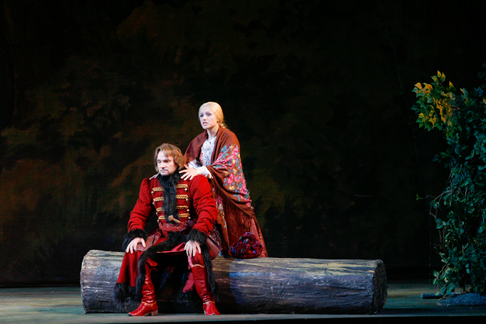 Viktor Lutsyuk as Mikhail Andreyevich Tucha, Tatiana Pavlovskaya as Princess Olga Yurievna Tokmakova
Viktor Lutsyuk as Mikhail Andreyevich Tucha, Tatiana Pavlovskaya as Princess Olga Yurievna Tokmakova
The opera calls for a bass with great vocal and dramatic charisma to sing Ivan the Terrible. The Tsar’s initial scene, for example, contains mostly sung recitative of constantly changing moods: a sarcastic aside is followed by an imperious command, a sudden moment of tenderness, a request for food, and an expression of world-weariness. Fyodor Chaliapin, whose self-portrait still hangs on the wall of a practice room at the Mariinsky, was legendary in the part. Though we have no recording, one can imagine how he must have savored its theatrical potential, turning on a kopeck to inflect each line differently, and projecting it to the back row of this very same hall.
Yet where have the great Russian basses gone? Consider Alexander Morozov, who sang the role as I heard it performed on 5 July. Not only is he no Chaliapin (who is?); he does not even possess a basic instrument in the same league as that of Vasily Gorshkov, who sang the Boyar Matuta with fluency, feeling and reasonable fullness of sound. A Tsar Ivan the Terrible who cannot vocally overpower a local boyar of Pskov not only sucks the life out the musical score, but makes nonsense of the dramatic proceedings. At times Morosov was completely inaudible from the ninth row over modest orchestral forces, and in the final scene he gave up, bawling and hamming instead.
Mariinsky insiders told me that Morozov was second-best, though his name was on the cast list from the start. (Perhaps Alexei Tanovitski would have been preferable, despite rumors of recent vocal troubles.) Music Director Valery Gergiev did cancel, which is a widespread problem in St. Petersburg. In La Traviata, for example, superstar Anna Netrebko was replaced as Violetta by the darkly passionate but uneven young Oxana Shilova, evidently taking with her Latvian tenor Aleksandrs Antonenko and again Music Director Gergiev. Is the economic crisis is sapping internationally active artists from the festival? Until this is sorted out, those contemplating a trip to the (so-called) Stars of the White Nights should beware!
Yet the problem of basses is clearly more fundamental. Many Russian opera administrators voice deep concern about the lack of basses up to the standards of their illustrious predecessors. Even if we leave Chaliapin out of it, one can track that decline in the role of Ivan the Terrible from the standard a half century ago (Aleksandr Pirogov in the 1947 Bolshoi recording of this opera and Boris Christoff in live recordings from the 1950s and 1960s) to what has been on offer more recently (Vladamir Ognovenko’s solid portrayal in Gergiev’s 1994 recording and the basses mentioned above). A chasm has opened up between what one hears in Orthodox churches and what one hears on a Russian opera stage. Until it is closed, it will be difficult to do full justice to this vital repertoire.
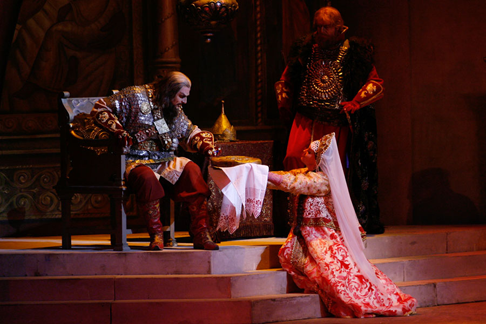 Alexei Tanovitski as Tsar Ivan Vasilievich, Varvara Solovyova as Boyarinya Stepanida Matuta (Styosha)
Alexei Tanovitski as Tsar Ivan Vasilievich, Varvara Solovyova as Boyarinya Stepanida Matuta (Styosha)
Despite the gaping vocal hole at its core, the Mariinsky production was most other respects enjoyable. Best of all was the old theater itself (so-called Mariinsky 1), which dates from 1860. It is not only lovely to behold, with gilded gold, straight-backed chairs and a pale blue-green painted ceiling. It is also—to judge from what we heard from Row 9—one of the most acoustically live and well-balanced opera houses in the world, with full, immediate and pin-point directional sound. The visceral experience of opera there bears no resemblance to brassy yet distant impact of opera in big halls like the Met and the Bastille (or even the newly opened Mariinsky 2), or even the somewhat less immediate impact of opera in other great houses, such as the Wiener Staatsoper or Covent Garden. While the orchestra under the young Finn Kalle Kuusava was sloppy at times, certainly lacking the punch Gergiev gives such works or the romantic sweep imparted by Simon Sakharov fifty years ago, it sounded vital in the hall.
The Mariinsky Maid of Pskov is a Fyodor Fedorovsky production dating from 1952 (refurbished by Yuri Laptev in 2008) and its staging of the cities and landscapes of old Russia reminds us how much color, romance, grandeur and realism traditional painted flats can offer. Diehard advocates of Regietheater would have been bored by the straightforward, almost fairy-tale, nostalgia, but the approach seemed to me just right for this excursion into medieval life. Moreover, flat and closed sets reflect sound well, adding to the hall’s acoustical glow.
Aside from Morosov’s weak and Gorshkov’s strong showing, the singers acquitted themselves competently. Maxim Aksenov possesses a strong, somewhat metallic tenor, with a more burnished tone at the top than the bottom—the right kind of voice for Mikhail Andreyevich Tucha, the romantic young defender of a city doomed to servitude. Soprano Svetlana Aksenovа, who sang Princess Olga Yurievna Tokmakova (the maid of Pskov), sang in the modern way: evenly, correctly, well-projected, slightly pushed, with a bit of Slavic steel in the voice, and without a great deal of feeling or character. Veteran mezzo Lyudmila Kanunnikova used a large voice and idiomatic style to advantage in her Act One cameo as the wet-nurse. The other princes, boyers and officials, notably Yuri Vorobiev, as well as the chorus, sang with virility. While none of this could be mistaken for the top-flight vocalism that can be heard at Glyndebourne, Salzburg or other top-tier summer festivals in Europe, the whole was more than the sum of the parts, due to the fine acoustic, superb diction, idiomatic delivery, and the sense that singers were performing a well-known work from their distinct tradition that could only be heard here.
The sense of being at a distinctively Russian occasion was reinforced by the audience—a crowd for which those who seek to expand the appeal of opera (think Peter Gelb and his PR minions at New York’s Metropolitan) could only wish. This Sunday-night performance was all but sold out, and the audience contained quite a number of common people of various ages, including numerous families with children. Listening to a tale from their own history, they—even an older gentleman next to us who smelled strongly of vodka—were well-behaved, attentive and responsive. The clear impression is that, from the perspective of audiences, Russian opera remains vital in the country of its origin. Now all we need are some great basses.
Andrew Moravcsik
Cast and production information:
Tsar Ivan Vasil’yevich (The Terrible): Alexander Morozov; Prince Yuri Ivanovich Tokmakov: Yuri Vorobiev; Boyar Nikita Matuta: Vasily Gorshkov; Prince Afanasy Vyazemsky: Mikhail Kolelishvili; Mikhail Andreyevich Tucha: Maxim Aksenov; Yushko Velebin: Alexander Nikitin; Princess Olga Yur’yevna Tokmakova: Svetlana Aksenovа; Boyarinya Stepanida Matuta: Varvara Solovyova; Vlasyevna: Lyudmila Kanunnikova; Perfilyevna: Svetlana Volkova; Malyuta Skutatov: Gennadt Borchenko; A Watchman’s Voice: Denis Begansky. Revival of the 1952 Production with sets and costumes by Fyodor Fedorovsky. Revival Stage Director: Yuri Laptev. Conductor: Kalle Kuusava. Mariinsky Theatre, St. Petersburg, Russia (5 July 2015).
image=http://www.operatoday.com/Maid_10.png image_description=Alexei Tanovitski as Tsar Ivan Vasilievich, Tatiana Pavlovskaya as Princess Olga Yurievna Tokmakova [Photos courtesy of Mariinsky Theatre] product=yes product_title=The Maid of Pskov (Pskovityanka) , St. Petersburg product_by=A review by Andrew Moravcsik product_id=Above: Alexei Tanovitski as Tsar Ivan Vasilievich, Tatiana Pavlovskaya as Princess Olga Yurievna Tokmakova [Photos courtesy of Mariinsky Theatre]Prom 11 — Grange Park Opera: Fiddler on the Roof
Perhaps this was a sign that I was in for an unusual evening: after all, it was Grange Park Opera’s first appearance at the Proms and the first time that Fiddler on the Roof — the 1964 Broadway hit by Jerry Bock (music) and Sheldon Harnick (lyrics), based on Yiddish tales by Sholem Aleichem — had been performed at the Proms. To add to the novelty, there was the casting of Welsh bass-baritone Bryn Terfel as the deep-thinking Russian dairyman, Tevye, who struggles to maintain his Jewish cultural traditions in the face of his daughters’ wishes to marry for love and the Tsar’s efforts to expel the Jews from the Anatevka shtetl in 1905.
But, then again, diversity of genres has become a staple feature of the Proms scheduling over recent years: European dance music, a ‘grime symphony’, Bollywood and bhangra music all feature this year. Moreover, opera companies are increasingly turning their attention to ‘popular’ repertoire which, one presumes, they hope will fill seats and win new audiences for opera (whether they are right or not is open to debate). Thus, Opera North will follow this season’s Carousel with Kiss Me Kate in 2015-16; at Welsh National Opera Sweeney Todd is scheduled for the autumn, hot on the heels of this summer’s production of Sondheim’s musical thriller at ENO. In the case of Grange Park Opera, they tested the waters ten or so years ago with productions of Anything Goes, Wonderful Town and South Pacific. This year, the opportunity to see a ‘star’ of Terfel’s calibre and renown may have tempted some of those who travelled to bucolic Hampshire in June to see director/designer Antony McDonald’s production of Fiddler at The Grange. Terfel’s certainly not new to the genre having shown his musical theatre calibre as the Demon Barber in several productions since 2007. So, maybe this was ‘first’ was simply a sign of the times rather than a revolution.
I’ll get my major criticism out of the way first. Not surprisingly, and perhaps necessarily, the performance was amplified; but, either the engineers seriously misjudged the volume level or the singers’ unfamiliarity with the venue led them to fear inaudibility, because the amplification was simply too loud. Ear-splittingly so at the start. I assume adjustments were made, or perhaps the singers adapted — because things did improve and were markedly better after the interval.
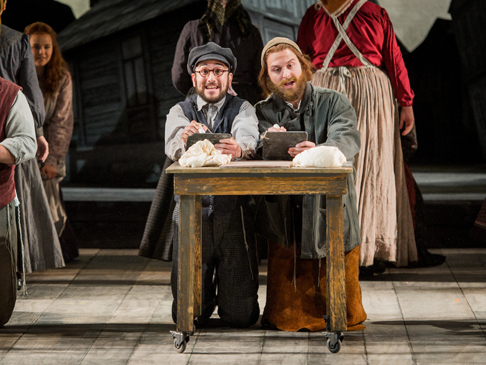
Terfel himself must take some of the blame. In contrast to his fellow performers with their light-weight music theatre voices, his Wagnerian bass-baritone can undoubtedly swell to the far reaches of the vast auditorium unassisted Yet, he boomed the opening dialogue, completely obliterating the solo Fiddler perched in the organ loft (a somewhat dishevelled and melancholy Houcheng Kian, who played suavely and linked the scenes effectively, but who, except when he was front of stage, might have benefited from some magnification himself), and encouraging the chorus members to strive to match his thunder. It would have been an exciting opening but for the painful rattling of my ear-drums. Perhaps if I was a habitual rave or gig attendee I’d have had no objection. Fortunately, things did improve but throughout the performance spoken text in particular was frequently yelled, sometimes at the expense of emotional intimacy between the characters on stage.
With that complaint out of the way, I should say that this was an absorbing and highly entertaining evening, one in which Terfel perhaps inevitably outshone his fellow cast members vocally, although there were some strong performances. Dressed in his milkman’s apron, lamenting the changes that were sweeping away heritage and homeland, but relishing a wedding knees-up, Terfel looked utterly at home in the role. The sung text was crystal clear, with a relaxed sense of rhythmic give-and-take which showed a natural feeling for the idiom.
Reviewing Terfel’s first essay as Dulcamara in the revival of Laurent Pelly’s production of Donizetti’s L’elisir d’amore at the ROH last November, I expressed admiration for his comic judgement and pacing. I had feared that he would over-egg the sleaze and slap-stick but the bass-baritone showed discernment and imagination: his Dulcamara had seemed to be a ruthless conman with little care for his victims or his own personal hygiene but later revealed himself as a mischievous charmer with twinkling charisma. It was a winning transformation. Here, too, Terfel balanced worldly authority with familial warmth: his temper may have been quick to spark but it was just as readily tempered by love and reflection.
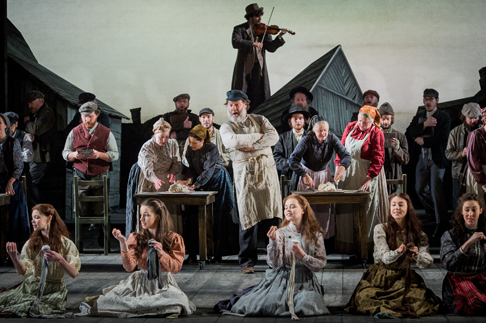
The big numbers all come early in the show. ‘If I were a rich man’ may have been a trifle stentorian in places — as Terfel stood like an imperious Wotan, each foot atop a milk churn — but he used his voice intelligently and during the evening conveyed touching, diverse emotions. And, there were more intimate moments, as in his lovely duet, ‘Do you love me?’ with Janet Fullerlove’s Golde; although there was some vocal mismatch in terms of timbre and projection, there was convincing feeling, and Fullerlove demonstrated her neat comic timing, deftly and wryly denying he husband a kiss in the song’s final moments.
Charlotte Harwood was a characterful Tzeitel, Tevye’s eldest daughter, and her scenes with Anthony Flaum’s Motel, the tailor who convinces Tevye to give both his blessing and his permission to their marriage, were touching. Flaum’s strong singing and responsive acting made him an appealing presence. Katie Hall sang Hodel’s ‘Far From the Home I Love’ sweetly and without affectation, abandoning the nasal twang and exaggerated American accent which had marred some of her earlier numbers (exacerbated by the miking — and, she was not alone in this regard); as her beloved, Simon Pollard was a dynamic Perchik. The more tentative sentiments of Molly Lynch (Chava) and Craig Fletcher (Fyedka) complemented the older pairings nicely. Rebecca Wheatley was the busybody matchmaker Yente, with a tendency to shriek her dialogue; Cameron Blakely proved nimble of voice and footwork as the butcher, Lazar Wolf, who believes he has won his dream bride only to be denied by Tevye in the face of Tzeitel’s sincere entreaty
Much of the driving momentum of the work comes from its wonderful ensemble set-pieces. The GPO Chorus sang with gusto and mastered the complex, inventive choreography (Lucy Burge) with aplomb. Even more impressive were the Cossack-leaps, bottle-balancing routines and wild whirlings of the dancers. The BBC Concert Orchestra, seated behind the performers, gave a sparkling reading of the score. They seemed to be having fun rendering the rich orchestrations, guided by nimble direction from conductor David Charles Abell.
The semi-staging was simple but serviceable — a few tables on wheels, assorted chairs and beds, and a fine chuppah for the matrimonial ceremony. The musical is somewhat imbalanced: the best-known numbers and the most up-beat ensembles are clustered into the long first part, with the emotional barometer swinging from festive to forlorn after the interval, as Tevye and his community face a battle for survive at home or uncertainty in the ‘promised land’ of America. It’s probably not the fault of McDonald, stage director Peter Relton, or the performers that the ending felt somewhat rushed, with the pathos of the uncertain ending not fully conveyed.
Though Terfel received a rapturous reception at the curtain call, he seemed keen to insist this was an ensemble performance, taking his place among the ranks despite the Prommers’ wish to laud his individual triumph. But, at the final reckoning it was Terfel’s vocal expertise and allure, and his stage magnetism, which made this such a heart-warming evening.
Claire Seymour
Cast and production information:
Tevye: Bryn Terfel, Golde: Janet Fullerlove, Tzeitel: Charlotte Harwood, Hodel: Katie Hall, Chava: Molly Lynch, Yente: Rebecca Wheatley, Motel: Anthony Flaum, Perchik: Jordan Pollard, Lazar Wolf: Cameron Blakely, Constable: Mark Heenehan, Fyedka: Craig Fletcher, Fiddler: Houcheng Kian; Conductor: David Charles Abell, Stage director: Peter Relton (based on the production by Antony McDonald), Choreographer: Lucy Burge, Costume designer, Gabrelle Dalton, BBC Concert Orchestra, Grange Park Opera Chorus. BBC Proms, Royal Albert Hall, London, Saturday 25th July 2015.
image=http://www.operatoday.com/GPO_FiddlerOnTheRoof_2015_Robert_Workman_001.png image_description=Bryn Terfel as Tevye [Photo © Robert Workman] product=yes product_title=Prom 11 — Grange Park Opera: Fiddler on the Roof product_by=A review by Claire Seymour product_id=Above: Bryn Terfel as TevyePhotos © Robert Workman
July 24, 2015
Saul, Glyndebourne
Barrie Kosky‘s much anticipated new production of Handel’s Saul opened at the Glyndebourne Festival on 23 July 2015, Kosky’s debut at the house and their first production of Saul. Though not an opera and never intended for the stage, Handel’s oratorio Saul is one of his most dramatic works and Kosky created from it a remarkable piece of theatre. A strong cast was led byChristopher Purves as Saul, andIestyn Davies as David, withLucy Crowe as Merab,Sophie Bevan as Michal,Paul Appleby as Jonathan, John Graham-Hall as the Witch of Endor and Benjamin Hulett as Abner, High Priest and Amalekite.Ivor Bolton directed the Orchestra of the Age of Enlightenment from the harpsichord. Designs were by Katrin Lea Tag, with choreography by Otto Pichler, and lighting by Joachim Klein.
Handel’s oratorio Saul was premiered in London in 1739. It has a libretto by Charles Jennens, who not only wrote the libretto for Messiah but was responsible for some of Handel’s most remarkable dramatic oratorios. The piece was intended as theatre of the mind, though premiered in the theatre it was performed in concert but Handel’s scores include stage directions clearly indicating the way his mind worked in these circumstances. What a piece like Saul gave him was a sense of real narrative clarity, this was a story everyone knew and which had a clear development from beginning, middle to end, very different from the convoluted scene based drama of the opera seria, where it was the effect of individual scenes which mattered rather than the (sometimes ludicrous) progression from scene to scene. Handel’s response was a dramatic meditation on the story, sometimes action proceeds at lightening pace (in the Glyndebourne programme book Barrie Kosky talks of the way, freed from da capo arias, Handel sometimes write music of extraordinary concision), but then there will be a long chorus when the action is frozen and the chorus almost steps out of the drama to consider it, and talk about it to us.
This gives the director remarkable freedom, there is a lack of specificity about the dramaturgy which can be filled in many ways. Of course, there are problems; you have to find something to do during the long choruses with all those singers on stage, and something which has a dramatic coherence and does not look like decoration merely added in. In 2012 I saw two very different stagings of Handel’s Jephtha (Frederic Wake Walker’s at the Buxton Festival, and Katie Mitchell’s at WNO) which showed quite how responses to the drama could vary.
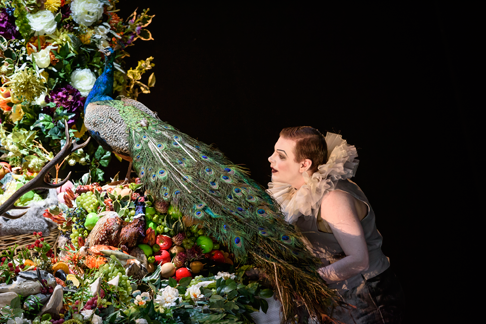 Benjamin Hulett as the High Priest
Benjamin Hulett as the High Priest
If I say that Barrie Kosky had clearly listened to Handel’s music and created a piece of theatre based on it, then that is intended as a great compliment as too often I get the impression that directors stage the libretto rather than the musical drama. Kosky, designer Katrin Lea Tag and choreographer Otto Pichler created a semi-abstract, coherently thought through response to the music. Kosky and Ivor Bolton drew some remarkable performances from the singers and players. One of the themes that Kosky identified in the piece, which his staging brought out strongly, was the King Lear like resonances with a King who goes mad, and two warring daughters. Kosky had increased these resonances by conflating the small roles of Abner, the High Priest and the Amalekite into a single fool-like role.
I say advisedly that this was a remarkable piece of theatre because though Handel’s score was at the very core of the piece, Kosky had added two elements to it which gave the staging some of its specificity (and added the Marmite element too, you either loved or hated it with little in between).
First the sound, the whole piece had an extra aural sound-track ranging from the whoops and cries of the chorus, through the communal thumpings, bangings and shoutings, to the shouted extra dialogue and Saul’s ravings. Some of this was a response to the drama going on in counter-point to the music, for instance when Saul presented Merab to David she was furious and Saul and Merab had an encounter which, not in the score, was performed in dumb-show but with the odd sound which intruded on the music. Also, there were many moments when you felt that Kosky did not find Handel’s music quite enough, and needed to add something. The results added up to an extra aural component which was present enough for me to find unsatisfactory and disturbing. If you listen to a radio broadcast of the performance then you are likely to find it slightly strange at times.
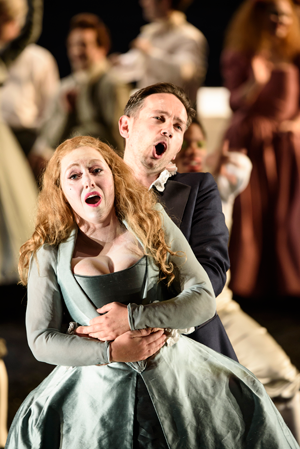 Sophie Bevan as Michal and Iestyn Davies as David
Sophie Bevan as Michal and Iestyn Davies as David
The second element was visual, dance played a large part in the whole performance. There were six dancers who made a strong element to the overall drama. But Otto Pichler’s choreography extended to the singers too so that whatever you thought of his visual language, he and Kosky had folded movement into the whole ensemble rather than just adding a couple of dancers for window dressing. Like everything else in the production, this was the result of strong, thoughtful decisions which I appreciated. Unfortunately, I did not respond to Otto Pichler’s visual vocabulary and found the dance element neither expressive nor stimulating, feeling that his perky, energetic choreography rather trivialised the music.
The evening opened with a series of visual coups. First the overture was played with the curtain down, with just a huge bloody head of Goliath visible, definitely a big plus point. Then as the curtain opened we saw Iestyn Davies as David, stripped to the waist, bloodied and clearly traumatised, then suddenly the rear curtain rose to reveal a huge table set for a feast (like the 16th century Dutch still life printed in the programme book), on which the chorus was sitting and standing. For the opening sequence the chorus moved, in stylised way on this table and then the ensemble developed with the dancers coming on. Costumes were neo-baroque, creating an exotic, slightly a-historical feel and in the huge wigs and overdone white make-up, creating a sense of parody too.
The whole piece took place in this space, with it plain walls and the floor of artificial earth (clearly this season’s must-have for directors, following on from Covent Garden’s recent production of Rossini’s Guillaume Tell). The dinner interval was after the Act Two duet for David and Michal (O fairest of ten thousand fair) and its subsequent chorus. The second half opened the symphony and formed a clear divide with the second part as the dark part, opening in darkness with a field of candles and with the performers now dressed in black.
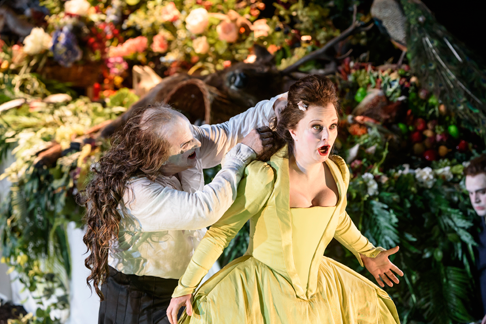 Christopher Purves as Saul and Lucy Crowe as Merab
Christopher Purves as Saul and Lucy Crowe as Merab
Though the visual language for the production was strong and pervasive, and at times I found it to be hyper-active, Kosky was responding to the music and when demanded gave us simplicity. David’s singing of his aria to sooth Saul, and then quietly cradling him whilst the harp played, or the Dead March performed with a stage strewn with bodies but no other accompanying action. And whatever you thought about the visual language, Kosky drew some truly remarkable performances from his cast.
Christopher Purves’ account of the title role was truly Lear-like, as he depicted Saul’s complete descent into madness. The occasional mad episodes in the first part turning into complete ravings in the second. It was a truly fearsome and mesmerising performance, and Purves was gripping in his singing of Handel’s music (Saul hardly gets a proper aria, the role is almost all recitative and arioso). But the performance came at some cost to the music, as Purves created the sense of madness by distorting the vocal line (thankfully only occasionally), and by adding extra spoken contributions to create intense theatre.
Iestyn Davies as David was slightly cool, calm and unreadable. He started with David traumatised and shell shocked, and there was a sense in which the character took most of the piece to recover from the opening drama with Goliath. This was counter-parted by the cool beauty of Davies’ singing and his account of O King, whose mercies are numberless was one of the highlights of the evening. But David’s character is also puzzling because of the dramaturgy of the piece, as he develops strong relationships with both Jonathan and with Michal. Kosky’s production gave a clear sexual element to the relationship with Jonathan (with the two in a steamy clinch at one point), but offered little in the way of explanation except to suggest that David was an opportunist schemer. But the beauty and intelligence of Iestyn Davies performance helped to bring the role alive in multiple ways.
Lucy Crowe made Merab a far more interesting character than can sometimes happen, and Crowe’s plangent tones, thrilling and beautiful yet extremely calculated, meant that even when at her most vicious we responded to Merab in a way. The bleached plangency and technical perfection of Crowe’s performance of Merab’s music ensured that the contrast with the two sisters was played up as Sophie Bevan’s Michal was all bubbly, running-around excitement. From the first moment Bevan set eyes on Davies, it was clear that Michal was obsessed with David and Bevan really brought this over. She was a complete delight in the arias, bringing a real sense of charm.
The young American lyric tenor, Paul Appleby was new to me. He brought a strong sense of interior drama to Jonathan, he too was very taken with Iestyn Davies’ David from the first moment and their relationship was developed and played out very clearly. In that sense he made a fine component to the drama, but Jonathan is perhaps an underwritten role and Appleby did not manage to make the music really count. He sang effectively, but without the specificity of the other performers and I have to confess that I found his phrasing a bit lumpy at times.
Benjamin Hulett was truly brilliant as the new fool-like character, welding his sequence of almost random arias into a clear role and having an omnipresent theatrical effect which gave a strong counterpoint to the drama. We never did work out why he was given artificially large bare feet (we have to assume that Hulett’s real toes are not that size!), perhaps to give a sense that this is a Pan-like observer and commentator. His interventions, and arias sung to the audience brought a real feel of extra commentary to the drama and his music performance was spot on and certainly showed him ready to take on larger roles.
Thankfully the role of the Witch of Endor was cast with a man, as it should be, and John Graham-Hall brought a wealth of experience to the role. Kosky seems to have seen the scene in Lear-like blasted heath terms. By now Christopher Purves’ Saul was stripped to his boxer shorts and John Graham-Hall’s witch appeared out of the ground and was an old crone also stripped to the waist with huge pendulous breasts on which Saul sucked, and the voice of Samuel spoke through Saul so that Purves sang both roles. It created an incredible piece of theatre from what is one of the strongest scenes in the oratorio.
The hard working chorus was amazing, singing Handel’s taxing, large-scale choruses with both strength and expressiveness. For the more serious ones, such as the big jealously on, their range of movement was restricted as Kosky clearly wanted us to concentrate on the music and there was a great deal to enjoy. For the livelier choruses in Act One we were treated to the sight of them dancing and singing, and this did on occasion cause some instability in the ensemble, but overall this was a powerful, strongly sung account of one of Handel’s finest oratorio choruses. Daniel Shelvey from the chorus took the small role of Doeg.
The organ solo in the symphony which opened part two was performed by James McVinne, on-stage and costumed playing a chamber organ on a platform spinning round in the midst of the field of candles - just one of the visual images which was inexplicable yet stunning. In the pit the Orchestra of the Age of Enlightenment, with continuo from Luise Buchberger (cello), Chi-Chi Nwanoku (bass), Paula Chateauneuf (theorbo), Luke Green (harpsichord) and Bernard Robertson (organ), were directed from the harpsichord with aplomb by Ivor Bolton. He drew strong, characterful playing from the orchestra and the work gave plenty of scope for individuals to shine, but also clearly gloried in the varied sounds of Handel’s orchestra.
Barrie Kosky has a very distinctive theatrical language and the big virtue of his production of Handel’s Saul was the way he used it unashamedly but always expressively. The first night audience at Glyndebourne reacted extremely positively, and clearly enjoyed some of the elements (such as the dancing) which I found more disturbing. This was a truly memorable event, as Kosky and his collaborators and cast had created a strong theatrical event, really bringing Handel’s theatre of the mind to life on stage.
Robert Hugill
Cast and production information:
Saul:Christopher Purves, David: Iestyn Davies, Merab: Lucy Crowe, Michal: Sophie Bevan, Jonathan: Paul Appleby, Abner/High Priest/Amalekite Benjamin Hulett, Doeg: Daniel Shelvey, Witch of Endor: John Graham-Hall. Director: Barrie Kosky, designer: Katrin Lea Tag, choreographer: Otto Pichler, lighting: Joachim Klein. Conductor: Ivor Bolton, Orchestra of the Age of Enlightenment; Glyndebourne Festival Opera, 23 July 2015.
image=http://www.operatoday.com/%C2%A9BC20150718_SAUL_147.png image_description=Christopher Purves as Saul [Photo by Bill Cooper] product=yes product_title=Saul, Glyndebourne product_by=A review by Robert Hugill product_id=Above: Christopher Purves as SaulPhotos by Bill Cooper
Roberta Invernizzi, Wigmore Hall
‘Here’ was Verona, just one of the Italian cities — Venice, Milan, Pavia, Rome and Mantua among others — in which Vivaldi had, since the performance of his opera Ottone in Villa in Vicenza in 1713, built ‘my name and reputation throughout Europe having composed ninety-four operas’, as he puts it in another letter, of 1739.
After his death, Vivaldi’s popularity waned; even the perennial concerti and instrumental works were little-known before the revival of interest in the composer’s music at the start of the 20th century. In recent years, that interest has stretched to his operatic oeuvre and around 50 operas have been rediscovered (some of the 94 mentioned were probably pasticci); there have been acclaimed performances and recordings by artists such as Cecilia Bartoli and Europa Galante, and by Roberta Invernizzi and La Risonanza (directed by Fabio Bonizzoni) who in 2012 released a CD of arias by Vivaldi (Glossa GCD922901).
This concert at the Wigmore Hall paired Vivaldi with Handel: a sort of operatic head-to-head. The programme was well-planned: each half focused on the vocal work of one composer, a selection of arias framing an instrumental work by the other composer. The arias themselves formed a sequence of contrasting moods and affekts, almost like movements of a symphony.
Invernizzi’s strengths were immediately on display in the opening aria, ‘Da due venti’ from Vivaldi’s Ercole su’l Termodonte, a fiery number in which Hippolyte, sister of the Queen of the man-hating Amazons, despairs in confusion having fallen in love with a man. Utterly committed to the drama, animated in delivery, Invernizzi has a real feeling for character and her portrayal of Hippolyte’s distress was visceral and intense. Her soprano has a thrilling glossiness and radiance; it is an immensely agile and she used it flamboyantly in the fierce fioiriture and wide leaps which conjure the ‘sea agitated by two winds’ to which Hippolyte compares her heart.
However, here and throughout the evening, vivid theatrical intensity was sometimes acquired at the expense of musical accuracy. Invernizzi employed a wide, weighty vibrato which — whatever one argues about ‘authenticity’ — adversely affected her control of pitch, and upper notes were repeatedly approached from below. In the slower numbers particularly, she struggled to shape the line: she tended to slide between notes rather than create a clean line, and there were some ungainly and distracting swells which tempered her bright, clean sound with a rather whiny edge. Her manner of performance could also be diverting: singing from the score in the Vivaldi-focused first half, Invernizzi whipped through the pages (presumably she was using an orchestral score rather than a vocal score) at great pace and with extravagant gestures, creating a great flapping and rustling, particularly as she raced back to the opening page for the da capo repeat.
‘Ombre vane, ingiusti orrori’ from Griselda was more reliable and show-cased Invernizzi’s rich tone and vocal intensity. There was an unearthly quality to the singer’s unaccompanied declamation, ‘Empty shades, iniquitous horrors’ as Constanza, Griselda’s daughter, expresses her fears, and also greater fluidity of line; the soprano’s strong, burnished lowered register was in evidence when Constanza cries in horror at the cruelty of fate. Problems of intonation and phrasing returned, however, in ‘Se mai senti spirarti’ from Cantone in Utica, where the tuning of the octave leaps was often approximate and where there was poor control of line. This is a ravishing aria of seduction, in which Caesar declares his passion for his enemy’s daughter, but the evenness and mellowness required were lacking, which was a pity as the muted violins and lone pizzicato viola of the accompaniment were deeply atmospheric.
The final Vivaldi aria, ‘Rete, lacci e strali adopra’, from Dorilla in Tempe made for a more confident and satisfying conclusion to the first half of the programme. Invernizzi’s coruscating soprano powerfully captured Filindo’s anger and frustration as, rejected by Eudamia, he compares his pursuit to a futile hunt. Here, the coloratura was both vivid and well-controlled; the soprano raced fierily through the wide-ranging scales, arpeggios and melismas with heroic fury and brilliance.
My reservations continued after the interval in the three Handel arias presented. ‘Piangerò la sorte mia’ from Guilio Cesare (in which Cleopatra laments losing both the battle against her brother Tolomeo and her beloved Caesar) suffered from a mannered emphasis on particular notes which disrupted the line, affected the tuning and thus weakened the dramatic intensity — although, as in the Vivaldi pieces heard earlier, the agitated ‘b’ section showed Invernizzi’s suppleness. Rodelinda’s expression of rhapsodic joy and longing for her husband, ‘Ritorna, o caro’, achieved a more tender simplicity and refinement. And, Invernizzi came into her own in the final aria, ‘Da tempeste’ from Guilio Cesare, conjuring great excitement as Cleopatra celebrates her liberation by Caesar from the clutches of Tolomeo and anticipates the victory that is sure to follow. Again, the soprano negotiated the coloratura with impressive agility and athleticism, and theatrical flair, and she used dynamics judiciously to shape the structure of the whole. Interestingly, Invernizzi stepped back from the music stand for this aria and, singing from memory, she seemed altogether more at ease.
La Risonanza, directed with verve and precision by Fabio Bonizzoni, were exemplary accompanists. Bonizzoni kept the pace pulsing and the strings alert, and his pounding continuo was invigorating. The players were attentive to every detail and played, by turns, with tremendous vigour and panache, and with grace and sensitivity. The string tone in the two instrumental interludes was beguiling. Handel’s Overture to Rodrigo was full-toned, but still airy and light, and was enhanced by lovely solos from leader Carlo Lazzaroni. String flourishes and florid ornaments were meticulously executed in Vivaldi’s Sinfonia to Dorilla in Tempe.
There were two splendid Vivaldi encores — from Ottone in Villa and the oratorio Juditha triumphans — in which Invernizzi seemed more relaxed. In the former, she at last found a floating, pure line of immense beauty. But, this fine ending to the recital could not quite dispel all my misgivings.
Claire Seymour
Performers and programme:
Roberta Invernizzi, soprano
La Risonanza: Fabio Bonizzoni (director, harpsichord); Carlo Lazzaroni, Laura Cavazzuti, Silvia Colli, Claudia Combs, Ulrike Slowik and Rossella Borsoni (violins); Livia Baldi (viola); Caterina dell’Agnello (cello); Vanni Moretto (double bass).
Vivaldi: Ercole su’l Termodonte RV710, ‘Da due venti’; Griselda RV718, ‘Ombre vane, ingiusti orrori’; Handel: Overture from Rodrigo HWV5; Vivaldi: Catone in Utica RV705, ‘Se mai senti spirarti sul volto’; Dorilla in Tempe RV709, ‘Rete, lacci e strali adopra’; Handel: Giulio Cesare in Egitto HWV17 ‘Piangerò la sorte mia’; Vivaldi: Dorilla in Tempe RV709, Sinfonia; Handel: Rodelinda HWV19, ‘Ritorna, o caro e dolce mio tesoro’; Giulio Cesare in Egitto HWV17, ‘Da tempeste il legno infranto’.
Wigmore Hall, London, Tuesday 21st July 2015.
image=http://www.operatoday.com/Roberta-Invernizzi-credit-Ribaltaluce-Studio-3.png image_description=Roberta Invernizzi [Photo by RibaltaLuce Studio] product=yes product_title=Roberta Invernizzi, Wigmore Hall product_by=A review by Claire Seymour product_id=Above: Roberta Invernizzi [Photo by RibaltaLuce Studio]July 23, 2015
Apotheosis Opera to Stage Tannhäuser
The cast of 35 will be lead by NICHOLAS SIMPSON (Die Tote Stadt, Silent Night, Opportunity Makes the Theif) as Tannhäuser, AMBER SMOKE (Die Walküre, La Clemenza di Tito, Threepenny Opera) as Elisabeth, and JODI KAREM (Santuzza, Vesperae solennes de confessore, Requiem) as Venus. The production will feature a full orchestra lead by MATTHEW JENKINS JAROSZEWICZ (Flight, Gianni Schicchi, Suor Angelica), who is also the Artistic Director of Apotheosis. Jaroszewicz will serve as director, musical director, and conductor, with choreography by MAAYAN VOSS DE BETTANCOURT, scenic design by GALEN KIRKPATRICK, and costume design by NED CHRISTENSEN.
TANNHÄUSER is a unique and powerful dramatic opera in three acts with music and text by Richard Wagner. History and myth collide in Wagner’s renowned early masterpiece, which is set in 13th century Germany and based on the German legends of a real Minnesinger and his relationships with the goddess Venus and a pure young maiden.
Tickets are available for $15, $25, and $45, and can be purchased at tannhauser2015.org.
APOTHEOSIS OPERA seeks to bring fresh energy into the New York opera scene by connecting new performers with new audiences. They create affordable, fully-staged, English-language productions of large-scale works to make opera more accessible to a wider audience. Opera is hot when its stars shine brightly and Apotheosis productions give some of New York’s most talented young performers the game-changing opportunity to sing big roles for the first time. The upcoming production of Tannhäuser will largely feature college students, recent graduates, and other emerging artists in its cast and creative team.
Website: http://www.tannhauser2015.org/
image=http://www.operatoday.com/Rehearsal-with-full-vocal-personnel%2C-7.15-4.png image_description=Apotheosis Opera rehearsal photo product=yes product_title=Apotheosis Opera to Stage Tannhäuser product_by=Press release by Apotheosis Opera product_id=Above: Rehearsal photoMontemezzi: L’amore dei tre Re
In Prokofiev’s Love for Three Oranges the King of Clubs, the ruler of an imaginary kingdom, tries to cure his son’s hypochondria with laughter. In Montemezzi’s vicious melodrama a blind king, Archibaldo menacingly guards his son’s wife from her former lover: there is none of Prokofiev’s colour, fairy-tale and satire, just abundant black fiendishness and slaughter.
Written in 1913, L’amore dei tre Re is a rich amalgam of musical influences: Wagner, Debussy, Puccini and Strauss — and the soaring melodic lines also recall the bel canto idiom of the early nineteenth century. The libretto (by Sam Benelli, based on his play of the same title) bears the heavy imprint of both Pelléas and Mélisande andTristan und Isolde, with, in the closing moments, a dash of Romeo and Juliet thrown in. But, Montemezzi whips up a psychological maelstrom more than equal to any of his operatic predecessors — and, in a matter of only 95 minutes. It’s surging, heady stuff — but not without musical sophistication, as Opera Holland Park confirmed in this splendid revival of Martin Lloyd-Evans’s 2007 staging.
The action takes place in the blind King Archibaldo’s castle following his occupation of the kingdom of Altura. (Archibaldo alludes to the figure of Otto the Great, who was Saxon King from 936 and Holy Roman Emperor from 962 until his death in 973, and who greatly extended his kingdom and power through foreign invasions and strategic marriages, conquering the Kingdom of Italy in 961.)
Princess Fiora of Altura has been forcibly wed to Archibaldo’s son, Manfredo; with the latter away at war, Archibaldothreatens and imprisons Fiora to prevent her meeting with her former betrothed, Avito. Needless to say, love finds a way … and learning that Fiora has been unfaithful to Manfredo, the King demands the name of her lover. When she refuses he strangles her and then orders her body to be borne to a tomb. Convinced that the secret lover will be unable to resist bidding his beloved a final passionate farewell, Archibaldo laces Fiora’s lips with lethal venom. True to form, Avito does return; but so does Manfredo, and both lover and husband succumb to the poison’s virulent potency.
This neo-medieval verismo, in which the distance of the Dark Ages shrouds the violence in patina of mystery, reaches extremes of psychological melodrama and emotional tension. Director Martin Lloyd-Evans and designer Jamie Vartan make the sensible decision to ignore the medievalism and minimise the set. They place an imposing constructivist concrete block centre-stage, with sloping ramps spanning the wide platform, and perilous stairways creating upper levels. The latter are sensibly used to raise the singers above the enlarged, resplendent and myriad-voiced forces of the City of London Sinfonia who project the relentless score (an almost unalleviated forte or louder) with power and passion. The effect is a visual echo of the monochrome, gravity-defying stairways of Escher’s lithographs, where those who live among each other occupy different planes of existence.
There are few gimmicks but many nice details, as when Archibaldo’s attire becomes increasingly more military as if to demonstrate the growing strength of his dictatorial grip and his monomaniacal ruthlessness. The grey is relieved only occasionally; but tellingly, when Fiora’s white silk veil — which Manfredo has asked her to wave as a sign of her love as he departs — billows from the height of the staircase and is embraced by Avito on the ground below. After Fiora’s death this veil becomes a ribbon of black. The reference to Mélisande’s luxurious hair in which Pélleas is enveloped is obvious, but deft. And, to keep the historical context in our minds — both that of the medieval past and the era of post-unification Italy when the opera was composed — two chorus members daub the castle walls with name of the 1920s anti-fascist resistance movement: ‘Giustizia e Libertà’.
It was only at the end of the opera as the chorus stirred themselves to revolutionary action and Fiora lay on a hospital trolley draped with the tricolour bandiera d’Italia that the focus seemed to turn a little too far from the private towards the political. I wasn’t sure, either, whether in the closing moments it was necessary for the masses, led by Archibaldo’s Italian guard Flaminio, to actually pull the trigger on their oppressor: we are left with the echo of gun-shot rather than the pathos of a blind tyrant with a pistol poised at the back of his head. Moreover, Archibaldo’s assassination is a directorial addition. In the libretto, Archibaldo enters the tomb and, finding Manfredodesperately kissing the infected lips of Fiora, assumes that he has trapped the guilty lover. When he discovers the truth, he wraps his arms about the body of his dying son, and it is the sightless old King’s lament with which the opera ends: ‘Ah! Manfredo! Manfredo! Anehe tu, dunque, Senza rimedio sei con me nell’ombra! Manfredo! Manfredo!’ (Ah! Manfredo! You too, then, with no hope of remedy, are with me in the shadows!).
As the focus for the violent passion of the ‘three kings’ — Avito, Manfredo and Archibaldo — and the catalyst of the triple tragedy, Fiora is also the opera’s single female role. Natalya Romaniw was more than up to the challenges and walked off with the vocal honours, though there was strong competition. The smooth arches of Montemezzi’s languorous melodic lines were excellently projected with no sign of a lessening of stamina. Romaniw’s tone was thrilling and radiant: but she was able to capture both Fiora’s sensuousness and her more ethereal delicacy — for upon her death the male chorus ask: ‘Who makes the lily, which has now come fall! The spring was killed among the flowers!’ (‘Chi ci rende il giglio, che venuto è ormai l'autunno! La primavera fu uccisa tra i fiori!’)
Initially I was not entire convinced by the supposedly all-consuming desire of Fiora and Avito, despite the erotic embraces on stage. Joel Montero’s characterisation of Avito was slightly one-dimensional to begin with but he found a true Italianate sound of great sweetness in the Act 2 duet and later a heroic, noble ring. His closing monologue — ‘Fiora, Fiora. È silenzio: siamo soli.’ (Fiora, Fiora. All is silent, we are alone.) — was captivating. Overcome by emotion, this Avito seemed genuinely close to death when he staggered from the bitter Manfredo and asked, ‘What do you want? … Can you not see that I can scarcely speak?’ (‘Che vuoi tu? Ma non vedi ch'io non posso quasi parlare?’)
Simon Thorpe used his lyrical baritone particularly well in the calamitous final scene; his tone was well-focused, revealing Manfredo’s humanity. As the blind patriarch, the American-Russian bass Mikhail Svetlov, reprised his role from 2007. This was a terrifying, threatening but mesmerising portrait: Mussolini meets a demented Arkel. In Act 1, Svetlov’s generous, dark-toned voice was occasionally covered at the bottom by the orchestra — one of perils of an open pit — but whenever on stage Svetlov was never less than utterly commanding. His convincing depiction of a blind man showed real dramatic intelligence: his infirmity added poignancy but also malignancy to his assertions of power. He paced the portrayal well too: we can see from the start that Archibaldo is insanely fanatical, but Svetlov slowly released his repressed, self-destructive desire for Fiora. This toxic lust culminated in a chilling and ferocious throttling: Archibaldo slumped over Fiora’s body in post-coital exhaustion, then — when discovered by Manfredo — brusquely kicked her dead body aside. Aled Hall also recreated his 2007 role and was excellent as Flaminio, pushing what is a fairly minor role to the centre of the drama.
Under Peter Robinson’s baton, the City of London Sinfonia surged with turbo-thrust towards a perennial precipice, much like the protagonists’ pulsing heartbeats. The score stabbed like a sword, and the outré harmonies swerved unpredictably. But, despite the orchestral extravagance and extroversion, the details didn’t get lost in the impassioned outbursts.
L’amore dei tre Re is melodramatic and certainly not subtle. It wouldn’t take much for a staging to slip into the realms of caricature and farce, but this OHP production never strays near parody and as the sun set over South Kensington we were all enveloped by the growing darkness. It’s compelling stuff.
Claire Seymour
Cast and production information:
Fiora: Natalya Romaniw, Avito: Joel Montero, Manfredo: Simon Thorpe, Archibaldo: Mikhail Svetlov, Flaminio: Aled Hall, An Old Woman: Lindsay Bramley, Ancella: Jessica Eccleston, Una Giovanetta: Abigail Sudbury, Un Giovanetto: Timothy Langston, Una Vecchia: Lindsay Bramley, Voce Interna: Naomi Kilby; Conductor: Peter Robinson, Director: Martin Lloyd-Evans, Associate Director: Rodula Gaitanou, Designer: Jamie Vartan, Chorus Master: John Andrews. Opera Holland Park, Wednesday 22nd July 2013.
L’amore dei tre Re will be performed on 25, 28 and 30 July, and 1 August.
image=http://www.operatoday.com/FS-Lamore-e1420651990372.png image_description=L’amore dei tre Re at Opera Holland Park: product=yes product_title=Montemezzi: L’amore dei tre Re product_by=A review by Claire Seymour product_id=Above: L’amore dei tre Re at Opera Holland Park:Prom 4: Andris Nelsons
I could really find nothing about which to cavil at the orchestral performance. Andris Nelsons’s conducting, however, remained distinctly mixed in quality. He eschewed fashionable ideas concerning tempo and offered a refreshingly slow introduction. The main body of the Overture started intriguingly post-Mozartian fashion, seeming — surprisingly — to hint at The Marriage of Figaro. However, Rossini soon, bizarrely, seemed to supplant Mozart, and we found ourselves in the world of Toscanini. The Beethovenian weight of Klemperer was nowhere to be heard. If ‘Italianate’ Beethoven were your thing, you would probably have liked it more than I did.
John Woolrich’s Falling Down, ‘a capricho for double bassoon and orchestra’, followed. The solo part was taken by Margaret Cookhorn, the dedicatee of this piece, first performed by the same forces in 2009 as a CBSO commission. They all seemed to play it very well indeed; I wish I could have thought more of the work itself. A colourful, spiky, somewhat Stravinskian opening augured well, its material reappearing throughout the quarter of an hour or so. Some harmonies put me in mind a little of Prokofiev, and there was indeed, something of a balletic quality. Antiphonally placed timpani had an important role, well taken. But once one is past the interesting ‘experience’ of a concertante piece for contrabassoon, Falling Down seems, at best, over-extended. There is only so much it can do as a solo instrument but, more to the point, what soloist and orchestra do soon seems repetitive. I have responded much more readily to the composer’s Monteverdi reworkings.
The performance of the Ninth Symphony grew in stature, but I am afraid this was not — for me, although the audience in general seemed wildly enthusiastic — that elusive, compelling modern performance we all crave. Daniel Barenboim’s Proms performance in 2012 was nowhere challenged — not least since there was no doubt whatsoever in Barenboim’s performance that the work meant something, and something of crucial, undying importance at that. There was good news in the first movement. First, it was not taken absurdly fast; nor was it metronomic in its progress. And yet, despite the undoubted excellence of the CBSO’s playing, I found myself at a loss as to what the music in performance might actually mean. Too often, extreme dynamic contrasts — somewhat smoothed over by the notorious Albert Hall acoustic — seemed just that; why was a phrase played quite so softly? There was wonderful clarity, enabling woodwind lines not just to be heard, but to sing. What, however, were they singing about? There was real menace, though, in the coda, even if it seemed somewhat to have come from nowhere. Applause: really?!
The Scherzo was taken fast, very fast: nothing wrong with that. My chief reservation remained, however, and ultimately this was a smoothly ‘reliable’ performance rather than a revelation. Where were the anger, the vehemence, the human obstreperousness of Beethoven? Applause proves still less welcome here. The slow movement was taken at a convincing tempo, its hushed nobility, with especial thanks to euphonious woodwind, greatly welcome. I was less convinced that the metaphysical dots were joined up, or even, sometimes, noticed. Whatever my doubts, though, there was no denying the beauty of the playing (an intervention from an audience glass towards the close notwithstanding).
Nelsons forestalled applause, thank goodness, by moving immediately to the finale. He and the orchestra fairly sprung into and through its opening: very impressive on its own terms, although it would surely have hit home harder, had it been properly prepared by what had gone before. The cellos really dug into their strings too. Nelsons had them and the double basses paly deliciously softly for their recitative; now, a true sense of drama announced itself, expectant rather than merely soft. Bass-baritone Kostas Smoriginas delivered his ‘proper’ recitative, ‘O Freunde …’, with almost Sarastro-like sincerity and deliberation. I liked the way the rejection of such ‘Töne’ was no easy decision. The soloists as a whole did a good job; that there remains a multiplicity of options, and dare, I suggest, a residual insufficiency to any one quartet, says more about Beethoven’s strenuousness of vision and humility before his God than performance as such. The CBSO Chorus, singing from memory, was quite simply outstanding. Weight and clarity reinforced each other rather than proving, as so often, contradictory imperatives. Nelsons imparted an unusual sense of narrative propulsion, almost as if this were an opera, or at least an oratorio: I am not sure what I think of such a conception, but it was interesting to hear it, and there was no doubting now the conviction with which it was instantiated. The almost superhuman clarity of the chorus’s words — ‘Und der Cherub steht vor Gott!’ a fitting climax to that first section — certainly helped. It was fun, moreover, to be reminded of the contrabassoon immediately afterwards. (Was that the tenuous connection with the Woolrich piece?) The infectious quality to the ‘Turkish March’ brought with it welcome reminiscences of Die Entführung aus dem Serail. And the return to ‘Freude, schöner Götterfunken’ proved exultant in that deeply moving way that is Beethoven’s own. (If only the abuse of this work by the European Union had not had me think of the poor Greeks at this point — but, on second thoughts, that was probably a good thing too.) If only Nelsons could have started again, and reworked the meaning he seemed to find here into the earlier movements, especially the first two, we might have had a great performance. As it stood, there remained a good deal later on to have us think.
Mark Berry
Programme and performers:
Beethoven —The Creatures of Prometheus, op.43: Overture; Woolrich — Falling Down (London premiere); Beethoven — Symphony no.9 in D minor, op.125.
Margaret Cookhorn (contra-bassoon); Lucy Crowe (soprano); Gerhild Romberger (mezzo-soprano); Pavel Černoch (tenor); Kostas Smoriginas (bass-baritone); CBSO Chorus (chorus master: Simon Halsey)/City of Birmingham Symphony Orchestra/Andris Nelsons (conductor). Royal Albert Hall, London, Sunday 19 July 2015.
image=http://www.operatoday.com/andris-nelsons.png image_description=Andris Nelsons product=yes product_title=Prom 4: Andris Nelsons product_by=A review by Mark Berry product_id=Above: Andris NelsonsBBC Proms: The Cardinall’s Musick
There was a sell-out audience for this first Chamber Music Prom of the 2015 season, at the Cadogan Hall in South Kensington, and the early music specialists The Cardinall’s Musick, directed by Andrew Carwood, delighted with a compelling performance of Latin and English motets and anthems by Tallis.
Fittingly, the Cadogan Hall began its life as a church. Established in 1907 as a New Christian Science Church, a declining congregation led to its closure in 1996 but it was purchased by the Cadogan Estate in 2000 and re-furbished as a concert hall four year later. Careful attention was paid to the environmental and performance acoustic during the refurbishment; and, if the resonance is not quite equal to that of the Reformation churches and cathedrals in which Tallis’s sacred compositions were first heard, the Cardinall’s Musick sang with full tone which reverberated richly, as they illuminated the diversity of Tallis’s vocal textures. Noteworthy too was the way in which individual voices emerged from the polyphonic ensemble, as Carwood adeptly maintained an excellent balance between soloists and the collective. His fluid, easy direction allowed the contrapuntal forms to evolve organically while sustaining forward momentum. And, although the Hall seats 950 people, the ensemble managed to create a surprising intimacy, drawing the listener into the performance, the sensitivity and dignity of which reminded one of the original function of these compositions - to express and inspire devotion.
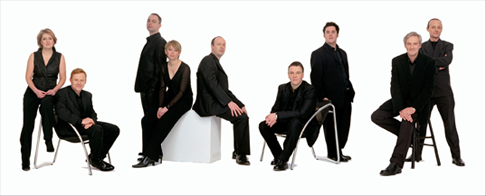 The Cardinall’s Musick
The Cardinall’s Musick
The opening work ‘Videte miraculum’ (the responsory for Candlemas) took a little while to settle, perhaps because of the strange dissonances which characterise its opening point of imitation and its frequent alternations between soloist, solo groupings and full choir. But, the emergence of the unadorned chants between the choral sections were expressive and the multi-voice responses created energy as parts of the chant were repeated, blossoming in tone. The motet ‘Suscipe quaeso’ developed from the solemnity of its narrow-compassed beginnings into a stunningly lavish, beautifully balanced rhetorical appeal, and the repeated questions of the second part were absorbingly insistent. Perhaps there might have been more emphasis placed on the metrical and harmonic oddities of the brief ‘O nata lux de lumine’, though the concluding phrase was characterised by a beautiful simplicity and glow. In the 5-part ‘O salutaris hostia’ the short melodic ideas developed with vitality. The passing of the imitative motifs from the highest voice to the lowest created a sense of expanse, as the text expressed hope of heavenly salvation, while the intricate appeals for strength in the face of earthly enemies and woes in the latter part of the motet were elucidated with clarity, building to invigorating repetitions of the final phrase. ‘O Sacrum Convivium’ was utterly compelling in the way that the close imitation built in intensity while still remaining airy and lucid.
There were English anthems too, beginning with the 4-part ‘O Lord, give thy holy spirit’. Here, I’d have liked a little more emphasis on the harmonic nuances which underscore the textual meaning. However, the consistency of tone and intonation in the opening section of ‘Hear the voice and prayer’ made for a powerful entreaty, while the more extended sequential imitation of the appeal ‘That thine eyes may be open toward this house’ and the elision into the final prayer, ‘And when thou hear’st, have mercy upon them’, was persuasive. ‘Why fum’th in fight?’ was one of the works that Tallis contributed to the Psalter prepared by the Archbishop of Canterbury, Matthew Parker, in 1567, but is better known today as the melody of the work it inspired: Vaughan Williams’s Fantasia on a Theme of Thomas Tallis. The Cardinall’s Musick made the text dramatic, blending their voices beautifully, and the modal harmonies were powerfully expressive, stripped of some of the sentimentality which can colour Vaughan Williams’s work.
Contrast and complement was provided by another composition inspired by Tallis. Though it takes its name from Thomas Wolsey (the Roman Catholic Cardinal and Lord Chancellor who rose to eminence during the reign of Henry VIII before falling from favour when he failed to satisfy the King’s political and matrimonial whims), the Cardinall’s Musick frequently turns its attention to music of its own day, and has given premieres of works by composer such as Michael Finnissy and Judith Weir. On this occasion it presented the premiere of Cheryl Frances-Hoad’s ‘From the Beginning of the World’, a composition for 8 voices which takes it text from the ‘German Treatise on the Great Comet of 1577’ by Tycho Brahe (1546-1601). Speaking in the Hall to BBC Proms presenter Petroc Trelawny, Frances-Hoad explained that she had looked for a text which was representative of Tallis’s age but also spoke to our own times: the Great Comet was interpreted as heralding an apocalypse, a sign of God’s displeasure at man’s sinfulness, but also as a sign of rebirth, an opportunity to repent: ‘It thus behoves us to use well our short life here on earth, So that we may praise him for all eternity’ - a message that Frances-Hoad suggested modern politicians, and indeed we all, might do well to remember.
The work pays obvious musical homage to Tallis, with its solo chant-like lines which bloom in melismatic and imitative expansion, its rhythmically complex and diverse responses to the English text, the use of the tritone to suggest the dark and satanic, and the employment of contrapuntal devices such as double canons. It is an exciting and grippingly dramatic work, with its combinations of Latin and English text, and constant re-calibrations of the vocal groupings with solo exclamations, ‘Peccavi’ - ‘I have sinned’ - and questions, ‘But what do such unnatural births mean?’, demanding our attention. There was also a strong sense of hope and regeneration, as with the suggestion that ‘Something new can be generated in the heavens’, a line in which strange, close dissonances expand in tessitura, blossoming in rich melisma and shimmering harmonies which stirringly evoke the celestial. The Cardinall’s Musick were more than equal to the significant technical challenges, as soloists and as an ensemble: the intonation in the several unison and octave passages was excellent. Carwood controlled the complexity and animation of the final phrases superbly, leading his singers to a swift but ecstatic close.
After such captivating and exciting text-setting, Tallis’s 40-voice motet for eight five-part choirs, ‘Spem in alium’, was a fitting conclusion to the concert. The supplemented forces of the Cardinall’s Musick found an incredible richness and variety of sonority: the sense of spatial expanse, the fullness of resonance, the homogeneity of vocal tone, the rhythmic tautness and the overall vivacity and eloquence were inspiring.
Claire Seymour
Programme and performers:
Tallis: ‘Videte miraculum’, ‘O Lord, give thy Holy Spirit’, ‘Hear the voice and prayer’, ‘Why fum'th in fight?’, ‘Suscipe quaeso’, ‘O nata lux de lumine’, ‘O sacrum convivium’, ‘O salutaris hostia’; Cheryl Frances-Hoad: ‘From the Beginning of the World’ (world premiere); Tallis: ‘Spem in alium’. The Cardinall’s Musick. Andrew Carwood, director. Cadogan Hall, London, Monday 20th July 2015. BBC Proms: Proms Chamber Music 1.
image=http://www.operatoday.com/Andrew_Carwood_Profile.png image_description=Andrew Carwood product=yes product_title=BBC Proms: The Cardinall’s Musick product_by=A review by Claire Seymour product_id=Above: Andrew CarwoodOperalia 2015
Captions indicated the singer’s name and aria title; images were projected onto the backdrop to set the ‘context’; rudimentary lighting weakly strove to establish mood. There were no surtitles. What was there to distinguish proceedings from one of Simon Cowell’s TV talent shows? Watching this conveyor belt of vocalists, I wondered why a young singer would put his or herself through a sort of operatic cattle-show which offered little chance to show one’s range and diversity or to achieve any ‘meaningful’ communication with the audience.
But, as Operalia’s founder Plácido Domingo remarks, even for the most gifted the world of professional opera is complex and challenging, and sometimes ‘very distressing to the point that sometimes a remarkable talent can pass by unnoticed’. Operalia was established in 1993 ‘to discover and help launch the careers of the best young opera singers’ — singers ranging from 18 to 32 years of age, of all voice tessituras and from every country in the world. And, it seems to be fulfilling its ambition to give vocal talent a leg-up, with singers such as Nina Stemme, Joyce DiDonato, Rolando Villazón, Erwin Schrott Brian Asawa, José Cura, Joseph Calleja, Ailyn Perez, Olga Peretyatko and Sonya Yoncheva coming to prominence at the competition in the early stages of their careers. Moreover, if the superficiality of this vocal parade was somewhat unedifying, then there was at least some compensation in that, having reached this final stage of the competition, all were in a sense winners — and that the contracts will not necessarily go to the official award recipients but to those who make an impression on, not only jury members such as Anthony Freud (General Director of the Lyric Opera of Chicago), Jonathan Friend (Artistic Administrator at the Metropolitan Opera), Joan Matabosch (Artistic Director at the Teatro Real in Madrid) and Jean-Louis Grinda (Director at the Opéra de Monte-Carlo), but also on other scouting impresarios and record producers.
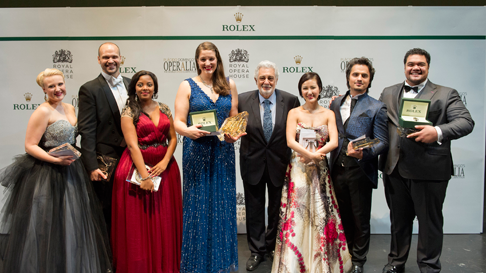 Placido Domingo with the winners of Operalia 2015
Placido Domingo with the winners of Operalia 2015
Previously held in various cities around the globe, the Operalia Finals reached London for the first time this year. After three days of preliminary rounds involving 40 contestants drawn from 21 countries, the 11 finalists gathered at the Royal Opera House for the concluding round. Each participant sings one aria, accompanied by the Orchestra of the Royal Opera House conducted by Domingo (the event was live-streamed by Medici TV). Born in Madrid to parents who were stars of the zarzuela, Domingo has also established a Zarzuela competition in honour of his parents and to encourage singers to work in this art form; 5 of the 11 singers also presented an aria in the Zarzuela competition.
Much clearly depends on the soloist’s choice of aria; somewhat disappointingly, but not surprisingly, all bar one of the singers selected from the French and Italian nineteenth-century repertoire. The exception chose Wagner.
And aria-choices did prove influential. The two First Prizes, for Best Male and Best Female Singer, went to Romanian tenor Ioan Hotea and Norwegian soprano Lise Davidsen. Davidsen had to wait until the end of the roll call to perform ‘Dich teure Halle’ from Tannhäuser but this clearly had no effect on her nerves, and she thrilled with a towering performance of majestic power and penetration. Her plush sound was pin-point accurate and her technical assurance unwavering, though it was rather a stand-and-deliver performance. Davidsen has made a habit of winning prizes of late, including the Léonie Sonning Music Prize, Danish Singers Award 2014 and the Kristin Flagstad Award 2015. She was also, just a couple of weeks ago, a triple winner at the 2015 Hans Gabor Belvedere Singing Competition in Amsterdam, where she picked up Second Prize as well as the Prize of the International Media and the Audience Prize. On this occasion, she also won the Audience Prize (a Rolex watch — courtesy of the sponsors) and the Birgit Nilsson Prize) for performances in German repertoire by Richard Strauss and Richard Wagner).
Hotea’s ‘Ah mes amis’ from La Fille du regiment confirmed both his courage and his ability to firmly nail the nine top-Cs. In Donizetti’s showpiece and in the Zarzuela competition — where his performance of Seranno’s ‘La roca fria del calvario’ from La Dolorosa won him his second First Prize of the evening — Hotea also used his bright shining tenor to engage the audience and convey role and situation, something which both of the American baritones participating, Edward Parks (who had the tough job of opening the competition and was awarded Third Prize) and Tobias Greenhalgh found more challenging in ‘Largo al factotum’ (Rossini, Il barbiere di Siviglia). New Zealand tenor Darren Pene Pati made a big impact with his honey-toned rendition of ‘Tombe degli avi miei’ from Lucia di Lammermoor: with his endearing, relaxed voice and engaging manner, Pene Pati was the foreseeable and worthy recipient of the Audience Prize for Best Male Singer.
The remaining male participants, French tenor Julien Behr — who sang Gounod’s ‘Salut! Demeure chaste et pure’ from Faust with charm but without strong impact — and South-African bass-baritone Bongani Justice Kubheka — who struggled with some of the upper notes in ‘La calumnia’ (Il barbiere) and occasionally lost his grip on the orchestral safety-reins (though Domingo was not particularly helpful to his singers) — did not quite have the necessary technical arsenal at their disposal.
Among the female competitors, Australian Kiandra Howarth (who as a Jette Parker Young Artist is familiar with the Covent Garden stage) impressed with an impassioned rendition of ‘Amour, ranime mon courage’ (Gounod, Faust) showing the diverse colours of her soprano; Howarth was awarded the Culturarte Prize (chosen and offered by Bertita and Guillermo Martinez from CulturArte de Puerto Rico). American soprano Andrea Carroll was persuasive in the Zarzuela round, giving a vivid performance of ‘Al pensar en el dueño de mis amores’ (Chapi, Las hijas de Zebedeo) after a slightly nervous ‘Qui la voce’ (Bellini, Il Puritani) in the main competition. Noluvuyiso Mpofo from South Africa held my attention in ‘É strano, è strano … Sempre libera’ (Verdi, La Traviata) and was awarded Third Prize.
In ‘Il dolce suono’ from Donizetti’s Lucia Korean Hyesang Park revealed a sparkling soprano more than capable of scaling the coloratura heights; she worked hard to establish character too, though I found her posing and gesturing rather mannered — particularly so in the zarzuela ‘No sé que siento aqui’ (Fernández Caballero, Château Margaux). Hyesang Park carried off both Second Prize and the Zarzuela prize, but I could not understand why she was permitted to perform the whole of Donizetti’s mad scene, cabaletta and all, which at 20 minutes or so gave her a platform equal to that of all four preceding participants combined, and thus the opportunity to show her vocal diversity. If there is no rule on the length of aria, then perhaps there should be.
Claire Seymour
image=http://www.operatoday.com/Placido-Domingo%2C-Lise-Davidsen-and-Ioan-Hotea_%28c%29-Alastair-Muir.png image_description=Placido Domingo, Lise Davidsen and Ioan Hotea [Photo by Alastair Muir] product=yes product_title=Operalia 2015 product_by=By Claire Seymour product_id=Above: Placido Domingo, Lise Davidsen and Ioan HoteaPhotos by Alastair Muir
July 21, 2015
Oberon, Persephone and Iolanta at the Aix Festival
A far cry from Christopher Alden’s controversial 2012 Midsummer Night’s Dream at the ENO where 0beron is the headmaster of a boys school and Theseus is his former lover, Robert Carsen’s 1991 production of Le Songe d’une nuit d’été for the Aix Festival floats high above the sexual and social complexities of Shakespeare’s raciest play.
The Carsen production however has become a classic because of the simplicity of its exposition, the intellectual innocence of its concept and the maximal minimalism of its execution. Thus twenty-five years later the Aix Festival has brought this splendid production back to its theater of origin, the Archevêché in a co-production with the Opéra de Lyon where it was staged in 2008.
The excellent Orchestre of the Opéra de Lyon was in the Archevêché pit with its music director Kazushi Ono to illuminate this complex 1960 Britten score, sculpting its lovers, whispering the mysteries of its fairy world, and teasing its rustic actors and opera itself. As often in Britten human actions are played out in an atmosphere of innocence, created just now in Aix by 20 boys from London’s Trinity Boys Choir.
Director Robert Carsen has often collaborated with designer Michael Levine (notably for Boito’s Mefistofele, another Carsen production that has achieved classic stature). The Midsummer Nights Dream exploits a favorite Robert Carsen texture — cloth. The entire stage is a bed complete with huge pillows covered with a brilliant saturated green coverlet. The night sky is another huge mass of saturated color — blue.
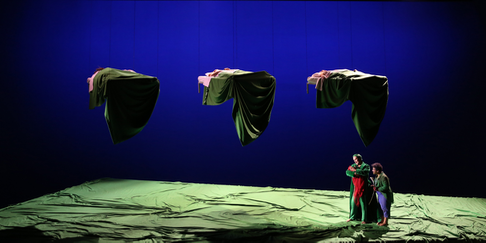 Two pairs of lovers in beds, Tytania and Bottom in far right bed, Lawrence Zazzo as Oberon, Miltos Yerolemou as Puck
Two pairs of lovers in beds, Tytania and Bottom in far right bed, Lawrence Zazzo as Oberon, Miltos Yerolemou as Puck
Photo copyright Patrick Berger courtesy of the Aix Festival
The fairies are dressed in identical blue and green suits, their hands covered in brilliant red gloves, a color that betrays the hidden and maybe dangerous mysterious of the fairy world. The coup de théâtre is when the fairy world instantly vanishes (whooshed into the lofts by cables) and the blank golden lighted stage has become Athens. No hidden digital magic, just overt mechanical human ingenuity — and it is sublime theater.
Nothing could be simpler, and that is the Carsen brilliance. Here this simplicity transforms the absurdities of Shakespeare’s 17th century world into the absolute normal for Britten’s premonition of the psychedelic ’60’s, no questions asked. It is a distilled theatrical language that was new to the operatic stage in the ‘90‘s. It has withstood the test of time, and for this Midsummer Night’s Dream it once again it effectively stripped away layers of insignificant complications to reveal an unusual innocence in the complicated artistic soul of Benjamin Britten.
The Aix Festival provided a splendid cast led by the green wigged Oberon of American counter tenor Lawrence Zazzo who boasts a male colored alto voice that he used to musical perfection. Tytania was sung by French soprano Sandrine Plau in a shimmering and smooth high voice that made her magical. Bottom was sung by British bass Brindley Sherratt with welcomed authority and wit. Central to the success of this edition of the Carsen production was the Puck played by well known actor Miltos Yerolemou (Star Wars VII - the Force Awakens, Game of Thrones, Wolf Hall) whose 5’3” height left him in the world of boys but whose forty-some years added what seemed to be innocent depravity.
One has come to expect excellent casts at the Aix Festival, and this expectation was upheld throughout the huge cast.
A Peter Sellars production is expected to be off-the-wall, as was his Zaïde (2010) at the Aix Festival (a remount of the 2006 Lincoln Center production) where a huge sheet metal wall was pounded on throughout the performance. Just now the maximally gifted, perpetual adolescent (he is 57 years old) has remounted his 2012 stagings for Madrid’s Teatro Real of Stravinsky’s Persephone and Tchaikovsky’s Iolanta. Once again it is all about walls, this time though they are full stage flat backdrops that rise and fall throughout the two brief operas, lighted in various hues and intensities.
Usually Mr. Sellars collaborates with off-beat (though firmly in the publicly-supported-art mainstream), culturally diverse designers (like for Perm Opera’s [and ENO’s] recent Indian Queen). But for this production Sellars’ set designer was George Tsypin, an designer fully vetted by virtually every mainstream stage director who toys with advanced theatrical ideas.
We entered the Grand Théâtre de Provence to an a vista set — a few black door frames construed center stage topped by primitive bird heads. We left more than three hours later and it was still sitting there, only by then all of the usual maskings that created the stage picture had disappeared revealing the fully open stage space, Mr. Sellars and Mr. Tsypin stubbornly reveling in this hackneyed image.
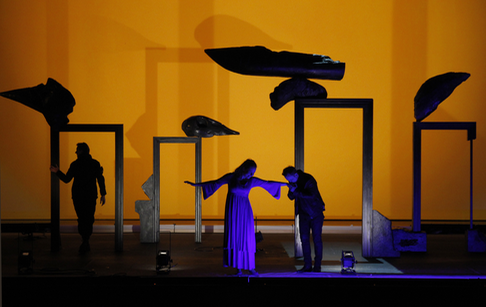 Maxim Aniskin as Robert, Ekaterina Scherbachenko as Iolanta, Arnold Rutkowski as Vaudémont
Maxim Aniskin as Robert, Ekaterina Scherbachenko as Iolanta, Arnold Rutkowski as Vaudémont
Photo by Pascal Victor courtesy of the Aix Festival
Mr. Sellars has long held a fascination for Oriental theater forms thus the black covered stagehands of Noh theater were transformed into concert-black dressed choristers who assisted in the storytelling in both operas, construing themselves in geometric shapes from time to time on the stage to sing while they made the uniform, formalized arm motions typical of the abstractions of Asian theater.
Like Zaïde, neither Persephone nor Iolanta are masterpieces, all the better for Mr. Sellars theatrical explorations, here light and dark. In Iolanta it was transcending blindness into sight, in Persephone it was the light of earthly life to the darkness of hell, and back again and back again.
Iolanta, Tchaikovsky’s last opera, is more in the music theater genre than it is opera, its simple story (blind girl regains sight) told in a series of songs and a couple of duets that forlornly replay the great Tchaikovsky moments. Mr. Sellars mostly kept his actors standing in the doorways and relegated his romantic leads to mostly lying still on the floor when not rolling on the floor.
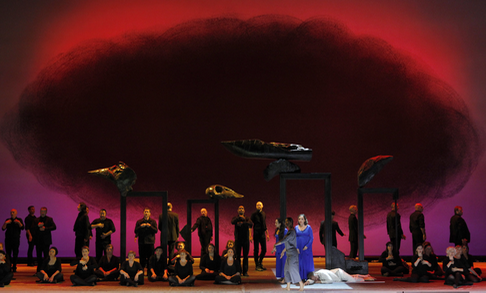 Dominique Blanc (in blue) as Persephone, Paul Groves (lying) as Eumolpe, dancers left of principals, plus chorus
Dominique Blanc (in blue) as Persephone, Paul Groves (lying) as Eumolpe, dancers left of principals, plus chorus
Photo by Pascal Victor courtesy of the Aix Festival
Persephone (1933) comes from Stravinsky’s neo-classic period where much use is made of formalized tableau. It is circus-like theater of catatonic rhythmic repetition according to Stravinsky contemporary Theodor Adorno (a philosopher and aficionado of Schöneberg). Considering Persephone from this point of view it becomes a perfect vehicle for Mr. Sellars’ theatrical genius.
When not done as a concert performance Persephone is danced, a sort of pantomime. Mr. Sellars used four Cambodian dancers who naively imitated André Gide’s narrated and sung poem. One recalled the two Cambodian dancers who wandered aimlessly around the stage for the duration of his 1997 Salzburg staging of Le Grand Macabre.
Russian conductor Teodor Currentzis did not conduct the performance I attended due to illness. It was ably conducted by his assistant, and maybe it was this inexperience that hindered any sense of musical sweep to the evening. Mo. Currentzis is director of the Perm (Russia) Opera (about 800 miles east of Moscow) and is now a frequent collaborator with Mr. Sellars.
The strong voiced, Russian speaking cast for Iolanta sang loudly in fine Russian un-nuanced voices and style. The lone foreigner was American bass Willard White who was the tale’s elegantly voiced Muslim doctor. American tenor Paul Groves was splendid as the Eumolpus, priest of the Eleusinian Mysteries (Persephone abducted into Hades by Pluto). The musical highpoint of the evening was the lovely Tchaikovsky a cappella prayer sung by the chorus of the Opéra de Lyon. It is very rare to hear a 48-voice choir of trained operatic voices singing beautiful, soft music. Simply stunning.
The 2010 Aix audience had no patience for Sellars’ Zaïde. The 2015 audience greatly appreciated this boring double bill. Maybe you had to be French.
Michael Milenski
Casts and production information:
Oberon: Lawrence Zazzo;: Sandrine Piau; Puck: Miltos Yerolemou; Theseus: Scott Conner; Hippolyta: Allyson McHardy; Lysander: Rupert Charlesworth; Demetrius: John Chest; Hermia: Elizabeth DeShong; Helena: Layla Claire; Bottom: Brindley Sherratt; Quince: Henry Waddington; Flute: Michael Slattery; Snout: Christopher Gillett; Starveling: Simon Butterriss; Snug: Brian Bannatyne-Scott; Cobweb, Peaseblossom, Mustardseed et Moth: Benedict Hill, Lucas Pinto, Andrew Sinclair-Knopp et Jérémie de Rijk (members of the Trinity Boys Choir. Trinity Boys Choir; Orchestre de l’Opéra de Lyon. Conductor: Kazushi Ono; Mise en scène: Robert Carsen; Décors et costumes: Michael Levine; Lighting: Robert Carsen and Peter van Praet; Choreography: Matthew Bourne. Théâtre de l’Archevêché, Aix-en-Provence, July 16, 2015.
Iolanta: Ekaterina Scherbachenko; René: Dmitry Ulianov; Robert: Maxim Aniskin; Vaudémont: Arnold Rutkowski; Ibn-Hakia: Willard White; Alméric: Vasily Efimov; Bertrand: Pavel Kudinov; Marta: Diana Montague; Brigita: Maria Bochmanova;
Laura: Karina Demurova. Perséphone: Dominique Blanc; Eumolpe: Paul Groves; Perséphone: Sathya Sam; Déméter: Sodhachivy Chumvan (Belle); Pluton: Chan Sithyka Khon (Mo); Mercure, Démophoon, Tripolème: Narim Nam. Direction musicale: Teodor Currentzis; Mise en scène: Peter Sellars; Décors: George Tsypin: Costumes: Martin Pakledinaz et Helene Siebrits; Lighting: James F. Ingalls. Orchestra, Chorus and Childrens Chorus of the Opéra national de Lyon. Grand Théâtre de Provence, Aix-en-Provence, July 17, 2015.
image=http://www.operatoday.com/Dream_Aix1 - 1.png
product=yes
product_title=A Midsummer Night's Dream, Iolanta and Persephone in Aix
product_by=A review by Michael Milenski
product_id=Above: Lawrence Zazzo as Oberon, Sandrine Plau as Tytania
Photo copyright Patrick Berger courtesy of the Aix Festival
Betrothal and Betrayal : JPYA at the ROH
Having (quite) enjoyed the Verdi Falstaff given here recently, it was nice to hear the Overture to another Falstaff-inspired piece, the Overture to The Merry Wives of Windsor, well shaped by young conductor Jonathan Santagada (who will conduct Maxwell Davies’ The Lighthouse next season). It was a wonderful performance, full of mystery juxtaposed with sprightliness. Long, lyrical basslines sang magnificently, while shades of Mendelssohn (Midsummer Night’s Dream) were palpable.
That was not the only link to the recent Falstaff though. The brown wood panelling of Falstaff’s Windsor surprisingly reappeared in the Verdi Boccanegra excerpt. Anush Hovhannisyan was the Amelia Grimaldi, pure of voice but lacking in projection. Breaths in the centre of phrases and a not-quite-there mastery of Verdi’s technical challenges weighed down this Amelia; her Gabriele (Samuel Sakker) was better, if somewhat over-vibratoed. Yet he has a powerful voice, and when it opens out it is certainly impressive. The firm-toned James Platt was a confident Jacopo Fiesco.
The heart-on-sleeve music of Cilea provided the most extended section of the first part. Nelly Miricioiu (as the titular Adriana) still has stage presence, if not vocal beauty. Lowering the proscenium front enabled a deft transformation of space. Paul Wynne Griffiths, who had handled the orchestra well if not outstandingly in the Verdi, seemed more at home in Cilea’s musical world of sudden contrasts and long-arched melodies that need space to breathe. Sakker again impressed (as Abbé de Chazeuil), as did Yuriy Yurchuk as Michonnet. Maybe it was Jihoon Kim’s Prince de Bouillon that left the most indelible impression. Kim’s stage presence is almost as notable as his resonant voice. He does seem to have everything.
The second half was a Francophile’s dream. The Pearl Fishers remains a wonderful opera, even if heard through completely Bizet does rather over-work an admittedly fine musical idea. Costumes conjured up an exotic environment, even if the stage didn’t (wooden panels gave way to foliage). If the orchestral storm was rather muted under Michele Gamba (surprising, given his excellent Berio Folksongs at the Linbury in 2013), Samuel Dale-Johnson’s Zurga shone, vocally at least (a pity his acting is diametrically opposed to his singing); against him was the positively angelic Léila of Lauren Fagan. A solo aria to complement this: Rachel Kelly, somewhat bland and over-vibratoed in Marguerite’s “D’amour l’ardent flame”. A shame, given the vibrant writing from Berlioz.
Finally a bit of a rarity: Gounod’s take on Romeo and Juliet. A backdrop of stars suggested the key idea of “star-cross’d lovers”. Here it was the radiant Kiandra Howarth who shone, providing the most emotionally convincing singing of the afternoon. Luis Gomes was a well-chosen Romeo, his voice a pleasure to experience. Paul Wynne Griffiths brought forth real tenderness from the orchestra, as well as honouring the music’s lyric impulse. Perhaps the rather static staging lacked drama, but that was hardly a bar to enjoyment. A fascinating, and frequently special, concert.
Colin Clarke
image=http://www.operatoday.com/14684789446_fb0b77e6c0_z.png
image_description=The Jette Parker Young Artists for the 2014/15 season [Photo © ROH/Jay Brooks]
product=yes
product_title=Betrothal and Betrayal : Jette Parker Young Artists Summer Performance, Royal Opera House, London 18th July 2015
product_by=A review by Colin Clarke
product_id=The Jette Parker Young Artists for the 2014/15 season [Photo © ROH/Jay Brooks]
July 19, 2015
Jenůfa Packs a Wallop at DMMO
In the title role, Sara Gartland is serving notice with a star-making performance of the first magnitude. Ms. Gartland not only has an incisive thrust to her robust, soprano, but also she has a charismatic and persuasive dramatic delivery that commands our attention. There is no requirement of this demanding role that eludes her artistic fulfillment. She is able to first suggest an irresponsible, even cruel girlishness with ease, encompass the sufferings of a young mother betrayed in love, and ultimately assume a tragic stature worthy of a classic Greek heroine.
On the way, the soprano displays a full arsenal of effects. Her assured technique allows her to sing evenly throughout the range. Her unerring phrasing and sense of musical line is colored with underlying dramatic intent and infused with subtext. She exhibits meticulous control of even the softest, tenderest phrases, and then turns around on a dime to ravish our ears and stir our souls with throbbing forte exclamations riding easily over the full orchestra, that are laden with heartbreaking intent. Her great Act II prayer scene was a study in variety and total immersion in the musico-dramatic effect. And Sara was in fine company.
Brenda Harris proved a force of nature as a stoic, inscrutable Kostelnička Buryjovka. Ms. Harris has a searing, laser-intense soprano that it is a perfect match for the unmovable stepmother. Yet when the character has to make life-altering decisions, she is able to modulate her delivery to color her voice, embody anguished deliberation, and finally, the mortification of guilt. This was a consistent characterization that first hung onto sanity with fingertips of steel (and high notes to match), then descended into unutterable tragedy as she unwound before our eyes, bringing a touching vulnerability to her vocalism. Ms. Harris and Ms. Gartland may be the two anchors that grounded this performance, but there is glory to be shared.
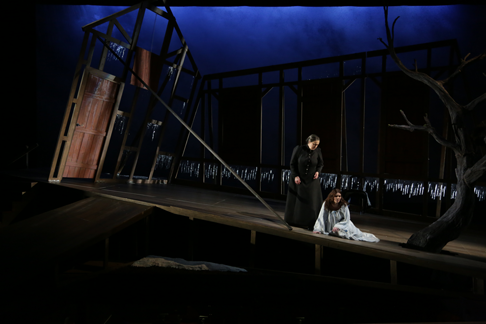 Brenda Harris as Kostelnička Buryjovka and Sara Gartland as Jenůfa, her stepdaughter
Brenda Harris as Kostelnička Buryjovka and Sara Gartland as Jenůfa, her stepdaughter
As the feckless Števa Buryja, Joseph Dennis brought such a fresh, gleaming tenor to the part that it almost belied his status as the town wastrel. But Mr. Dennis, boyish and gangly in his brush cut, suggested the philandering ne’er-do-well with ease all the while exuding a naughty charm that made the plot believable. In the great Act Two scene where the weakling rejects Jenůfa for good, it is to his great credit (and affecting singing) that we at once despise him and pity him.
Richard Cox proved to be a coiled spring of a hot-headed Laca Klemeň. His focused, intense tenor was so powerful upon first utterance that I thought he may have been amplified. His is an impressive, substantial tenor, rock solid in its delivery but malleable in its deployment. Mr. Cox devised a characterization that was first quite terrifying in its volubility, then devolved into almost a Baby Huey like vulnerability that was enormously persuasive. Never before have I felt so completely that he is a changed man, and one that Jenůfa could love. A towering achievement.
If there is a more treasurable artist than Joyce Castle, I am not sure who it is. Her portrayal of Grandmother Buryjovka is another master’s class in how to be a totally involved performer. Ms. Castle has created a total vocal and dramatic portrayal that is highly personal and richly detailed. Her plummy voice not only has great presence, but even in long stretches on stage when she is not singing, she is also always ‘in the moment.’ Her presence enriches every scene she is in.
Kristopher Irmiter’s imposing baritone made for an impressive Mayor; as the Mayor’s Wife, Mary Creswell sang with assurance and potent comic timing. Shannon Prickett made the most of her stage time, bringing a fresh voice and dramatic spunk to the spoiled daughter Karolka. Brittany Fouché was enchanting and sang winningly in the trouser role of Jano.
Director Kristine McIntyre exerted a sure hand over the proceedings, and the unique thrust stage space with its (almost) bisecting pit did not hamper her development of character relationships or crowd control. In fact, it seemed to liberate her, and she filled the stage with crackling confrontations, mournful soliloquies, and delightful motion. In the party scenes, she was ably abetted by choreographer Kyle Lang who devised lively folk-like dances that were as varied as they were cleanly executed.
R. Keith Brumley’s austere set design provided a perfect environment for the piece. Mr. Brumley crafted a series of intersecting, overlapping tiered platforms that spilled off staged and surrounded the pit, constructed of rude, weathered planks. It aptly suggested the simple, rustic life, all the while giving the director an enviable number of levels, an opportunity that Ms. McIntyre capitalized on handsomely. The large spinning mill wheel that was upstage for Act One, gave way to a skeletal structure of a farmhouse in Act Two, and produced a coup de theatre in Act Three as the walls came crashing down as Kostelnička’s deception falls prey to the truth.
The costumes were obtained form Utah opera and coordinated by Connie Peterson. They were perfection. The homely street wear was complemented by colorful folk costumes that lent authenticity and a momentary respite of joy. Barry Steele’s lighting design was another asset, and he partnered commendably by indulging the director’s isolation of characters and moments, with well-considered and -cued area effects. The suggestion of exterior light coming through windows as they are opened, the coolness of the chilly night, the glow of warmth from of the heroine’s recovery room, the cheer of the celebratory scene in Act One, all were beautifully enhanced by Mr. Steele’s plot.
In the pit, Music Director David Neely showed an assured hand, and the musicians responded with a glowing, committed rendition. The solo work by the concertmaster was commendable, and the percussive effects of the xylophone and tympani were effectively penetrating. Lisa Hasson’s chorus was well tutored and sang with elan and balance. The entire musical effect was stirring and heart-rending.
If I could have one wish, it might be for just a little more raw drive from the pit. The impact of the evening was significant, but I wonder if a hint of edginess might take it even higher.
James Sohre
Cast and production information:
Jenůfa: Sara Gartland; Grandmother Buryjovka: Joyce Castle; Laca Klemeň: Richard Cox; Jano: Brittany Fouché; Stárek: Joshua Jeremiah; Kostelnička Buryjovka: Brenda Harris; Števa Buryja: Joseph Dennis; Barena: Rachel Blaustein; Aunt: Morgan Earle; Mayor: Kristopher Irmiter; Mayor’s Wife: Mary Creswell; Karolka: Shannon Prickett; Conductor: David Neely; Director: Kristine McIntyre; Set Design: R. Keith Brumley; Lighting Design: Barry Steele; Choreographer: Kyle Lang; Chorus Master: Lisa Hasson; Costume Design: Utah Opera, coordinated by Connie Petersen; Make-up and Hair Design: Joanne Weaver for Elsen and Associates
image=http://www.operatoday.com/Jenufa-2.png
image_description=Sara Gartland as Jenůfa [Photo courtesy of Des Moines Metro Opera]
product=yes
product_title=Jenůfa Packs a Wallop at DMMO
product_by=A review by James Sohre
product_id=Above: Sara Gartland as Jenůfa
Photos courtesy of Des Moines Metro Opera
Des Moines Fanciulla a Minnie-Triumph
It may not have the crackling tension of Tosca, the profound sacrifice of Butterfly, the appealing chinoiserie of Turandot, or the memorable tunes of La Boheme. But taken on its own colorful, often boisterous terms, Fanciulla can touch and delight.
The collaborators at Des Moines Metro Opera have obviously and lovingly believed in every measure of this work, and have mounted a winning new production that is nigh unto perfection.
At its center, its beating heart is the tremendous performance of Minnie by Alexandra LoBianco. The soprano not only has an exciting spinto voice, but she is able to weight each phrase with just the right dramatic intent. Upon her first appearance, I worried that her diminutive stature might hamper her effectiveness in carrying the show. My fears were unfounded.
Ms. LoBianco’s voice conveys all the stature a great Minnie requires: a creamy instrument that oozes charm and allure, a rock solid technique that is even from top to bottom, and an unerring theatrical savvy that can color dramatic utterances with conviction and yes, deeply felt emotion. I found myself tearing up in her penultimate scene as she begs her beloved “boys” for Dick Johnson’s life. Her connection to each of them was so meaningful, her singing so throbbing with urgency that I was quite undone. This was a true star turn from an artist at the top of her game.
Every inch her match, Jonathan Burton poured out impassioned, emotionally generous phrases as Dick Johnson (Ramerrez). Mr. Burton has an exciting squillo in his full-bodied tenor that is riveting. But Mr. Burton can also exude a persuasive charm as he croons gentler phrases and caresses them with a knowing legato. The pairing of these two artists was a cause for jubilation and their interaction created a musical frisson that was impossible to resist.
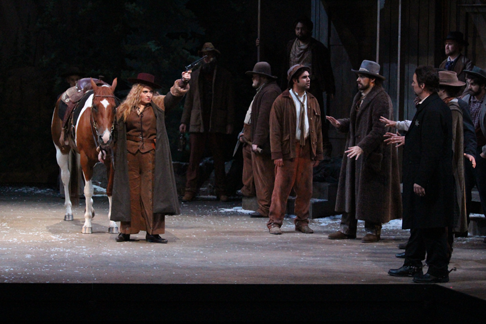
Strapping, handsome Kristopher Irmiter was a powerful and incisive Jack Rance. The celebrated Poker Scene found him in total control of a full palette of vocal effects and conflicted, turbulent emotions. Mr. Irmiter’s imposing baritone is dark and commanding, and his Rance was virile and compelling.
The huge cast of (almost exclusively) male singers is so uniformly excellent that it is hard to single anyone out. That said, Steven Sanders was a solid, clarion-voiced Nick. Christopher Job’s substantial baritone was deployed in fine service to Ashby’s characterization. I thought that Joshua Jeremiah’s individualized, slightly grainy baritone was completely winning as a memorable Sonora. Lanky Tyler Alessi contributed a solidly sung Beppo. And Andrew Potter proved to be a sensitive, appealing Larkens.
Director David Gately has created a vibrant staging that was not only grounded in truthful, meaningful relationships, but also filled the stage with well-motivated, seemingly spontaneous movement. I totally bought into Mr. Gately’s vision of this specific theatrical world, and admired his choices without reservation.
He was greatly assisted by his gifted design team. R. Keith Brumley has contributed a marvel of a realistic set, one that provoked much positive intermission chatter. From the folksiness of the expansive saloon that spilled onto the thrust area, to the isolation of Minnie’s contained cabin, to the tightly focused tableaus of the final act, Mr. Brumley provided an attractive environment unerring in its practicality and atmosphere.
The homey costumes provided by Utah Opera were all exactly the right “look” and greatly enhanced the actors’ efforts in creating realistic characters. And Barry Steele’s detailed lighting design added immeasurably to the effectiveness of the drama. His subtle gradations of area effects and color choices in general washes were masterful in their effect.
Conductor David Neely elicited a spirited reading from the orchestra, who seemed to revel in one of Puccini’s most diverse and luxuriant orchestrations. The attention to detail from the solo wind instrumentalists was complemented by richly satisfying playing from the banks of strings. The instrumentalists went from strength to strength and the overall arc that Maestro Neely was able to effect was as powerful as it was inevitable.
If you didn’t feel the hair rise on the back of your neck, or feel a chill down your spine at least once during this superbly realized performance, you were clearly at the wrong address. This Fanciulla was the operatic art form at its most persuasive.
James Sohre
Cast and production information:
Minne: Alexandra LoBianco; Jack Rance: Kristopher Irmiter; Dick Johnson/Ramerrez: Jonathan Burton; Nick: Steven Sanders; Ashby: Christopher Job; Sonora: Joshua Jeremiah; Trin: George Ross Somerville; Bello: Tyler Alessi; Harry: Lee Steiner; Happy: Zachary Owens; Joe: John Robert Lindsey; Larkens: Andrew Potter; Sid: Evan Ross; Billy Jackrabbit: Brent Michael Smith; Wowkle: Kristen Dininno; José Castro: César Méndez Silvagnoli; Conductor: David Neely; Director: David Gately; Set Design: R. Keith Brumley; Lighting Design: Barry Steele; Chorus Master: Lisa Hasson; Costume Design: Utah Opera, coordinated by Connie Petersen; Make-up and Hair Design: Brittany Crinson for Elsen Associates
image=http://www.operatoday.com/IMG_6249.png
image_description=
product=yes
product_title=Des Moines Fanciulla a Minnie-Triumph
product_by=A review by James Sohre
product_id=Above:
July 18, 2015
First Night of the BBC Proms 2015
It’s a grand blockbuster on a biblical theme, but it’s by no means part of conventional British choral tradition Elgar, who was still alive when this was written in 1931, could not have tried anything like it at the Three Choirs Festival, at that time, and Benjamin Britten, I suspect, would have cringed at its excess.
But think back to Facade: an Entertainment, (read more here) with which Walton burst to notoriety barely six years before the BBC commissioned him to write for orchestra of “not more than 15 players”. Instead Walton created the extravaganza that is Belshazzar’s Feast.
The BBC SO trombones blasted a single, savage wail. Did we hear the sound of ancient Biblical trumpets? “Thus spake Isaiah”, sang the male chorus. but the word “Isaiah” oscillated with oddly bluesy flourish. “How shall we sing the Lord’s song in a strange land?” Oramo’s ear for quirky detail highlighted how Walton adapted the zeitgeist of the Jazz Age to underline the sense of dislocation the Hebrews felt in a new and alien world. The saxophone, the angular percussion, the slithering swathes in the choral parts and even the brass bands are there for a reason.
Christopher Maltman delivered the passage “Babylon was a great city” with such ferocious bite that his voice bounced off the walls of the Royal Albert Hall. The part is created completely without accompaniment to demonstrate the austere values of the Hebrew God. The massed voices of the BBC National Chorus of Wales, the BBC Singers and the BBC Symphony Chorus were impressive, but the heart of the cantata takes place in near silence. Maltman described the mysterious Writing on the Wall in hushed, horrified tones. When the choruses and orchestra resumed, the crosscurrents and interweaving they made, literally, “a joyful noise”, complete with a merry, jaunty dance.
Jean Sibelius’s Belshazzar’s Feast (1906-7) may not be scored for voice, but is highly theatrical nonetheless. Originally written as incidental music for a play,the Suite (Opus 51) unfolds like a series of miniature tone poems, each vividly expressive. The first ,”Oriental Procession” sounds exotic in the way so much western music adopts Orientalism for colour, but Oramo brought out its connection to other Sibelius works. The prancing bell-like sounds reminded me of the “sleigh” music in which Kullervo’s sister rides, clothed in finery on her fateful journey. The slow movements, though, are even more poetic, particularly the haunting “Solitude” with its melancholy part for solo flute. The dotted rhythms and swirling lines suggest Nightride and Sunrise. The clarinet parts were played sensually. Spoken words or sung text were rendered unnecessary in the expressive beauty of Sibelius’s music.
The theatrical theme of this First Night of the Proms began with the Overture to Carl Nielsen’s opera Maskarade (read more here) Oramo has been conducting Nielsen symphonies with the BBC SO for some time, so this performance sparkled with vivacious charm and wit. Perhaps they should do more music theatre. Dadaville, a premiere by Gary Carpenter (b 1951) was disappointingly derivative, added perhaps to fill some BBC quota of works that are newly written but not necessarily new. Fireworks as part of performance might work in something more original, but not in this case. Thankfully, Lars Vogt was a fine soloist in Mozart’s Piano Concerto no 20 in D minor (K. 466), well supported by Oramo and the BBC Symphony Orchestra.
All Proms are broadcast internationally, online and on demand on the BBC Proms Website.
Anne Ozorio
image=http://www.operatoday.com/Sakari-Oramo.png image_description=Sakari Oramo [Photo by Jan Olav Wedin] product=yes product_title=First Night of the BBC Proms 2015, Royal Albert Hall, London 17th July 2015. product_by=A review by Anne Ozorio product_id=Above: Sakari Oramo [Photo by Jan Olav Wedin]Monsters and Marriage at the Aix Festival
Svadba means marriage in Serbian, a slavic language. There are apparently marriage customs that straddle slavic cultures, one of which is the preparation of the bride’s hair for the marriage day, like Konstantin Makovsky’s enormous The Russian Bride’s Attire (1889) that hangs in San Francisco’s Palace of the Legion of Honor. This is simply that.
The opera Svadba follows in the footsteps of the famed Bulgarian State Television Female Vocal Choir so evidently there is a tradition of women’s songs and singing that is strangely absent from Western European and American high art.
That Svadba is an opera is a question in itself. It may be more of a painting as there is little if any dramatic development. Mainly there is exposition of subject, like your eye following the story told in the fixed images — a painting. There is of course much physical motion, thanks to the fine efforts of two U.S. trained artists, stage director Ted Huffman and choreographer Zack Windkur who set abstract movement for each of the seven moments of this female version of what in the U.S. is an all male stag party.
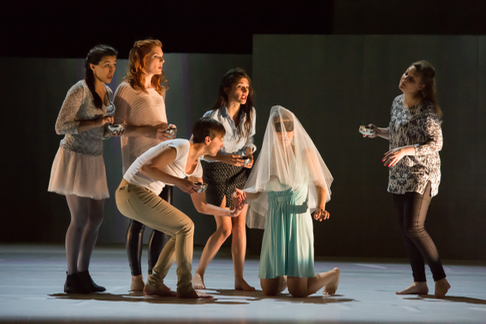 The six singers of Svadba
The six singers of Svadba
Photo copyright Bernard Coutant
Like immersing yourself in a painting the subject matter of Svadba is of less importance than the delight you find in the way its story is told. Composer Ana Sokolovic created these seven moments with the six female voices, but they are not always a cappella. There were strategic dings of a bell, an electronic tape or maybe a synthesizer, plus noises the six singers created with the few props as well as stomping, clapping and tongue clicking.
The sound world was enormous using the tones of trained voices that mostly moved in soundscapes of close intervals, though of course there was much rhythmic invention of syllables that were both nonsense and Serbian. To our Western ears the formulated voice sounds were all abstract (the sounds were so involving that we ignored the sparse supertitles). When there were melodic moments they were in the modal scales of slavic folk music, and this alone created a long ago and far away atmosphere.
There were two strategic and quite beautiful moments when the voices collided on the first inversion of a triad chord, and the grandiose final moment when the voices resolutely landed on a perfect fifth! It was good music.
The subject matter is essentially slavic folklore though its relevance surely has long disappeared. The metteurs en scène, perhaps the composer as well chose to update the imagery to contemporary dress and action. I found this disconcerting given the specifically dated subject matter. Or maybe there currently are some strange customs among Serbian women who live in Canada.
The six singers were superb musicians with beautiful voices. These 55 minutes were splendid indeed.
Our evening continued across town at the recital hall of Aix’s Darius Milhaud Conservatory of Music, part of Aix’s magnificent performing arts campus. Unlike the ill conceived auditorium of the next door Grand Théâtre de Provence (it is round), this recital hall is appropriately shaped (oblong) and has a very fine, live acoustic.
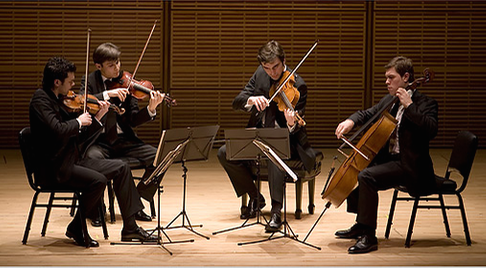 The Modigliani Quartet
The Modigliani Quartet
The Modigliani Quartet performed Beethoven’s 4th string quartet (Op. 18), Ravel’s famed Quartet in F Major, and relevant to the evening’s slavic focus, the Hungarian Ernö Dohnányi’s 1926 third quartet (Op. 33). What this fine quartet has to do with Modigliani, if anything, is an open question. There is no question however that it is a quartet with attitude. Each of the three works were ambitiously attacked to the degree that you feared it was not humanly possible to keep up such volume, speed and intensity for the extended duration of four movements. It was.
Like the six women of Svadba the four men of the quartet moved in soundscapes, achieving a sweeping lyricism that ignored the musical structures of the printed page, frustrating however some listeners with this lack of apparent structure. The unique sound of this quartet is symphonic, the four instruments precisely matched in a very wooden tonal color (the instruments are not credited in the program). The unison breathing of the four men was made very apparent either through the transparent acoustic of the room or the aural concentration the quartet motivated in the listener. It was big playing by four young virtuosos.
The Dohnányi is an edgy and anxious piece, the second movement alternating huge, nervous variations on a chorale theme with quiet (here played pianissimo) moments. The final moments of the last movement well echoed the extreme excitement of the intense Svadba scenes before it roared in tonal edginess to a horserace finish. It is big music, good music.
There was a time when the Aix Festival was at odds with its host city, Aix-en-Provence. Under the stewardship of Stéphane Lissner (1998-2006) the festival floundered artistically though Lissner did succeed in developing a close and cooperative relationship with the citizens of Aix. The festival has indeed regained its artistic footings with the current leadership of Bernard Foccroulle and importantly it has not lost the willing cooperation of the Aix citizenry so ably gained by Mr. Lissner.
To the degree that just now the citizenry of Aix starred in Jonathan Dove’s Monster of the Labyrinth, rendered in French as Le Monstre du labyrinthe. Like Svadba Dove’s Monster is really a concert piece, but unlike the extreme technical demands of Svadba Dove’s Monster was intended to be performed by a community chorus challenged only by the minimal musical demands if not by its considerable length.
Scores, maybe hundreds of Aixoises — men, women and children — had learned the whole thing (a considerable amount of music) by heart, obviously devoting considerable time to rehearse their moves around the Grand Théâtre de Provence.
Monster had its world premiere on June 20 at the Berlin Philharmonic in Berlin, performed next by the London Symphony in London on July 5 (yes, you get it — conducted everywhere by Simon Rattle), and at the Aix Festival on July 8 and 9 again with the London Symphony, though in all cities the orchestras included student, community or semi-professional players.
The music is primarily brass fanfare and huge choruses in a series of scenes that take the youth of Athens to Minos to be consumed by the Minotaur, only to be saved by the young Theseus. It is a piece for amateur performers, their communities and their families, not an work to be savored by opera aficionados and dissected by critics.
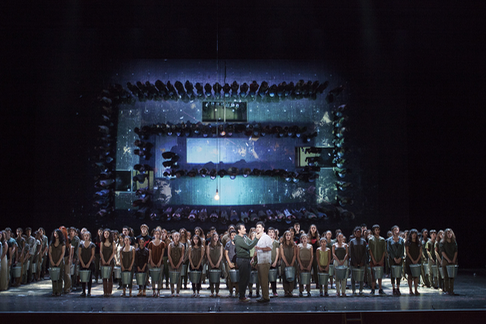 The projected maze, staging by Marie-Eve Signeyrole
The projected maze, staging by Marie-Eve Signeyrole
Photo copyright Vincent Beaume
Of critical interest in Aix however was the staging by Marie-Eve Signeyrole who last winter gave us an excellent Eugene Onegin in Montpellier. Mlle. Signeyrole’s signature technique is the inclusion filmic action, meaning that she uses an enormous cinema screen as backdrop on which she projects what is happening on stage from various perspectives, and most dazzling from above. Note that this worked perfectly for creating Dedale’s maze. Not only memetic of the stage actions the projections include original material, like the Theseus Minotaur battle enacted by two hugely enlarged, i.e. digitally amplified origami puppets.
The staging was of consummate charm, the masses of choristers moving graciously through the minimal stage elements and finally throughout the auditorium. Upon entering the auditorium we had been given a piece of paper. After the minotaur had been eliminated there was a full stop of everything and the was stage emptied. We were now instructed by 6 year-old boy (alone on the vast stage) how to turn the piece of paper into an origami ship so we could all get back to Athens.
The final celebratory chorus was sung by the choristers surrounding us in the auditorium, Sir Simon Rattle having turned to conduct the dispersed chorister and all of us in a final anthem while we (all of us) proudly held our ships on high.
Oh my.
Michael Milenski
image=http://www.operatoday.com/Monster_Aix1.png
product=yes
product_title=Svadba and Le Monstre du labyrinthe in Aix
product_by=A review by Michael Milenski
product_id=Above: Simon Rattle conducting the Aixoises
Photo by Vincent Beaume courtesy of the Aix Festival
July 17, 2015
Des Moines: A Whole Other Secret Garden
This compact opera by Daniel Catán is composed to a text by Juan Tovar, that was gleaned from the Nathaniel Hawthorne story as well as a stage adaptation by Mexican Nobel Prize-winning playwright Octavio Paz. Since it is such a complex piece, it is worthwhile paraphrasing the synopsis from the program:
From his room window, Giovanni, a young medical student, observes the beautiful Beatriz in the locked gardens of her father Dr. Rappaccini, a scientist experimenting with poisonous plants. Giovanni ignores the warning of his mentor Professor Baglioni and sneaks into the gardens to meet Beatriz, who has been rendered poisonous to objects and people. They fall in love and eventually Giovanni begins to exhibit the same traits as Beatriz. He is given an antidote by Baglioni, which he and Beatriz agree to take. In the end, however, Beatriz grabs the vial and drinks the antidote alone, which proves to be fatal to the heroine. She dies at Rappaccini and Giovanni’s feet.
Is there any doubt that there is operatic potential in this premise? To a large degree, the creators and production team have realized substantial musical and dramatic achievements. The piece as originally conceived was a two act opera and premiered as such. Wisely, this fragile tale was subsequently pared back to one 75-minute act, and Mr. Tovar’s lean book provides a perfect springboard for Mr. Catán’s inspired musical palette.
If Stravinsky had set out to create an Impressionistic opera score, perhaps by way of Ginastera, it would not be unlike whole stretches of this score. A very effective reduced orchestration (by the composer) features two pianos, two players deploying massive banks of percussion instruments, and harp. All were exceptional, with pride of place being accorded to the superlative (uncredited) harpist. Conductor Dean Williamson led a sensitive, propulsive reading with admirable attention to details.
The first forty minutes or so feature excellent text setting and animated, highly-charged exchanges of dialogue, with pauses for moments of solo introspection. The rippling harp, the piano scoring (by turns churning and stinging,) the incisive percussive accents, all created a unique aural world, a mesmerizing atmosphere for this creepy environment. That said, by the time Giovanni finally burst into a melismatic arioso, I was all the happier for a “tune” after so much mood painting “effect.” The amplification of singers and “pit” was well handled and subtle enough, although I wish the sound of the voices had been coming from the front and not the sides.
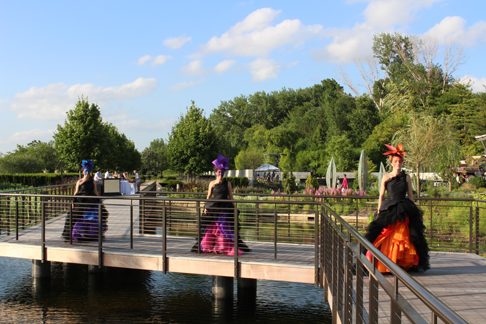 A Scene from Rappaccini’s Daughter
A Scene from Rappaccini’s Daughter
Adam Crinson’s set design was on the whole very effective, with a tiered structure strategically placed in the gardens like a Latin Gothic retabla, implying a collage of omens and misfortunes. Giovanni’s room is on the second level, accessed by a staircase stage left and a ladder stage right. Beneath this platform is a colonnade of supports creating a focused pathway for ominous, extended entrances. The structure is fronted by a raked, astro-turfed platform with a tree dead center. A love seat is on the ground, center, and (I think) a table and/or chairs are on the ground stage right.
I say “I think,” because actors would disappear from view there (except to the first row) since the audience was seated on the flat ground (not raked). Director Octavio Cardenas was successful overall in creating this special world, but he and Mr. Crinson inflicted more than a few sightline problems on the proceedings.
The stage center tree was tall enough to block any performer on the top level if they lay on the bed or knelt on the floor behind it, which happened with alarming frequency. The exposition between Giovanni and Baglioni took place out of sight as they sat (knelt?) on ground level, at the very moment the Surtitles decided to misfire (in what was a sporadic evening for those projections). At the moment of Beatriz’s death, she is not “at the feet” of Giovanni and Rappaccini, but rather standing profile in front of the tree, and I could not see Giovanni or Rappacini’s reactions. Also, I did not wholly understand the significance of the bits of costume pieces that were picked off Beatriz as she stood there “dying.” It didn’t read to me.
These are easily remedied shortcomings in what was otherwise an engaging evening. Connie Petersen and Anita Yavich’s costumes were simply magical. In a lovely stroke, Mr. Cardenas added three extras to the cast, mute “trees” that were lithe women evocatively attired in stylized tree “dresses,” complete with wildly creative make-up and wigs by Brittany Crinson (for Elsen and Associates). The trio of Flower Voices may have owed more musically to Wagner’s Blumenmädchen, but their fanciful look leaned a bit more to Little Shop of Horrors.
The director made masterful use of the “trees” and the “flowers” to create varied, meaningful and artistic stage pictures. Given the limited resources available with temporary light towers, Nate Wheatley designed pleasing lighting effects, and managed a good even wash in spite of the prevalence of side lighting. The twinkle lights in the tree (which fade to black as Beatriz dies) contributed a simple, telling effect. Director and designers also took good advantage of the natural staircases and paths of the Botanical Gardens and did a good job integrating the performance into the environment (and vice versa).
Best of all, DMMO has assembled a cast of top tier vocalists to introduce this rarity to Festival-goers. As the ill-fated daughter of the title, Zulimar López-Hernández offered radiant singing as Beatriz. Ms. López-Hernández is possessed of a lustrous soprano, with a rich middle register and a capability of glinting thrust in the role’s higher reaches. While she can also float effortless pianissimi, her exciting delivery is just on the verge of spinto territory. She is an artist to watch.
The role of Giovanni is the evening’s biggest “sing,” as he never leaves the stage. Happily, young Mackenzie Whitney made a strong case for the infatuated lad with his pliable, impassioned tenor. Throughout the evening, Mr. Whitney revealed fine variety in his declamations, be they defiant, entranced, romantic or delusional, and his handsome figure lent credence to the story. His top voice was happiest at mezzo forte where he caressed some key phrases with creamy tone. When the volume called for a bit more heft, Mackenzie (only) occasionally lost the spin and settled for a straighter toned solution. Still, his was a commanding role assumption.
David Adam Moore subdued his strapping demeanor to create a sinuous, threatening presence as Dr. Rappaccini, the quintessential mad scientist. In his characterful long coat and shoulder length wig, he seemed to be channeling Johnny Depp. Belying the menace of his character, Mr. Moore sang with a gorgeous, warm, even baritone, that perhaps could have incorporated a bit more snarl. As Baglioni, Steven Sanders’ securely sung Baglioni was a decidedly effective contrast to the lyrical Giovanni. Mr. Sanders’ Wagner-Lite delivery showed off a meaty tenor that was at once superbly controlled, unctuous, and officious. In the smaller enigmatic role of Isabela, Melisa Bonetti commanded a wonderful presence in the lower middle voice but also easily soared heavenward with a well-schooled top.
As the Flower Voices, Apprentice Artists Rachel Blaustein, Kristen Dininno, and Emma Sorenson were uniformly fine. In one of the score’s best ensembles, the three combined with Giovanni to luxuriate in an extended passage of layering phrases and the quartet wove an effect that was alluring, haunting and inevitable. What a shame that this splendid cast has only two performances. As successful as was this premiere, I can only imagine how much richer the experience would become as the performers really get comfortable with this complex score, become effortlessly fluent in its vocabulary, and discover even more specificity in these rich characters.
This was undeniably a commendable first night, a brave choice, and a persuasive rendition. It was a joy for this opera-goer to discover a “new” work, especially as so conscientiously performed in such a gorgeous botanical garden. I hope DMMO can find other opportunities to use this setting that is so conducive to spending a perfect summer evening.
James Sohre
Cast and production information:
Beatriz: Zulimar López-Hernández; Rappaccini: David Adam Moore; Giovanni: Mackenzie Whitney; Baglioni: Steven Sanders; Isabela: Melisa Bonetti; Flower Voices: Rachel Blaustein, Kristen Dininno, Emma Sorenson; Conductor: Dean Williamson; Director: Octavio Cardenas; Set Design: Adam Crinson; Costume Design: Connie Petersen, Anita Yavich; Lighting Design: Nate Wheatley; Make-Up and Hair Design: Brittany Crinson for Elsen and Associates
image=http://www.operatoday.com/Rappaccini2.png
image_description=A Scene from Rappaccini’s Daughter [Photo courtesy of Des Moines Metro Opera]
product=yes
product_title=Des Moines: A Whole Other Secret Garden
product_by=A review by James Sohre
product_id=Above: A Scene from Rappaccini’s Daughter [Photo courtesy of Des Moines Metro Opera]
Seductive Abduction in Iowa
That is largely attributable to a splendid cast of Mozarteans that can not only meet all the vocal challenges of this youthfully ambitious score, but make us laugh to boot. This is a perfect sized house for Mozart, and the orchestra provided strong support from the pit, playing with real distinction. Conductor Dean Williamson led with a knowing hand, and the entire stylish reading was a model of its kind. Maestro Williamson found willing partners in the talented instrumentalists who reveled in the colors and musical invention that characterize this score.
Enhancing the effect even further, the physical production is cheeky and inventive. Jacob A. Climer has devised a setting characterized by lush green walls and floor with diagonals of different green shades, and he has made ornate picture frames the leitmotif of his visuals.
There is a proscenium stage, up center, that is “framed” beautifully, two “windows” high up left and right, and even a practical pool of water down center that gets the frame treatment. The orchestra pit, in the center of this thrust staging, is protected by a surrounding bench that allows characters to sit or walk on it. In Act One, there is a makeshift “curtain” hanging from the proscenium frame, and upended chairs litter the stage waiting to be re-purposed in various groupings set by the cast.
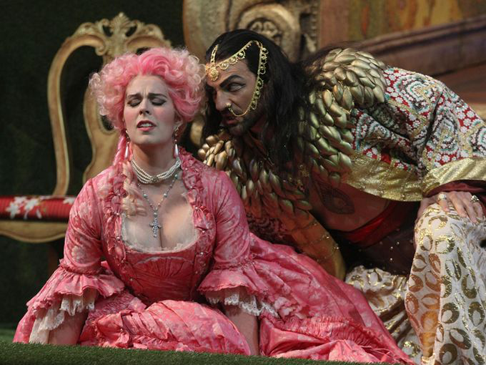 Amanda Woodbury as Konstanze and David Adam Moore as Pasha Selim
Amanda Woodbury as Konstanze and David Adam Moore as Pasha Selim
Act Two finds the proscenium dressed in a lavish damask opera drape, with the two high windows filled in as alcoves lit by Turkish lanterns. Act Three opens up the “stage” platform once more, with the windows as open squares. The “stage within a stage” gets magically backed with a beautiful projection of a full moon and copious stars.
Mr. Climer is also credited with costume design although it is provided by Utah Opera and the coordination is attributable to Connie Peterson. While there are ornate and exotic costumes for the Turks, and beautiful period attire for Pedrillo and Blonde, the rather daffy “look” for Konstanze and Belmonte was confusing. She is awash in a pink flouncy gown topped off with pink wig, and he is in a foppish purple, with a tall (yes, purple) wig that over-emphasizes his height.
While director Chas Rader-Shieber has had a good time with the very effective comic moments of the piece, he has somewhat less success dealing with the leading romantic couple who seem to be cast as “the others.” And therein lies a conundrum. Belmonte and Konstanze are indeed “apart” from almost everyone else, dramatically and musically. In Shaw’s “Arms and the Man” a character posits: “Do you know what the higher love is? Very fatiguing to keep up for any length of time.”
And as the evening progressed I kept feeling that this pair’s “higher love” begged for specificity and variety. By making them look a bit silly, expectations are raised that there may be some fresh insight, yet that angle is not explored. When the couple first re-unites, there is no romantic chemistry, no palpable relief at finding each other. Rather there is a chaste impression that they are simply oh-so-very-very-happy to be able to sing some sublime Mozart duets together. Physical distance mars several key moments, and when they do get close to each other, they wind up in operetta poses. A serious injection of hormones might be just what the doctor (and Wolfgang) ordered, please!
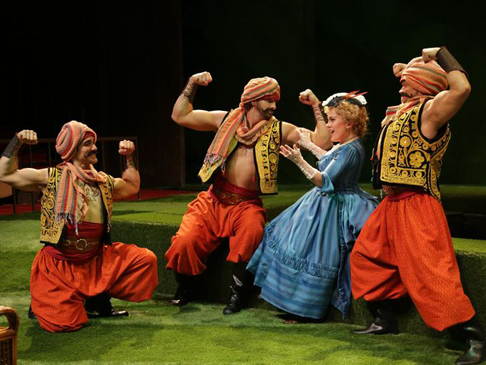 Ashley Emerson as Blonde with guards
Ashley Emerson as Blonde with guards
The performance featured singing in German and (abridged) dialogue in English. To my taste, I would have preferred the whole shebang auf Deutsch. It is telling that the two “asides” that were ad-libbed in German got the two best laughs of the night. Too, staying in German may have stopped Pedrillo and Belmonte from speaking in a Dudley Do-Right operatic delivery more appropriate in a cavernous theatre than the intimate stage of the Blank Performing Arts Center.
Amanda Woodbury contributes a very accomplished Konstanze. Her lyric voice has an appealing immediacy and the technique is commendably flexible. She is assuredly up to the rangy demands of this virtuoso part. If the big arias are always limpid and beautifully negotiated, a bit of dramatic nuance and color would not be amiss. This will no doubt come as Ms. Woodbury performs the part more often. On the occasions when she found some starch to her tone and delivery, a more sizable voice was suggested.
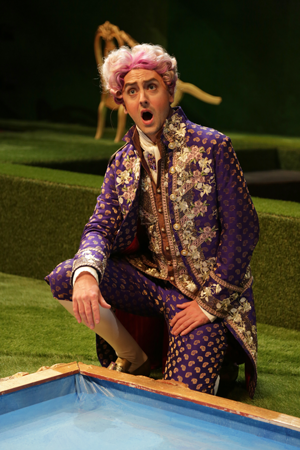 Ben Bliss as Belmonte
Ben Bliss as Belmonte
Ben Bliss has a bright future ahead of him with his honeyed, mellifluous tone and an assured technique. His legato singing was meltingly gorgeous, and he has the firepower for the melismatic writing. Mr. Bliss made short work of the technical demands of Ich baue ganz, but singing all the notes wonderfully is not all that is required by this imposing aria. For a moment, at the start of the final duet, Ben invested the phrases with true, deeply felt anguish, and I saw all the promise and depth in this fine artist. Both Mr. Bliss and Ms. Woodbury have all the skill to sing this music with consummate ease. Now I would urge them to start living it.
Dramatically, the credibility of the story was not helped by taking the lean and handsome Ben Bliss and making him look goofy, especially contrasted with the swarthy, sensitive Pasha of David Adam Moore. Mr. Moore not only has a magnetic stage presence, but he is also costumed superbly: long dark hair, barefoot in harem pants and a ravishing, cream, jewel-encrusted coat, which he shucks in Act II to reveal a pleasing torso that sports a couple of tats and pierced nipples. Now really, would Konstanze prefer a virginal nerd in lavender knickers over this experienced, attractive ladies man? Really?
The talented Ashley Emerson brings an unerring comic timing, plenty of spunk, and brilliant vocalizing to the role of Blonde. Ms. Emerson has grown steadily as an artist, and along the way she has found ever more body and presence in her attractive, well-schooled soprano. Being short of stature worked to her advantage as she created one of the show’s most memorable moments, standing up on a chair to confront Osmin, bringing them eye-to-eye at last.
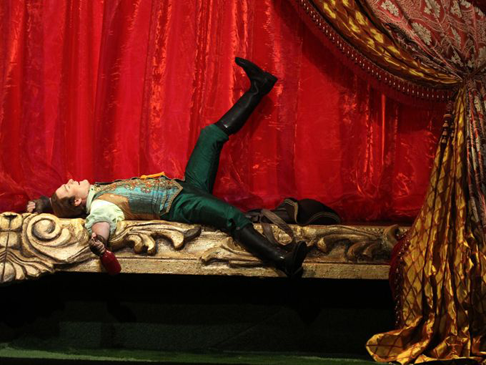 Jonathan Blalock as Pedrillo
Jonathan Blalock as Pedrillo
Matt Boehler was towering in every way as the ridiculously villainous Osmin. This is one of opera’s great comic roles and the inventive (and seriously tall) Mr. Boehler did not miss a trick. His middle voice is so pointed and darkly pleasing that I had wished he could have carried a hint more ping into the very upper stretches. His lower extension is secure and impressive, making up in beautifully controlled focus what he may lack in rafter rattling volume.
As Pedrillo, Jonathan Blalock had boyish appeal and showed off a sound lyric tenor. Yet, I have seen less-gifted Pedrillo’s do more with the part, playing it as a more deliberate foil to the high-minded hero Belmonte. There was nothing wrong in what Mr. Blalock did, but I craved a bit more sass and mischief making.
No matter, the audience was delighted, and this appealing performance was characterized by all the conscientious polish, care, and artistry that permeate this fine festival.
James Sohre
Cast and production information:
Belmonte: Ben Bliss; Konstanze: Amanda Woodbury; Blonde: Ashley Emerson; Pedrillo: Jonathan Blalock; Osmin: Matt Boehler; Pasha Selim: David Adam Moore; Conductor: Dean Williamson; Director: Chas Rader-Shieber; Set and Costume Design: Jacob A. Climer; Lighting Design: Barry Steele; Costumes Provided by Utah Opera and Coordinated by Connie Petersen; Chorus Master: Lisa Hasson; Make-up and Hair Design: Joanne Weaver for Elsen and Associates
image=http://www.operatoday.com/Abduction.png
image_description=Matt Boehler as Osmin [Photo courtesy of Des Moines Metro Opera]
product=yes
product_title=Seductive Abduction in Iowa
product_by=A review by James Sohre
product_id=Above: Matt Boehler as Osmin
Photos courtesy of Des Moines Metro Opera
A Midsummer Night’s Dream, Garsington Opera
Its unique and compelling atmosphere has proved an irresistible magnet to generations of artists and to composers in successive centuries (Lampe,Mendelssohn and Britten inter alia).
On paper the concept of conflating Mendelssohn’s much-loved incidental music with an abridged version of the play itself must have appeared highly enticing, especially given the glorious woodland backdrop of Garsington Opera at Wormsley, and the participation of actors from the Royal Shakespeare Company (RSC) as collaborators. In practice though the ‘wood magic’ was curiously muted and there was an over-riding sense of opportunities missed.
In part this may have been due to a pedestrian account of some of the best-known musical numbers, especially the Overture - a thing of wonder given that Mendelssohn was only 17 when he composed it - and the Scherzo and Wedding March. Curiously, some of the lesser numbers such as the Intermezzo and the various orchestral interjections worked rather better, but by then much of the hoped-for magic had been lost. However, the over-riding reason why the evening was so much less than the sum of its parts lay with the production itself.
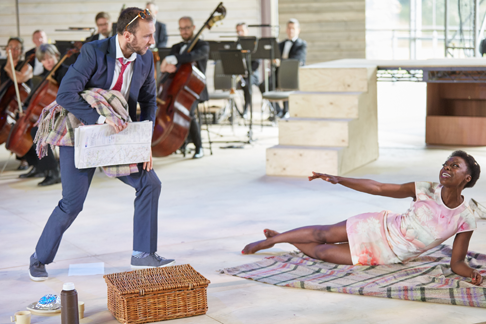 Ross Armstrong as Lysander and Joan Iyiola as Hermia
Ross Armstrong as Lysander and Joan Iyiola as Hermia
Of course there is much to amuse an audience in A Midsummer Night’s Dream but to play it as largely undiluted slapstick as happened here is to miss the point. The antics of the “Rude Mechanicals” are undoubtedly slapstick pure and simple - and very good slapstick too - but the point is lost if all the characters are obliged to play to the gallery all the time. After all much of the play’s potency is generated by the juxtaposition of the imagined grandeur and mores of the court of Theseus (a place where girls face execution if they refuse to marry the man of their father’s choice) and the contrast with the earthy slapstick of Bottom, The Wall and the Lion, which was doubtless designed to appeal to Shakespeare’s ‘groundlings’. Add in the sub-plot of marital conflict between Oberon and Titania over her refusal to hand over an Indian boy page whom her husband lusts after and it will be pretty apparent that there is rather more to the play than mere comedy.
Oberon and Titania (David Rintoul and Marty Cruikshank respectively) are both fine actors with the required presence for these roles though not helped in Oberon’s case by being obliged to play the part bare-chested under a cream dinner jacket that made him look as though he had strayed in from the audience but forgotten his dress shirt. Oberon and Titania also double for Theseus and Hippolyta. The two young couples - Lysander (Ross Armstrong), Hermia (Joan Iyiola), Demetrius (Simon Manyonda) and Helena (Hedydd Dylan) who was the best of the quartet - were consistently obliged to ‘ham’ it up, rushing hither and thither across the bare stage like so many demented hamsters. Puck (Oliver Johnstone), also complete in evening dress, and looking for all the world like another slightly younger member of the full-rig audience, was obliged to cavort endlessly round the stage, even at times appearing to conduct the orchestra seated for no particularly obvious reason at the back of the stage.
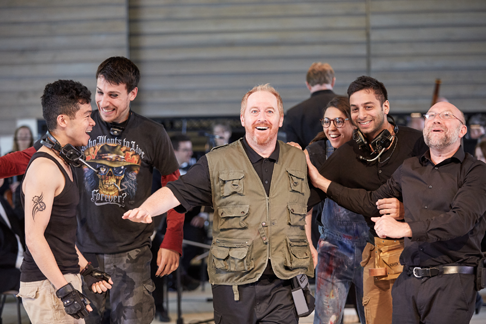 Chris Lew Kum Hoi, Chris Nayak, Forbes Masson, Sophie Khan Levy, Jake Mann, and Timothy Speyer
Chris Lew Kum Hoi, Chris Nayak, Forbes Masson, Sophie Khan Levy, Jake Mann, and Timothy Speyer
The cast of ‘Rude Mechanicals’ Quince, Bottom, Flute, Snug and Starveling who double as the players in Pyramus & Thisbe are, of course, obliged to ‘ham’ it up quite mercilessly and they did so with utmost relish, especially Forbes Masson, the ‘Scottish’ Bottom who bore a passing resemblance to George Galloway.
Other missed opportunities. Leaving aside the complete lack of anything resembling a set and the almost obligatory muddle about costumes - basically anyone could wear anything they liked as long as it had nothing whatsoever to do with the period in which the play is set - a fundamental point about A Midsummer Night’s Dream is that most of it takes place in a dark wood. Garsington’s sliding stage doors open straight out onto the woods beyond but this was left unopened rather than used to embed the play in the surrounding landscape.
Finally, the music itself. There are particular problems to performing early romantic music - Weber, Schubert, Mendelssohn and Berlioz - on contemporary instruments because they are so different in power and especially in timbre. These are problems which have been addressed with some success by groups such as the Orchestra of the Age of Enlightenment or the Orchestra of the New Queens Hall. Garsington’s dryish acoustic doesn’t help, especially when the orchestra is seated on stage. To be frank, on this occasion under Douglas Boyd some of the Garsington Opera Orchestra’s playing was distinctly rough and ready - surely it should be possible to get the Overture’s opening and closing chords together and in tune, neither of which happened here - whilst the Scherzo lumbered rather than levitating with a gossamer lightness and the Wedding March was hammered out with the kind of vehemence more appropriate to Mahler’s 5th (I was reminded of sitting in on a rehearsal for Schubert’s Unfinished with Kurt Sanderling who at one point turned to the trombones and said “Never, ever that sound in Schubert”). At least Garsington’s chorus and soloists Anna Sideris and Catherine Backhouse did well with the ‘Fairy’ chorus, “Ye spotted snakes” lulling Titania to sleep.
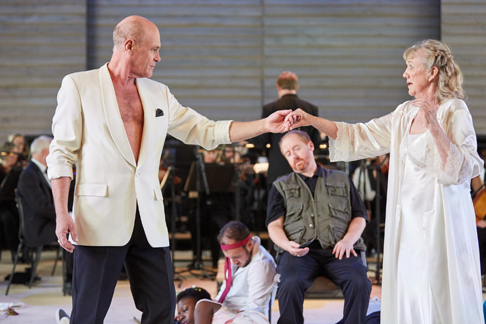 David Rintoul as Theseus, Forbes Masson as Bottom, and Marty Cruickshank as Hippolyta
David Rintoul as Theseus, Forbes Masson as Bottom, and Marty Cruickshank as Hippolyta
Sadly, to this listener on this occasion the combination of abridged play and Mendelssohn’s music was unconvincing and a disappointment although in future I shall happily return to Shakespeare’s play, to Benjamin Britten’s opera, even to the ballet … and of course to Mendelssohn’s magical incidental music. There are few more memorable moment in all music than the end of the overture with the strings arching cantilena, a musical benediction made flesh, before those final four simple wind chords? Other people may feel very differently about this production and if they want to make their own minds up it will be repeated this coming week over several nights at the Southbank Centre’s QEH (22nd - 24th July) and then for a single performance at Stratford (26th July).
Douglas Cooksey
Click here for cast information
image=http://www.operatoday.com/4-Garsington-Opera-RSC-Oliver-Johnstone-Puck-Joan-Iyiola-Hermia-credit-Mark-Douet.png
image_description=Oliver Johnstone as Puck and Joan Iyiola as Hermia [Photo by Mark Douet]
product=yes
product_title= William Shakespeare, A Midsummers Night's Dream with incidental music by Felix Mendelssohn, Garsigton Opera and the Royal Shakespeare Company, Garsigton Opera at Wormsley, 16th July 2015.
product_by=A review by Douglas Cooksey
product_id=Above: Oliver Johnstone as Puck and Joan Iyiola as Hermia
Photos by Mark Douet
July 15, 2015
Richard Wagner: Tristan und Isolde
Yes, Tristan is just a shortened title, so we should not necessarily read anything into the disappearance of Isolde, but, whilst we clearly value both lovers and both singers portraying those lovers more or less equally — great Tristans perhaps more so, given their ridiculous rarity — it struck me as perhaps particularly perverse to have been referring to my seeing Tristan at the Munich Opera Festival, when, like so many in the theatre, I had been going especially to hear and, yes, to see Waltraud Meier. For these two performances in Munich, of which the one I heard was the first, have been announced as her farewell to the role. ‘Waltrauds Abschied’, then, I sentimentally called my visit, in dubious Mahlerian homage to a last performance that was actually to be a penultimate performance. I could, after all, hardly say I was off to hear Isolde — or maybe I could, even should, have done.
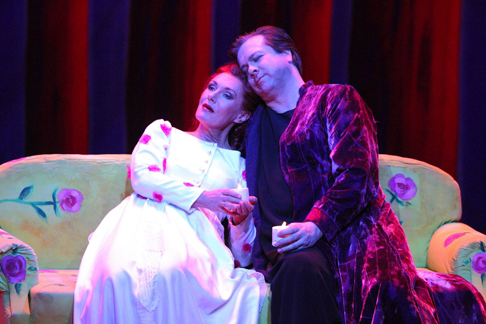 Robert Dean Smith as Tristan and Waltraud Meier as Isolde [Photo courtesy of Bayerische Staatsoper]
Robert Dean Smith as Tristan and Waltraud Meier as Isolde [Photo courtesy of Bayerische Staatsoper]
Of course, when I asked, ‘what do we call Tristan und Isolde’, I was not necessarily just referring to the title. There is no need to frown upon those calling it an opera; I am sure we have all done so at some point, or ought to have done so. But, as with all of Wagner’s dramas, it distances itself from the norms of opera and, perhaps still more so, the opera house. I am perhaps over fond of deploying this quotation from Boulez, but it so often seems to hit the nail upon the head. Whilst at work on the Ring at Bayreuth, Wagner’s great conductor-composer successor observed: ‘Opera houses are often rather like cafés where, if you sit near enough to the counter, you can hear waiters calling out their orders: “One Carmen! And one Walküre! And one Rigoletto!’ What was needed, Boulez noted approvingly, ‘was an entirely new musical and theatrical structure, and it was this that he [Wagner] gradually created’. It might then, not be entirely wrong to suggest that Wagner’s works deserve shielding form the opera house, at least as it currently exists. (Let us leave Bayreuth and its never-ending travails to one side for the moment.) However, by the same token, Wagner’s Handlung —his own term, ‘action’, a Teuton’s rendering of ‘drama’, admirably supersedes debates concerning nomenclature — is surely at home in Munich, if anywhere at all. For ‘Waltrauds Abschied’, then, and what I calculated must be at least my twentieth ‘live’ Tristan — sorry, I cannot yet bring myself to call it Isolde — there was something fitting to experiencing it for the first time in the house in which it had received its premiere, 150 years previously (10 June 1865).
Moving on a little from what we call Tristan und Isolde, what do we think it is ‘about’? Wagner was pretty clear, and I have tended to take him at his word, or at least some of his words. In 1859, summarising the work’s concerns for Mathilde Wesendonck, he omitted not only King Marke’s forgiveness, but also Tristan’s agonies at Kareol. True action, Handlung,had been irreversibly transferred to the noumenal world: ‘redemption: death, dying, destruction, never more to waken!’ But as Peter Konwitschny, in a brilliant programme note, argues, quoting Heiner Müller, himself director of a renowned Tristan, ‘Ein Werk ist immer klüger als sein Autor.’ (‘A work is always cleverer than its author.’) Such, one might have thought, was a truism, and for many of us it is, although not for those strange people who seem to think it not only no cleverer but actually more limited, referring to the tedious mantra of a ‘composer’s intentions’ , whilst actually having no more interest in them than their most wild-eyed caricature of so-called Regietheater would. For them, the questionable taste of a questionable memory of their first exposure to a work seems to suffice. Handlung? Madame Tussauds, more like. (‘Museum’ would be too generous, given its connotations of learning, culture, and stewardship.)
Back, however, to Konwitschny. He makes the somewhat startling claim — at least to me — that Tristan is ‘ein sehr hoffnungsvolles Stück’ (‘a very hopeful piece’). As ever, it depends what one means — and it depends what one means by love, death, and so many other things. But Konwitschny, arguably taking his cue from the score, from Isoldes Verklärung, declines to see desolation, although, certainly not taking his cue from Wagner, he seems to tend more to Liszt’s conception of a Liebestod. And so, following our heroic couple’s shuffling off their mortal coils, sombrely dressed in black at the foot of the stage, below the other Handlung — if indeed that qualifies as such — we return to the raised level of that other Handlung, and see Marke and Brangäne visiting their graves. Love, ‘whatever that means’ — and we may understand that as part of Wagner’s ongoing internal battle between Feuerbach and Schopenhauer — may partly have won out, which sounds pat, but does not feel so. Perhaps we have experienced Wagner’s Gefühlswerdung des Verstandes (‘emotionalisation of the intellect’). More optimistically still — and it is surely a useful corrective at least to consider the non-pessimistic aspects or possibilities of the work — we might consider the words of Wagner’s fellow radical 48er, Arnold Ruge, writing of an envisaged religion of freedom, ‘the entire world of humanistic ideals, the entire Spirit of our times, must enter the crucible of feeling, out of which it must again come forth as a glowing stream and build a new world.’
Perhaps the most striking thing about Konwitschny’s production, first seen in 1998, is how it creeps up upon one; indeed, how its owl of Minerva truly only seems to take flight at dusk. The first act takes place, relatively conventionally, on a ship, doing pretty much what Wagner asks, and doing it rather well, although the colourful curtain, presaging aspects of the second act, has perhaps called into question our preconceptions before we are aware of their status as preconceptions . The realms of light and day, phenomenon and noumenon, make their presence felt after the taking of the potion through Michael Bauer’s excellent lighting: a distinction that continues, greatly to the enhancement of the drama. One certainly feels the tragedy in Tristan’s death upon Melot’s sword, but equally, one feels, knows that that is not the only story. The world of Tristan’s past, played to him on old video reels, complements what he tells us, without — this is crucial — overpowering it, as too many overtly psychological, even psychoanalytical readings do. Tristan is not ultimately about the hero’s childhood; it remains concerned with metaphysics, in one way or another. And the release provided by Isolde’s last song is certainly married, not in an easy way but certainly in a fruitful way, with those final scenic aspects mentioned.
We came, of course, at least most of us did, above all for Meier. It is a tribute to the performance and production alike that she did not overshadow but indeed flourished. It would be unduly perverse, though, to overlook her contribution. Over the years in which she has sung Isolde, she has offered many, developing virtues, whether related to production, musical performance, or even the stage of her career. Here, everything seemed in more or less perfect balance — or, better, fruitful dialectic. Attention to words was second to none, likewise stage presence. Sustaining of a vocal line, however, was equally impressive. Suffice it to say, she did not play Isolde; she was Isolde.
Robert Dean Smith also gave the finest performance I can recall from him, and not just as Tristan. It was as tireless a performance as I can recall from anyone, without the disadvantages that often entails of sheer persistence trumping vocalism. The sheer refulgence of René Pape’s King Marke had to be heard to be believed; Markes rarely disappoint, but Pape achieved far more than not disappointing. Alan Held was a thoughtful, dramatic, even at times impetuous Kurwenal: all in character, impressive indeed. Michelle Breedt’s Brangäne was just the right foil for Meier’s Isolde; this was a confidant, beautifully sung, in whom one could — confide. Dean Power’s Young Seaman at the start was as sensitively sung as any I can recall. Kevin Conners offered a powerful embodiment of the Shepherd — Konwitschny’s two English horn players on stage an unforgettable image — and even the Steersman, Christian Rieger, made a fine impression with his all-too-brief line. Francesco Petrozzi presented ultimately inconsequential malevolence, as he should, in the role of Melot.
As Wagner wrote to Eduard Devrient of his ‘most musical score,’ Tristan has, and in performance should have, ‘the most vivid dramatic allusions totally at one with the dynamic of its musical texture’. That is asking a great deal of any conductor, orchestra, and cast. (And that is before we even consider that this is emphatically not a concert work, whatever dark hopes we might entertain upon seeing an unsatisfactory staging.) Philippe Jordan presented Wagner far more impressive than I have heard from him before, whether in Bayreuth or in Paris. The Handlung was as much in the orchestra as on stage, arguably more so, which is just as it should be. Pacing rarely, if ever, faltered, and details were presented without overwhelming (crucial woodwind lines in particular). The splendid Bavarian State Orchestra, whose praises I have been singing all week, excelled itself here. Dark of tone, yet clear and transparent where necessary, it was, in the pit that so much of Tristan und Isolde was truly brought to that life which its director argued so forcefully was of its essence.
Mark Berry
Cast and production information:
Tristan: Robert Dean Smith; King Marke: René Pape; Isolde: Waltraud Meier; Kurwenal: Alan Held; Melot: Francesco Petrozzi; Brangäne: Michelle Breedt; Shepherd: Kevin Conners; Steersman: Christian Rieger; Young Sailor: Dean Power. Director: Peter Konwitschny; Designs: Johannes Leiacker; Lighting: Michael Bauer; Dramaturgy: Werner Hintze. Bavarian State Opera Chorus (chorus master: Sören Eckhoff)/Bavarian State Orchestra/Philippe Jordan (conductor). Nationaltheater, Munich, 8 July 2015.
image=http://www.operatoday.com/csm_FG_Tristan_und_Isolde_06Tristan_und_Isolde_Smith_Meier_c__Wilfried_Hoesl_IMG_5029_f0364d6e75.png image_description=Robert Dean Smith as Tristan and Waltraud Meier as Isolde [Photo by Wilfried Hoesl courtesy of Bayerische Staatsoper] product=yes product_title=Richard Wagner: Tristan und Isolde product_by=A review by Mark Berry product_id=Above: Robert Dean Smith as Tristan and Waltraud Meier as Isolde [Photo by Wilfried Hoesl courtesy of Bayerische Staatsoper]Photos from premiere of production in 1998
Debussy: Pelléas et Mélisande
I could not for the life of me understand what the problem might have been. What I saw was a thoughtful, highly accomplished, post-Beckettian staging of, well, perhaps the most Beckettian of operas. I could certainly understand that some people might not have liked it, but not only did the terms in which it had apparently been criticised seem almost incredibly extravagant; I could not help but think that those who would not have liked it would in any case not much have liked Pelléas et Mélisande itself. (And besides, there is a world of difference between not ‘liking’ something and thinking it worthless — or at least there should be; it took me two or three years to ‘like’ Elektra, something for which I hold the Solti recording largely responsible, but it never occurred to me that the work was not a masterpiece.)
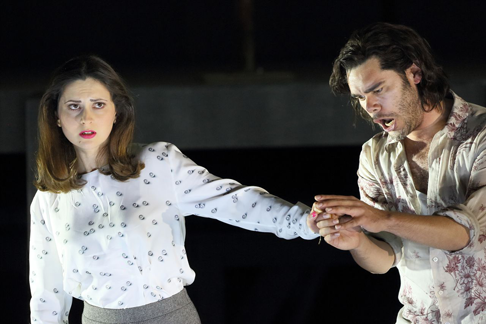 Elena Tsallagova as Mélisande and Elliot Madore as Pelléas
Elena Tsallagova as Mélisande and Elliot Madore as Pelléas
Christiane Pohle’s provocative — in the best sense — new staging takes place, like the opera, in what we might call, with slight trepidation, lest we be consigned to Pseud’s Corner, a liminal zone, located at the intersection of the meaningful and meaningless. (For anyone interested in vaguely modern drama, which seems, sadly, to exclude vast swathes of opera audiences, the claim should not seem too outlandish.) What could be more instantly evocative of contemporary — to us, at least — anomie and ennui than a ‘stylish’, soulless hotel reception? Staff and guests continue their work, or whatever it is they do, sometimes stepping into ‘character’, sometimes remaining ‘background’. Just as they might in a royal household, one might add. Much is absurd, or so it seems to onlookers, yet it absorbs, even if it does not fulfil. Sometimes it seems to intersect more obviously with the drama, Debussy’s drama, than others, but even when it appears to be dissociated, it somehow focuses one’s attention upon what is ‘happening’, or as so often in this opera, what is not. Spectators on the one hand remain just that, yet on the other are drawn in. We cannot quite say how or why, just as the characters cannot, when indeed they can say anything at all. Questions are posed, occasionally answered, more often provoking another, seemingly unrelated question, or stillness and silence. I have not seen a staging that more closely corresponds to the singularity of Debussy’s drama, and yet which also retains its distance, seemingly — wisely — saying, if this is not for you, then Pelléas, the score and libretto, the memories you might have: they remain intact. This is, or could be understood to be, metatheatricality in a sense both old and intriguingly new; Pohl’s production allows one to take what one will, if only one is prepared to think or even just to experience. Sadly, some, perhaps influenced by what ‘opinion-formers’ had told them, elected to laugh (derisively, at least so it seemed) or even noisily to walk out. If they wished to leave, they might at least have had the decency to wait until the interval.
For some reason, or none, I had it in my head that Philippe Jordan was conducting. I mention that, since I initially assumed that Jordan’s Wagnerian experience might be the reason for the orchestra sounding more than usually Wagnerian. It transpired that Constantinos Carydis was in fact the conductor, yet the echt-Wagnerian sound of the Bavarian State Orchestra persisted. It was, moreover, not just the sound, but the motivic texture that so strongly recalled Parsifal, Tristan, and, to a lesser extent, even the later Ring operas. What often sounds closer to vague similarity here edged closer at times even to plagiarism. But, as Stravinsky noted, lesser artists borrow, whilst great artists steal. There are, of course, all manner of ways to play Pelléas, and doubtless this was shaped in good part by the orchestra’s heritage, but this was fruitful and, again, in the best sense provocative. It could not have been much further distant from Esa-Pekka Salonen’s recent, magnificent Philharmonia concert performance , but had its own, different validity. Carydis judged well the ebb and flow and at times brought the score closer to conventional operatic drama than one often hears. Hearing the orchestra given its head thrilled as it disconcerted, not least in combination with what one saw. There is of course more Wagner in Debussy than Debussy allowed, just as there is more Wagner in Beckett than Beckett allowed. Escape is not an option — or rather it is doomed to fail, if sometimes to fail better.
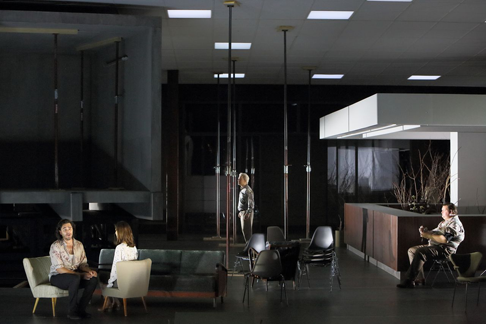 A scene from Pelléas et Mélisande
A scene from Pelléas et Mélisande
Vocal performances were generally excellent, as were the singers’ responses to Pohl’s often difficult demands. (At least I assume they were hers: this did not seem improvised.) Elliot Madore and Elena Tsallagova offered a truly disconcerting — that word again — pair of lovers, their childishness (weird smiles) married to, indeed productive of, erotic frissons, almost as much as their command of the vocal lines. Madore’s relatively dark tone contrasted intriguingly with Tsallagova’s bright, almost doll-like delivery; both performances contributed to, rather than merely reflecting, our understanding. Markus Eiche’s Golaud seemed initially a little too gruff, and his French was not always quite what it might have been, but his portrayal grew in stature, truly moving by the end. Perhaps that had always been the plan; it certainly made me think. Alastair Miles’s Arkel properly bewildered. (Is that not what more or less everything in this opera should?) Was he victim or in some sense initiator? He refused the either/or, and delivered his text with an understanding that seemed at times almost to pass all understanding. Okka von der Damerau’s Geneviève commanded the stage in a similar yet different way — again, as befits the character. Her vocal shading was not the least of the performance’s pleasures, even if we did not hear so much from her as we might have wished. Young Hanno Eilers was quite the best boy Yniold I have heard; one could often have taken dictation from him, verbally or musically. Still more to the point, his fear made perhaps the most powerful dramatic impression of all. A pointless question, arguably like any relating to this ‘pointless’ opera, but it was difficult not to ask: what does Fate hold in store for him?
Was I perhaps more receptive than I might have been, on account of prior reception? I do not, cannot know; perhaps I was, but that, like so many questions in this opera, is really one for a psychoanalyst. But I do not think I was entirely guilty of finding things that were not there; or, if I was, I was guilty in the productive spirit in which work, production, and performances were also guilty. For this, in the well worn cliché, was more than the sum of its parts, ‘intentionally’ or otherwise, so long as one agreed to be one of those parts. I have not stopped thinking about what I saw and heard; sadly, many seem never to have started.
Mark Berry
Cast and production information:
Arkel: Alastair Miles; Geneviève: Okka von der Damerau; Pelléas: Elliot Madore; Golaud — Markus Eiche; Mélisande: Elena Tsallagova; Yniold: Hanno Eilers; Doctor: Peter Lobert; Shepherd: Evgeny Kachurovsky. Director: Christiane Pohle; Set designs: Maria-Alice Bahra; Costumes: Sara Kittelmann; Assistant Director: Malte Ubenauf (assistant director); Lighting: Benedikt Zehm. Bavarian State Opera Chorus (chorus master: Sören Eckhoff)/Bavarian State Orchestra/Constantinos Carydis (conductor). Prinzregententheater, Munich, Tuesday 7 July 2015.
image=http://www.operatoday.com/csm_13_dc8146d5ad.png image_description=Elena Tsallagova as Mélisande and Elliot Madore as Pelléas [Photo courtesy of Bayerische Staatsoper] product=yes product_title=Debussy: Pelléas et Mélisande product_by=A review by Mark Berry product_id=Above: Elena Tsallagova as Mélisande and Elliot Madore as PelléasPhotos courtesy of Bayerische Staatsoper
Richard Strauss: Arabella
There was a great deal to admire in this performance, but I fear that asking for more than to admire it on the work’s own terms would have been to ask the impossible. A tale of operetta-ish Jane Austen — or is that of Jane-Austen-ish operetta? — the libretto unfinished (and set as it was written by Strauss, out of respect for Hofmannsthal), it is not a work that makes it easy for one to care about its characters, nor indeed for their plights, such as they are. Its outings other than in Strauss’s Germanic heartland, and sometimes even there, veer dangerously close to that dubious operatic phenomenon: the ‘vehicle’ for a star soprano. Yet Arabella herself remains a curiously blank canvas on to whom men, and to a certain extent women, project their fantasies. That is not in itself an unpromising idea, if one can steer clear of misogyny: after all, one can say the same, up to a point, about Lulu. But is Strauss’s — or indeed Hofmannsthal’s — heart really in it? Is this ultimately more than an unsuccessful rehash of certain themes in Der Rosenkavalier? Again, I remain to be convinced.
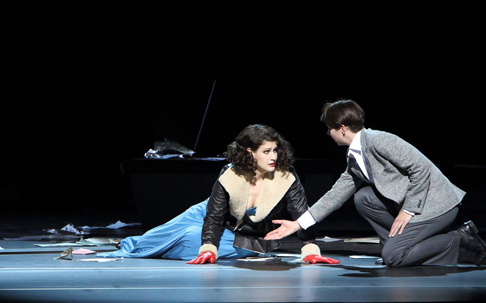 Anja Harteros as Arabella and Hanna-Elisabeth Müller as Zdenka
Anja Harteros as Arabella and Hanna-Elisabeth Müller as Zdenka
Enough of doubts, anyway, at least for the moment. This was a splendid performance. The Bavarian State Orchestra was on excellent form throughout, Strauss’s orchestral sound perfectly captured, with enough clarity and, at times, irony to guard against the sentimentality that is perhaps more of a snare in this opera than any of his. (And yes, I include Rosenkavalier in that.) Philippe Jordan clearly knew the score and communicated its twists and turns admirably. Waltz and other rhythms were well pointed, phrases taking their place within a greater whole to highly convincing effect. My only real misgiving was that very difficult end to the final act. One should certainly feel the accelerando and its frankly sexual implications, but here, as so often, the gear change seemed unprepared. It is perhaps only fair to point out that it is something very few conductors manage to pull off. (Sawallisch, Keilberth, and Böhm spring instantly to mind, but then, without an encyclopædic knowledge of the discography, I am floundering. I seem to remember Christoph von Dohnányi, always a fine Strauss conductor, convincing here too at Covent Garden; he certainly did in the score as a whole.) Jordan’s achievements here were real — and greatly appreciated, as were those of this magnificent orchestra.
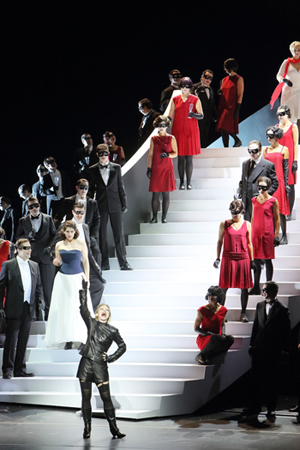 Eir Inderhaug (Die Fiakermilli, vorne), Ensemble, Chor und Statisterie
Eir Inderhaug (Die Fiakermilli, vorne), Ensemble, Chor und Statisterie
Anja Harteros had been due to sing Arabella in that 2008 performance, but cancelled; this time, she was present, and that made all the difference. (Her substitute had, sadly, left a great deal to be desired.) Harteros, like Karita Mattila at Covent Garden in 2004 made the most of the role, turning Arabella into as convincing a flesh-and-blood woman as one could imagine, without distorting unduly the frustrating ‘purity’ of the role. This was a graceful and — in the final scene — sexy portrayal, sung with consummate ease, beauty, and indeed commitment. One could not have asked for more. Thomas Johannes Mayer contributed equally to the sexual frisson at the end. His performance as Mandryka was dark, even on occasion demonic, fully living up to the high hopes Hofmannsthal seems to have entertained for the character and — who knows? — might actually have accomplished more fully, had he lived. Mayer’s Wagner singing is by now well known; he is clearly an equally fine Straussian. Hanna-Elisabeth Müller’s Zdenka was lively, spirited, unfailingly well sung: everything one wishes for in such a trouser(-ish) role. Doris Soffel’s Adelaide provided an object lesson in ‘secondary’ character portrayal, making far more of the compromised mother — not least in her second-act amorous encounter with Elemer — than one would expect. Kurt Rydl complemented her perfectly as Waldner: again compromised, but with life and honour in him when called upon. The couple’s way with Hofmannsthal’s text was surely second to none. Joseph Kaiser made for an attractive Matteo indeed, as much vocally as on stage, a plausible possibility for Arabella, had she been interested. As for the Fiakermilli, surely the most irritating character, if one can call her that, in all Strauss, Eir Inderhaug did a good job, without elevating the coloratura quite into something one could simply enjoy for its own sake, there being little else to detain one’s interest.
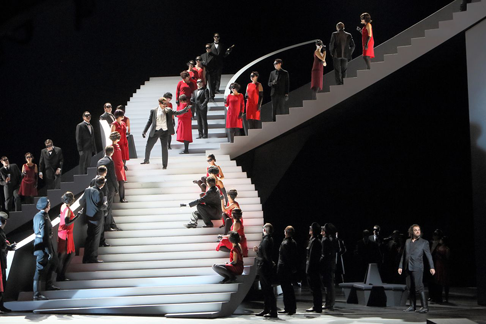 Ensemble, Chor und Statisterie
Ensemble, Chor und Statisterie
I say that, but director, Andreas Dresen, did what he could. In what is otherwise a relatively conventional, though that is certainly not to say dull or unthinking, production, the Fiakermilli’s presentation as an S&M Mistress of Ceremonies can hardly be missed. Dresen sees her, as a programme note made clear, as the initiator of the night’s amorous events, ‘the anarchistic element’, testing the guests’ boundaries. It is an interesting idea, even if there seems to be a limit to how emphatically the work, at least as it stands, can support it. Still, it is part of the task of a good production to present such possibilities and to see where they will lead. In general, Dresen seems content to draw out the characters — as, indeed, he would claim to be doing with the Fiakermilli — and that he does with skill, without turning them into something they cannot really be. Psychological realism and exploration not unreasonably trump the search for a Konzept, although I should be curious to know whether a more challenging staging would deepen appreciation of the work, or simply disrupt it.Mathias Fischer-Dieskau’s set designs, Sabine Greunig’s costumes, and Michael Bauer work together to stylish effect indeed: black, white, and red were the order of the day: the Austrian triband with eagle, I suppose, although not of course the colours of the Austrian Empire of the day. I am not sure that the colours necessarily signify anything, though, or even if they do, that there is further meaning to be discerned. Not unlike the opera, one might say.
Mark Berry
Cast and production information:
Count Waldner: Kurt Rydl; Adelaide: Doris Soffel; Arabella: Anja Harteros; Zdenka: Hanna-Elisabeth Müller; Mandryka: Thomas Johannes Mayer; Matteo: Joseph Kaiser; Count Elemer: Dean Power; Count Dominik: Andrea Borghini; Count Lamoral: Steven Humes; Fiakermilli: Eir Inderhaug; Fortune Teller: Heike Gröyzinger; Waiter: Niklas Mallmann; Welko: Bastian Beyer; Djura: Vedran Lovric; Jankel. Tjark Bernau. Director: Andreas Dresen; Assistant Director: Frauke Meyer; Set Designs: Mathias Fischer-Dieskau; Costumes: Sabine Greunig; Costumes: Michael Bauer; Dramaturgy: Rainer Karlitschek. Bavarian State Opera Chorus (chorus master: Soren Eckhoff)/Bavarian State Orchestra/Philippe Jordan (conductor). Nationaltheater, Munich, Monday 6 July 2015.
image=http://www.operatoday.com/csm_09_2620dce9e8.png image_description=Anja Harteros as Arabella and Thomas J. Mayer as Mandryka [Photo courtesy of Bayerische Staatsoper] product=yes product_title=Richard Strauss: Arabella product_by=A review by Mark Berry product_id=Above: Anja Harteros as Arabella and Thomas J. Mayer as MandrykaPhotos courtesy of Bayerische Staatsoper
Carmen in Orange
But Jose, unlike Aida’s Radamès, is actually the star of the show, Carmen herself is a cameo role, three brief songs, then thrown around a bit and finally stabbed, throttled or drowned depending on directorial humors. In Orange Carmen was one of the unusual interpreters of the role — Kate Aldrich.
Mme. Aldrich once brought the shine of Kansas to Carmen’s Seville (San Francisco Opera 2007) but this estimable artist has matured in Europe where she has embraced the soprano bel canto repertory with great success. Cast now in Orange a bit after her Carmen period the role is still well in her voice and she still makes Carmen a magic presence by sheer vivacity of personality, as she had in San Francisco. It is not a Carmen based on sultry sexiness.
It was a lively night in the 2000 year old Théâtre Antique despite the 37C/100F temperature. Normally at a Chorégies performance there are a few spectators (among the 10,000 or so) who are carried out on stretchers — the steps are steep, the audience aged and much wine has flowed at the hundreds of festive dining tables spread out in the streets of the old town. But no one was going to miss out on this famous tenor doing this famous role.
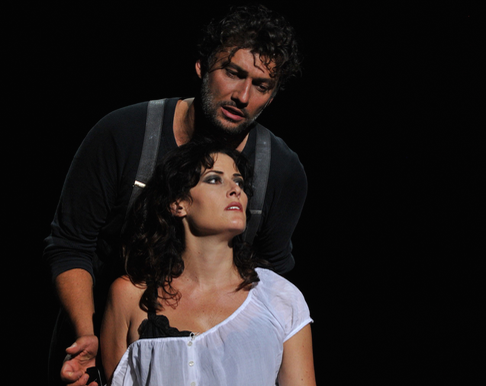 Jonas Kaufmann as Don Jose, Kate Aldrich as Carmen
Jonas Kaufmann as Don Jose, Kate Aldrich as Carmen
Photo copyright Gromales, courtesy of the Chorégies d'Orange.
Given that expectations were inordinately high a couple of boos were heard through the polite applause for the “Habanera.” But that was before we (many, many of us in the audience) became aware that conductor Mikko Franck had indeed transformed Bizet’s fiery opera into a lovely symphonic tone poem. It was of great orchestral personality above all else, and of an inexorable deliberateness of musical exposition. The pit was absolutely detached from the stage.
Upon his re-entry into the pit after the intermission this conductor was met with a resounding chorus of boos (mine included). Mr. Franck conducted seated in an arm chair (yes, there really were arms) seldom glanced at the stage, made the instrumental duets with the singers into brilliant solos for the very fine players of the Orchestre Philharmonique de Radio France (the third act intermezzo for flute was coyly playful rather than the expected flowing reverie), destroyed the quintet with sluggishness, dragged down Micaëla’s aria with agogic elaborations in his accompaniment. Not to mention that the usual impeccable ensemble of the always huge chorus with the pit was painfully missing.
What seemed illuminated orchestral playing at the commencement of the evening — evoking once again admiration of the surprisingly acoustic of this fine old theater — soon became annoying, and in the end belayed the adage that Carmen is indestructible. But had not Mr. Franck, music director designate of the Orchestre Philharmonique de Radio France, destroyed it, the staging of Louis Désiré would have accomplished this singlehandedly.
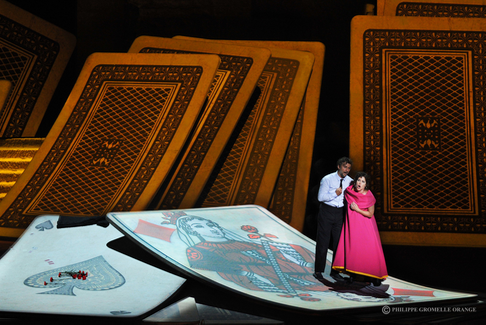 Kate Aldrich as Carmen, Jonas Kaufmann as Jose, Act IV
Kate Aldrich as Carmen, Jonas Kaufmann as Jose, Act IV
Photo copyright Abadie, courtesy of the Chorégies d'Orange.
Mr. Désiré, who gave us a splendid Tosca in Marseille last spring, evidently determined that the 300 foot expanse of the Théâtre Antique stage prevented all possibility of realizing the physical drama messieurs Meilhac, Halévy and Bizet had imagined. His solution was to make Carmen an oratorio, the identically costumed choristers frozen in blocks, the only physical actions were changing the placements of the famous scenes from one playing area to another (delimited by the surfaces of several huge face-up playing cards, a scattered deck being Mr. Désiré’s scenic concept).
All was not lost however because we did have the fine Don Jose of Jonas Kaufmann. Not that this tenorissimo is a real Jose — his voice is heroic, his delivery refined, his musicianship impeccable. Mr. Kaufmann is a remarkable singer with technique that allows him opportunity to explore and vocally exploit roles that are successful even when delivered monochromatically. In some ways Mr. Kaufmann and conductor Franck were an extraordinary musical match. Like conductor Franck he achieved an elegantly expanded rather than an eloquent performance.
Physically Mr. Kaufmann’s Jose was scruffy and well acted, hardly the handsome matinée idol of his publicity photos.
Micaëla was sung by 50 year-old Inva Mula, her great experience and confidence triumphing above the over-refined pit, her “Je dis” expansively and knowingly delivered diva style. It was deservedly well appreciated by the audience. Escamillo was sung by Kyle Ketelsen, the Aix Festival’s nimble Leporello and Figaro. He brought a lively wit to this Escamillo that was beyond the scope of this oratorio context. One can only dream of Mme. Aldridge and Mr. Ketelsen in a theatrically informed Carmen in a small theater or maybe even in the huge Théâtre Antique with a conductor and stage director who know that opera is, well, opera.
Michael Milenski
Cast and production information:
Carmen: Kate Aldrich; Micaëla: Inva Mula; Frasquita: Hélène Guilmette; Mercédès: Marie Karall; Don José: Jonas Kaufmann; Escamillo: Kyle Ketelsen; Zuniga: Jean Teitgen; Le Dancaïre: Olivier Grand; Le Remendado: Florian Laconi; Moralès Armando Noguera. Orchestre Philharmonique de Radio France, choruses of the operas of Angers-Nantes, Avignon and Nice, Maîtrise (childrens chorus) of the Bouches-du-Rhône. Conductor: Mikko Franck; Mise en scène, décors, costumes: Louis Désiré; Lighting: Patrick Méeüs. Théâtre Antique, Orange, France, July 11, 2015)
image=http://www.operatoday.com/Carmen_Orange1 - 1.png
product=yes
product_title=Carmen in Orange
product_by=A review by Michael Milenski
product_id=Above: Jonas Kaufmann as Don Jose
Photo copyright Abadie, courtesy of the Chorégies d'Orange
July 14, 2015
Léo Delibes: Lakmé
Certainly it is the melody of Lakmé’s Act 1 ‘Flower Duet’ which is the opera’s best-known number today — though this owes largely to its use as an advertising jingle for a certain airline. And, it was the gloriousness of the composer’s seamless melodic invention which was the highlight of this superbly sung new production of Lakmé at Opera Holland Park.
Delibes’s Lakmé is one in a long line of operas which pandered to contemporary French taste for, and fascination with, the Orient. Characteristically, too, the opera shows little concern for musical authenticity, imitating the stylised orientalism of predecessors such as Massenet’s La Roi de Lahore, Bizet’s Les pêcheurs de perles (for which Delibes had served as chorus master in 1863), Meyerbeer’s L’Africaine, and Félicien David’sLalla-Roukh , to name but a few. The première in April 1883 was a resounding success but the penchant for a naive exoticism informed by un-PC attitudes and values has waned, and contemporary stagings, certainly here in the UK, have been rare. OHP demonstrate an exceptional commitment in returning to the opera which they last staged in 2007.
Set during the British Raj, Lakmé is a colonial tale of star-crossed lovers. When Lakmé, the daughter of Brahmin priest Nilakantha (whose dangerous mix of fatherly love and religious fanaticism will propel the ensuing tragedy) falls in love with the English officer Gérald, she incites her father’s hunger for revenge against the occupying British. Gérald, returning her passion, neglects both his public and private obligations — as his friend Frédéric reminds him, his duties are to his nation and to his fiancée, Miss Ellen. Incensed by the sacrilegious intrusion of a foreigner into his sacred ground, Nilakantha swears vengeance: he asks Lakmé to sing, to attract the interloper, and stabs Gérald when the latter cannot hide his enchantment. As Lakmé fetches the water from the sacred spring that will restore Gérald and protect their love for perpetuity, Frédéric appears and recalls Gérald to his regimental duties — suppressing Indian insurgency — an appeal to which Gérald submits. When she returns, sensing that her lover will not prove true, Lakmé swallows the poisonous datura leaf. Too late, Gérald realises his terrible and tragic mistake: dying of love, he swallows the sacred water and vows his eternal devotion.
The opera is inherently rather static. As Saint-Saëns’s barbed comment suggests, Delibes’s musical language was dominated by his gift for melody; in contrast, his harmonies can be somewhat monotonous, the ‘exotic inflections’ clichéd, and the formal construction of the whole clunky and discontinuous.
Swiss-Turkish director Aylin Bozok and her designer, Morgan Large, do not overcome this dramatic inertness; indeed, they choose to emphasise the stillness and reverential calm, but while they exploit the expressive beauty of individual moments, they do not find a way to create convincing links between them. The set, though fairly minimal, is pretty to look at: placed centre-stage amid swirling ultramarine floor-drapes (they represent the sacred spring, although the cast occasionally fail to recall their symbolism and blithely wade through the ‘holy water’), the secret Hindu temple is an interlaced lotus-fretwork whose curved panels slide to reveal a gilded altar — a sort of grandiose aviary — in which Lakmé (and the dancer who signifies the priestess’s inner desires) appears, sacred and venerated. Howard Hudson’s cool-blue lighting design is occasionally tempered by rose-pink or honeyed-yellow beams which coat the consecrated shrine; but, in the first two Acts the prevailing scheme does little to distinguish between moonlight and dawn, between an eerie twilight or the vibrant heat of the mid-morning market scene which opens Act 2 — although, sudden splashes of glistening greens and rich purple do enliven Act 3.
Delibes is best known by modern audiences for his ballets, Coppélia (1870) and Sylvie (1876); the inclusion of several ballets within the score is not surprising, as such ballets played to his musical strengths and satisfied the penchants of contemporary Parisians. But, Bozok’s movement direction is as minimalist as the décor. The priest’s slaves, Mallika and Hadji — graced with a formal elegance — are a powerful visual presence. But, this approach works less well with the Chorus who, cloaked throughout in shapeless, insipidly coloured, hooded robes, are largely stagnant, arranged in formalised arrangements, their movements stylised. This is a pity as the Chorus sing with vigour and richness; but while Bozok captures the ritual dignity of the mystical scenes she neglects the saffron-hued warmth and vitality of the Orient.
Instead, there is a single dancer, Lucy Starkey, who serves as an embodiment of Lakmé’s emotional turbulence. Though there are some characteristically ‘oriental’ poses, Starkey’s extrovert, muscular movements are out of kilter with both the sinuous allure of the east and with the prevailing rituality and serenity of this production. While the solo dances were forcefully characterised and superbly executed, I found them disjunctive in dramatic and expressive terms — especially during Lakmé’s notoriously difficult ‘Bell aria’, where the jerky, leaping excesses were distracting.
Part of the problem is that Delibes’s opera is constructed to a formula whose fashionable influence has since waned. To be fair, the venue itself does not help. Hudson’s blue colorations lack impact in the summer sunshine which lingers throughout Acts 1 and 2, seeping through the side-openings of the marquee. And, it’s hard to establish a reverential stillness when the peacocks are shrieking, and the airplanes and helicopters are roaring overheard (creating a din which, at one point, made Lakmé’s distress at the ‘strange murmurings’ in her heart a wry understatement). Add the invasive pigeons and the even more disruptive interruptions of late-comers (not to mention a bellicose altercation over a mobile phone which marred the opening moments) and one could sympathise with the directorial difficulties.
Fortunately, strong singing more than compensated for the above misgivings. It was evident why Welsh soprano Fflur Wyn won the title role, as soon as she commenced the sonorous vocalise of the ‘Légende’ which precedes the pyrotechnical ‘Bell aria’ in Act 2. The demands made by the latter are indeed legendary, and Wyn’s precision and animation were noteworthy (she was admirably accompanied by accurate harp and glockenspiel). She swept thrillingly up to her high E, and had the stamina and strength to see the vocal fireworks through to their close.
But, Wyn’s performance was a little uneven: the tone at the start of Act 1 was rather thin, and she occasionally lacked the sensuousness of line that she found later, in her Act 2 and 3 duets with Robert Murray’s Gérald. There were some tuning problems too, especially at the start of Act 1. It should not matter that, blonde-haired and dressed in attire which suggested Western rather than Oriental sensuousness, Wyn didn’t ‘look’ like a Hindu priestess — but the visual mis-match did add to staging’s the general lack of persuasiveness.
Robert Murray’s may not be the most silkily honeyed of tenors, but each phrase was flawlessly delivered, shaped with musical and dramatic intelligence and sensitivity. There was great tenderness in this portrayal: one could almost believe that — despite the disappointing let-down of his ‘second thoughts’, and in contrast to Pinkerton — he really did love his oriental beloved. The Act 3 Cantilène, ‘Lakmé! Lakmé! Ah! Viens dans la forêt profonde’, was a highlight of the evening, the high-lying lines proving no obstacle, projected without strain. Overall, Murray imbued Gérard with moral dignity: no mean feat.
Nicholas Lester was excellent asFrédéric. Lester has made a good impression in recent stagings at OHP’s — in Il barbiere di Siviglia, first as Fiorello and then as the eponymous barber — and here he once again demonstrated a firm, appealing baritone. With his stiff uprightness, moral self-righteousness and limited emotional awareness, this Frédéric reminded me — especially when he appeared in uniform to call Gérard to his duty (that is, repressing the Hindu uprising) — of Lechmere in Britten’s Owen Wingrave, a character who through his own short-comings reveals the more extraordinary depths and qualities of his friend.
As Mallika, Katie Bray blended her mezzo — which is supple and full of tone — alluringly with Wyn’s undulating lines in the ‘Flower Duet’. Bray has a lovely clean sound and projects strongly; it was a shame not to have the opportunity to hear more of her. David Soar was solid as Nilakantha. Though his tone was initially a little uncentred, he grew in stature through Act 2 and his solemn delivery, together with the magisterial richness and dark colours of his attractive bass, suggested both menace and authority. As Lakmé’s loyal servant, Hadji, Andrew Dickinson sympathetically sheltered the wounded Gérald in the forest, and sang his Act 3 aria with a true, lyrical line.
The libretto’s presentation of the Anglican oppressors as overbearing pompous prigs creates musico-dramatic problematic, for it’s not an angle that Delibes chooses to emphasise and the more prudish utterances of the three ladies — Ellen, Rose and Mrs Bentson — can come across with all the sophistication of the comic patter of G&S: indeed, in some of their utterances they did have the mark of ‘three little maids’. But, that said, Maud Millar showed considerable promise as Ellen — bright-toned, especially at the top, and technically assured; while Fleur de Bray’s Rose had comic presence and sparkle. As Mrs Bentson, Fiona Kimm showed her vocal experience, even if directed towards caricature as the ‘Englishwoman abroad’.
Across the cast, the French was not always clearly discernible; moreover, the surtitles were irritatingly mundane — and at times jarringly anachronistic: one cannot imagine the Hindus selling their wares in the market place, in the late-nineteenth century, assuring the English that ‘we won’t rip you off’.
Given the fairly small forces (especially of strings), the City of London Sinfonia sometimes struggled to summon the glistening refinement evoked by Delibes’s orchestration, but there was much fine playing, most notably from the flutes (doubling piccolo with sparkling brightness in the military march), oboe, bassoon, cellos and timpani. There was certainly considerable attention to the detail, and a sustained, thoughtful expressiveness to the instrumentalists’ phrasing; the individual voices could be clearly heard, as if characters in the opera — and it certainly sounded as if the players cared about the music. But, while conductor Matthew Waldren was in full command of the details, his approach was, I felt, overly fierce and forthright; Lakmé was performed at the Opéra-Comique in April 1883, two weeks after the death of Wagner, and while the shadow of Tristan might be felt in the love-death potion motif, a more limpid lethargy would at times have been preferable.
Despite these misgivings, though, Opera Holland Park put on a performance that is worth catching for its rarity value and lyrical vocalism.
Claire Seymour
Cast and production information.
Lakmé, Fflur Wyn; Gérald, Robert Murray; Nilakantha, David Soar;
Frédéric, Nicholas Lester; Mallika, Katie Bray; Ellen, Maud Millar; Rose,
Fleur de Bray; Mrs Bentson, Fiona Kimm; Hadji, Andrew Dickinson; A Fortune
Teller, Timothy Langston; A Chinese Merchant, Michael Bradley;
Pickpocket/Bohemian, Joseph Kennedy; Dancer, Lucy Starkey; Director, Aylin
Bozok; Conductor, Matthew Waldren; Designer, Morgan Large; Lighting Designer,
Howard Hudson; Mask Design, Ela Xora; City of London Sinfonia and the Opera
Holland Park Chorus. Opera Holland Park, London
Thursday 9th July 2015.
Further performances take place on July 11, 15, 18, 23, 27 (The Christine Collins Young Artists performance), 29 and 31.
image=http://www.operatoday.com/FS-Lakme-e1420651973632.png image_description=Lakmé at Opera Holland Park [Image by Opera Holland Park] product=yes product_title=Léo Delibes: Lakmé product_by=A review by Claire Seymour product_id=Above: Lakmé at Opera Holland Park [Image by Opera Holland Park]July 9, 2015
The ‘Other’ Così
But, the meddling of a ‘master-of-ceremonies’ transposes their personalities and tangles the pairings: confusion and consternation reign as the mischief-maker carries out his ‘experiment’ with the antithetical couples. Sounds familiar? However, this is not Così fan tutte, the third of the Mozart-Da Ponte collaborations, but Antonio Salieri’s La Grotta di Trofonio, which had its first public performance at the Burgtheater in Vienna in October 1785 and became a huge popular success.
1780s Vienna was a network of alliances, allegiances and jealousies. Men of letters such as Lorenzo Da Ponte and Giambattista Casti joined the leading composers of the day – Martín y Soler, Mozart and Salieri – in competing for the cultured Emperor Joseph II’s patronage and favour. Friendships were formed, hostilities nurtured; grudges born and reconciliations engineered.
Bampton Classical Opera previews their 2015 production of Salieri's "Trofonio's Cave' (La Grotta di Trofonio)
Though subsequently demonised by Pushkin and Peter Shaffer, it was Salieri, Emperor Joseph II’s Hofkapellmeister, who was most esteemed by his contemporaries. In his somewhat unreliable Memoirs, Da Ponte described Salieri as ‘a most cultivated and intelligent man […] whom I loved and esteemed both out of gratitude and by inclination’; but when their first collaboration, Il ricco d’un giorno, flopped in 1784 the composer wasted no time in blaming his literary partner, declaring that he would sooner cut off his own fingers than accept another libretto from Da Ponte. The success of Mozart’s Il nozze di Figaro in May 1786 seems to have encouraged Salieri to reconsider his assessment of Da Ponte’s literary skills. Two extant trio drafts discovered by musicologist John Rice in the National Library in Vienna suggest that Salieri began work on a setting of the Così libretto in the late 1780s but, uncharacteristically, abandoned the work: perhaps his dispute with Da Ponte concerning the librettist’s pasticcio L’ape musicale was the cause behind his decision, or simply waning creativity?
Whatever, it was Mozart who was to pick up the discarded text. How ironic, then, that Salieri’s own La Grotta di Trofonio, with a libretto by Casti, seems to anticipate the satirical artifice of Mozart’s comedy of 1790. And, beyond the meticulously wrought symmetry of both operas, there are striking similarities between some of the ensembles. Even the casts overlapped: having taken the role of Aristone, the girls’ father, in La Grotta, four years later the veteran buffo bass Francesco Bussani stepped into Don Alfonso’s shoes, while Francesco Benucci swapped the role of Salieri’s magician, Trofonio, for Mozart’s Guglielmo. Cast as the contemplative Artemidoro by Salieri, tenor Vincenzo Calvesi was Mozart’s first Ferrando; restored to his serious self, Artemidoro sings a cavatina, ‘Sognai, o sogno ancor?’, which has much in common with Ferrando’s ‘Un’aura amorosa’.
Indeed, Così – like Salieri’s opera, an elegant essay on the deceptiveness of desire – might be said to engage in a musical and dramatic ‘conversation’ with La Grotta. But, in the words of Jeremy Gray, director of Bampton Classical Opera, “Does Mozart pay some sort of homage to Salieri, or is it rubbing salt into wounds …?”
Bampton Classical Opera perform Salieri’s La Grotta Di Trofonio – directed by Jeremy Gray, conducted by Paul Wingfield, with a new English translation by Gilly French and Jeremy Gray – at The Deanery Garden, Bampton on 17 and 18 July; at The Orangery Terrace, Westonbirt School on 31 August; and at St John's, Smith Square, London on 15 September 2015.
Claire Seymour
image=http://www.operatoday.com/Italian_Garden.png image_description=The Italian garden at Westonbirt product=yes product_title=The ‘Other’ Così product_by=By Claire Seymour product_id=Above: The Italian garden at WestonbirtJuly 8, 2015
Scalia/Ginsburg Premiere at Castleton Festival
The Castleton Festival in northern Virginia will premiere his opera Scalia/Ginsburg on July 11, 2015. He based it on the writings of two justices who have maintained a friendship for many years despite a wide divergence of opinion: Antonin “Nino” Scalia and Ruth Bader Ginsburg.
Both justices grew up in New York City and attended Ivy League schools. The positions they took upon finishing graduate school show their viewpoints. Scalia joined the Nixon Administration and also founded the strictly conservative Federalist Society. Ginsburg joined the American Civil Liberties Union and led its Women’s Rights Project.
Outside of business hours, their mutual respect allows them to enjoy each other’s company. In former years their meetings were made even more fun thanks to the charming personality and excellent cooking of the late Martin Ginsburg. Not only do Scalia and Ginsburg still dine together, they attend the opera and even vacation as a duo.
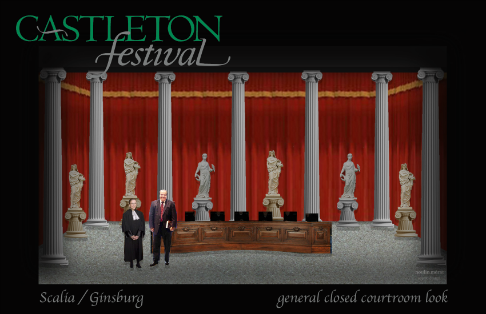
They met in the early 1980s when they were judges on the US Court of Appeals. Scalia was appointed to the Supreme Court in 1986 and Ginsburg in 1993. Essentially, they disagree on whether the Constitution is living and evolving or dead to change. Scalia believes that it still means what the founding fathers said it meant when they adopted it. He fears that otherwise it could be subject to whimsical changes. Ginsburg believes that its framers meant to allow it to be adapted to the times. She says that his originalist approach is not faithful to the idea of “We the People.” She maintains that the Constitution has to expand to cover more than the white property-owning men who were once “We the People.”
Scalia begins in strict adherence to the text of the composition. He says, “She likes opera and she’s a very nice person. What’s not to like?--Except for her views on the law!” Ginsburg recalls the first time she heard “Nino” speak at a law conference. “I disagreed with most of what he said but loved the way he said it.” Ginsburg believes in a “living Constitution” that can be reinterpreted as times and customs change. She thinks that the constitution’s guarantee of “equal protection” under the law evolves with society.
Composer-librettist Wang began to think of Scalia as an operatic character when he read the judge’s dissenting opinions as a law student at the University of Maryland. To him Scalia’s passionate opinions were material for rage arias. Wang was invited to the U.S. Supreme Court to present excerpts from Scalia/Ginsburg. The Glimmerglass Festival, Washington National Opera, Maryland Opera Studio, The National Constitution Center, Stanford Arts Institute and Stanford Law School are among the organizations that have also presented selections from Scalia/Ginsburg.
The plot involves the justices appearing before a higher power. Scalia and Ginsburg must pass three cosmic trials to secure their freedom. Will they have to agree on the Constitution? They will give their opinions in song, reveling in references to well known operas as they sing sparkling comments on music and law.
Originally, one statue, The Commentator, was to come to life in a manner similar to the Commendatore in Mozart’s Don Giovanni. Because the opera is a comedy, set designer Julia Noulin-Mérat thought it might be fun to have five more statues comment on the proceedings while illustrating the legal jargon that the justices and lawyers use in court. Stage Director, Maria Tucci developed the idea with costume designer, Lara de Bruijn and named the other statues: Equity, Ethics, Fairness, Rationality, and Religion.
Performances at the Castleton Festival are on July 11, 17, and 19, 2015. US Supreme Court Justice Ruth Bader Ginsburg will speak about the new opera at its premiere which follows a performance of Maurice Ravel's L’heure espagnole (The Spanish Hour). That performance, however, is already sold out. As of this writing tickets are still available for the other two shows. The production’s opening night performance is also being live streamed online at the Castleton Festival's website.
Maria Nockin
Cast and production information:
Composer and Librettist, Derrick Wang; Conductor, Salvatore Percacciolo; Director, Maria Tucci; Set Designer, Julia Noulin-Mérat; Costume Designer, Lara de Bruijn; Lighting Designer, Tláloc López-Watermann; Justice Ruth Bader Ginsburg, Ellen Wieser; Justice Antonin Scalia, John Overholt; Commentator, Adam Cioffari; Statues: Asha Crandall, Cristin Colvin, Lauren Stocker, Jorge Belloni, and Anthony LaFrinier.
image=http://www.operatoday.com/fairness-2.png
image_description=The Statue Called Fairness [Courtesy of Castleton Festival]
product=yes
product_title=Scalia/Ginsburg Premiere at Castleton Festival
product_by=By Maria Nockin
product_id=Above: The Statue Called Fairness
Images courtesy of Castleton Festival
July 7, 2015
Falstaff, Royal Opera
Trollies of detritus in the old rogue’s bed-chamber testify to several days of epicurean revelling, the bourgeoisie of Windsor are a quartet of ‘ladies who lunch’, Fenton is a hotel waiter, Falstaff’s thwarted assignation with Alice Ford takes place in the kitchen; even the stable horse who in Act 3 indifferently watches over Falstaff’s glum reflections on the grim state of the world gets in on the act, munching stoically from a hay-bag. Such gastronomic excess seems fitting for an opera whose protagonist avows (in Henry IV Part 1), ‘let a cup of sack be my poison’ and faces his battles with the rallying self-reassurance, ‘To the latter end of a fray and the beginning of a feast/ Fits a dull fighter and a keen guest’.
Carsen transports us from the end of the first Elizabethan era to the beginning of the second — the ‘Golden Age’ of the 1950s — an updating designed (so Ian Burton, Carson’s dramaturg explains) to highlight the loosening of social and class hierarchies characteristic to both periods in which the diminishing aristocracy were challenged by the emergence of ‘new money’ and a rising working-class. Paul Steinberg’s terrific sets are a riot of retro memorabilia — at least, in the opening two Acts — and are matched for period panache by Brigitte Reiffenstuel’s colour-clashing costumes. The Garter Inn is no longer a shabby hostelry but a mid-market country hotel, its panelled walls decorated with the antlered prizes of hunting parties past, and whose guest are a bunch of nouveau-riche social climbers. From the gentleman’s lounge we move to the Fords’ formica kitchen, where the bright yellow colour scheme and plethora of gadgets are evidence of the couple’s consumerist optimism.
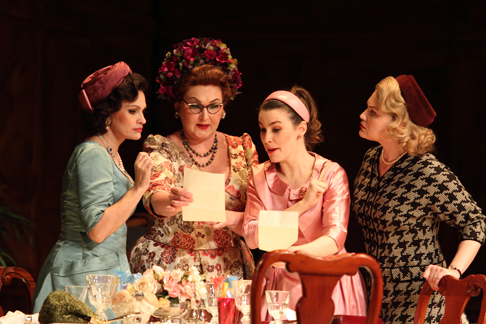 Ainhoa Arteta as Alice Ford, Agnes Zwierko as Mistress Quickly, Anna Devin as Nannetta, and Kai Rüütel as Meg Page
Ainhoa Arteta as Alice Ford, Agnes Zwierko as Mistress Quickly, Anna Devin as Nannetta, and Kai Rüütel as Meg Page
Amid these fashion-conscious upstarts and entrepreneurs, Sir John is a figure of fun and fading fortune: a foul-mouthed reprobate whose waistband expands as his social standing and purse deteriorate. He may don country tweeds and a scarlet hunting frock-coat to impress the ladies, but it’s the filthy long-johns of the opening scene which are the best fit.
The visual apparatus is impressive, but Carsen does not neglect the stagecraft which responds neatly to Verdi’s musical structures. The movement is sometimes frenetic but always just the right side of chaos: and the ransacking of the domestic order by Ford and his grey-suited employees, as they search in vain for his reputedly adulterous wife and the back-stabbing Falstaff is a scream. But, there are moments of intimacy too — significantly aided by Peter Van Praet’s lighting design — which create oases of calm amid the clamour. Fenton and Nannetta snatch brief moments of private tenderness between the courses of a public meal; Ford’s jealous rant is cloaked in an eerie blue half-light.
However imaginative and slick the direction, Verdi’s opera stands or falls by its protagonist, and it’s hard to imagine a baritone better suited to, or more astute in, the role than Ambrogio Maestri, here returning to the role he played in the 2012 first production. In the role-playing scene in Henry IV Part 1, Falstaff (play-acting King Henry IV) describes himself as a ‘virtuous man ... A goodly portly man, i’ faith, and a corpulent; of a cheerful look, a pleasing eye and a most noble carriage’ only to have his pomp punctured by Hal’s accusation that the old Knight is an ‘abominable misleader of youth, Falstaff, that old white-bearded Satan’. Maestri, through his attention to dramatic and musical detail reminds us how difficult it is to ‘pigeon-hole’ Sir John: is he a hard-headed conman or a harmless comic buffoon; a self-gratifying glutton or an aging ‘gentleman’ surrounded by uncaring hangers-on and chancers?
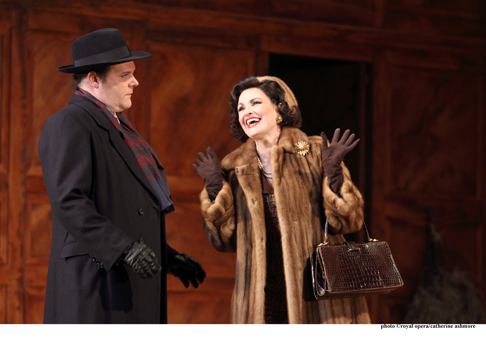 Roland Wood as Ford and Inhoa Arteta as Alice Ford
Roland Wood as Ford and Inhoa Arteta as Alice Ford
The ‘fat rogue’ is defined by his corpulence: without it, he fears ‘my skin hangs about me like an old lady’s loose gown; I am withered like an old apple-john … I shall be out of heart shortly, and then I shall have no strength to repent’. Maestri has the physical and vocal presence, and the relaxed demeanour, to convey Sir John Falstaff’s mythic status and epic bulk, as well as the thoughtfulness and insight to offer subtleties too — to hint at, though not over-play, the complexities, darkness and pathos, beneath the affectionate parody. He may have embodied the aging Knight of the Garter countless times but there was no sense of routine or staleness. We had bombast and bathos; felt repugnance and pity. Maestri is a big man, but he is nimble of footwork and of voice. His is a powerful baritone and whether yelling for ‘another bottle’ or damning the tattered scroungers who linger like scavenging seagulls in Falstaff’s wake, Maestri boomed generously; but he recognised the moments to hold back, occasionally retreating to almost a whisper, and it was at such times that a more vulnerable Sir John showed himself. The sheer beauty of tone, particularly at the top, was beguiling; sufficient to sweep aside any moral misgivings about Falstaff’s selfish debauchery. No less impressive than the vocal control and variety was Maestri’s relish for the words — his appetite for the nuances of the text was equal to the Fat Knight’s craving for capon and Chianti.
When the comic temperature is high, there is always a risk of caricature, but the splendid cast served up real characters whose ostentations and affections were tempered by humanity. Of the merry wives of Windsor, Ainhoa Arteta’s Alice Ford excelled; Arteta relished Verdi’s luxurious melodies, which she coated with the sheen of a pearl, floating glisteningly in the ensembles. As Mistress Quickly, Agnes Zwierko was a busy stage presence and worked hard vocally, colouring her ‘Reverenza’ with faux-veneration; although she needed a bit more fruity contralto depth to really vivify the role, Zwierko acted superbly, especially when delivering the missives of deception and when hoodwinking Falstaff at the Garter Inn.
Kai Rüütel’s Meg Page exhibited a warm vocal sensuality, but it was Anna Devin’s Nannetta who took one’s breath away. Nannetta’s every phrase drew one’s attention, as the floaty lines soared with power and lyricism. I loved the way in her first romantic exchange with Fenton in Act 1 that the high Ab first established Nannetta’s clarity of conviction, then retreated demurely, before surging with burning passion. Such vocal control suggests real artistry and musico-dramatic intelligence.
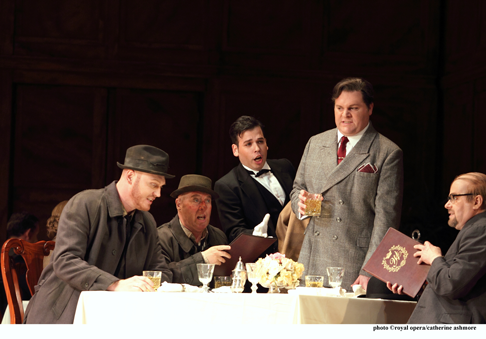 Lukas Jakobski as Pistol, Alasdair Elliott as Bardolph, Luis Gomes as Fenton, Roland Wood as Ford, and Peter Hoare as Dr Caius
Lukas Jakobski as Pistol, Alasdair Elliott as Bardolph, Luis Gomes as Fenton, Roland Wood as Ford, and Peter Hoare as Dr Caius
As Bardolph, Alasdair Elliott’s tenor was agile and focused, and the mis-matched heights of Bardolph and Pistol (Lukas Jakobski) created immediate visual humour; but there is a darkness about the gangsters’ loitering with intent for ill-gotten gain. The pair are tattered scroungers who will steal a diner’s handbag while passing them their dropped napkin, and even find rich-pickings in the Fords’ dirty laundry: one feels that Sir John’s filthy underwear would be filched if the opportunity arose. Peter Hoare’s Dr Caius was characteristically precise and strong.
Roland Wood was engaging as Ford, particular when as ‘Master Brook’ - a Stetson-sporting Texan tycoon — he bantered with Maestri: this was one of the evening’s comic highlights. Wood was able, however, to tip strikingly from jape to jealousy, and his long soliloquy was intense and compelling. Jette Parker Young Artist Luis Gomez was a suave-toned Fenton, but he needed a bit more dramatic vivacity to match Devin’s resolute Nannetta.
Things moved swiftly, but not precipitously, along under the direction of conductor Michael Schønwandt, who launched the opening moments with dazzling bravura and just about kept the complicated finales of Act 1 and 2 under control. The ROH Orchestra were on characteristically good form, although given the way Verdi’s score tells the tale, they occasionally seemed in danger of being over-shadowed by the mad-cap activity on stage. But, woodwind solos - especially clarinet and bassoon — came neatly to the fore, and the horns demonstrated nimbleness and sweetness of tone. The double basses kicked off Act 3 with a delicious growling; the first violins’ steep and speedy tumbles were cleanly executed.
If there is any weakness in Carsen’s direction, it is in the final Act, where the munching horse distracts from the pathos of Falstaff’s post-Thames-dip lamentations, sung by Maestri on a heap of straw at the back of the stage, and where the panelled walls do not sufficiently summon the magic and mystery of Windsor Great Forest, despite the effusions of dry ice. But, as the ‘Queen of the Fairies’, Devlin provided mesmeric musical compensation in ‘Sul fil d'un soffio etesio’, calling the fairies from their hiding place and commanding them to dance; and the final image of a be-horned Falstaff rolling along the gang-plank banqueting table, the target of black-cloaked, knife-wielding figures, was a potent one. In the closing moments of the opera, Carsen restored what might, given the forest setting, be termed a spirit of pastoral harmony and reconciliation. As Boito and Verdi remind us, he who laughs the best is he who laughs last; a fitting sentiment for the audience as we left the theatre with a smile on our faces.
Claire Seymour
Cast and production information:
Sir John Falstaff, Ambrogio Maestri; Alice Ford,Ainhoa Arteta; Ford, Roland Wood; Nannetta, Anna Devin; Fenton, Luis Gomes; Mistress Quickly, Agnes Zwierko; Meg Page, Kai Rüütel; Dr Caius, Peter Hoare; Bardolfo, Alasdair Elliott; Pistol, Lukas Jakobski; Director, Robert Carsen; Conductor, Michael Schønwandt; Set designs,Paul Steinberg; Costume designs,Brigitte Reiffenstuel; Lighting design,Robert Carsen; Lighting design, Peter van Praet; Royal Opera Chorus; Orchestra of the Royal Opera House. Royal Opera House, Covent Garden, London, Monday 6th July 2015.
image=http://www.operatoday.com/2714ashm_320-copy-AMBROGIO-MAESTRI-AS-FALSTAFF-%C2%A9-ROH.--CATHERINE-ASHMORE.png image_description=Ambrogio Maestri as Falstaff [Photo © ROH/Catherine Ashmore] product=yes product_title=Falstaff, Royal Opera product_by=A review by Claire Seymour product_id=Above: Ambrogio Maestri as FalstaffPhotos © ROH/Catherine Ashmore
Die schweigsame Frau, Munich
Quite why is anyone’s guess; no one, I assume, would declare Die schweigsame Frau a greater work than Elektra, but it is clearly a better work than so many that continue to hold the stage. German theatres are different, of course, not least those associated with Strauss personally, so to see Strauss’s collaboration with Stefan Zweig and, at one remove, Ben Jonson, a visit to the Munich Opera Festival seemed like a good idea.
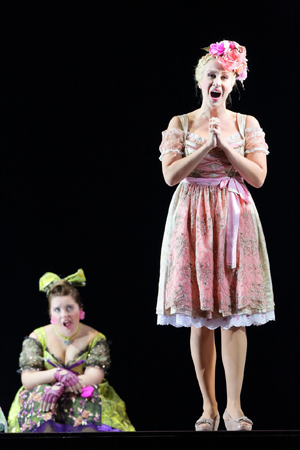 Tara Erraught as Carlotta and Brenda Rae as Aminta
Tara Erraught as Carlotta and Brenda Rae as Aminta
And so it was. One could not reasonably have hoped to hear Strauss in better hands. Not only could I find no grounds to fault Bavarian State Orchestra — not that, in imitation of the third act’s divorce proceedings, I was attempting to find such grounds — the orchestra reaffirmed its credentials as a Strauss orchestra to be spoken of in the same breath as Dresden and Vienna, and arguably more reliable than either, certainly more so than the latter. Precision and warmth — though not too much — were very much the hallmark of this performance, wisely guided by Pedro Halffter, who seemed keen to impart to his account a sense of, if not quite Neue Sachlichkeit, then at least of something that made Strauss’s writing here particular rather than generalised. Pacing was impeccable, quasi-autonomous musical structures coming fruitfully into contact with verbal demands: the sort of thing one longs for, generally in vain, in Rossini. The Straussian orchestral phantasmagoria is never far away, of course, but there is perhaps less overt dazzle in much of the score than in, say, Rosenkavalier or Elektra; Halffter and the orchestra appreciated its subtleties and responded to them in equally subtle yet undoubtedly sure fashion.
I doubt that Brenda Rae’s Aminta could be bettered in any theatre today (although how would one know?) Just as sure of note and line as the orchestra and with greater, contrasting warmth, especially at those wonderful revelations, through the disguise of Timidia, of the fundamental humanity of Aminta, this was a performance to savour. Much the same could be said of her partner in crime — and love — Peter Sonn’s splendidly lyrical, often imploring Henry. Franz Hawlata’s Morosus was very much a character portrayal: too many notes, as it were, lacked a little when it came to the demands of intonation. But such was Hawlata’s identification with and communication of the role, it would be churlish to complain unduly; the audience responded warmly, and it was right to have done so. The quicksilver vocal and dramatic qualities of Nikolay Borchev’s Barber — despite the hideous green tracksuit he initially had to wear — were rightly appreciated by the Munich audience too. Okka von der Damerau captured to near-perfection the disapproving, ultimately amusing qualities of the Housekeeper. There was depth in the casting too: splendid rivalry to Timidia came from Tara Erraught (with, insofar as I could tell, a fine line in Bavarian dialect) and Elsa Benoit. There was indeed an excellent sense of company: no one disappointed and almost everyone shone.
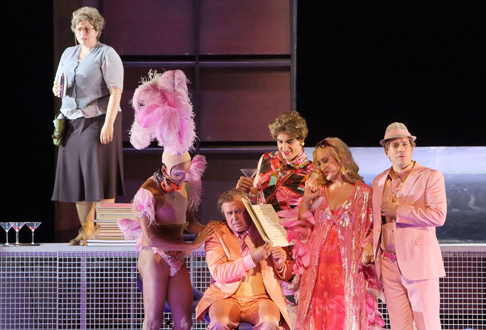 Okka von der Damerau as Haushälterin, Franz Hawlata as Sir Morosus, Tareq Nazmi as Farfallo, Brenda Rae as Aminta, and Daniel Behle as Henry Morosus
Okka von der Damerau as Haushälterin, Franz Hawlata as Sir Morosus, Tareq Nazmi as Farfallo, Brenda Rae as Aminta, and Daniel Behle as Henry Morosus
Barrie Kosky’s production: well, it was considerably better than his Berlin Figaro. But I cannot help but think that his matching of high camp — the tasteless pink designs of the first part of the third act, splendidly realised on their own terms by Esther Bialas — and custard-pie slapstick is not really a match for Strauss, or for Zweig. The subtle, even sometimes not-so-subtle, æstheticism of both artists may well benefit from deconstruction. But might not a production that takes to heart the circumstances of the opera’s composition — this, after all, was the opera occasioning Strauss’s fateful letter to Zweig, intercepted by the Gestapo, which led to Goebbels having the composer resign from Presidency of the Reichsmusikkammer — offer a more fruitful, deeper (yes, I know, how Teutonic of me!) mode of questioning? There is no doubting the skill with which Kosky and his production team accomplish their vision; I wish, though, that I could discern more in the vision itself. According to Kosky, quoted in the programme, ‘We have placed our protagonist in a world which swings [schwankt]uncertainly between Mel Brooks, the Muppets, and Vienna’s Josefstadt [Theatre].’ Make of that what you will.
Even for those of us who remained sceptical about the production, however, there was much to enjoy, for which many thanks should go to the Bavarian State Opera. This would surely make an interesting prospect for ENO, whose Strauss record has recently been anything but conspicuous, to bring to London. Now, how about an enterprising company offering us Salieri’s Angiolene, also based (loosely) on Jonson’s Epiocene? Or even a hearing for Mark Lothar’s 1930 Lord Spleen, written for Dresden? (Does anyone know the music of Lothar, a Schreker pupil whom Max Reinhardt enlisted as Music Director for Berlin’s Deutsches Theater in 1933, whether for this or for anything else? I freely admit that I do not.) George Antheil’s Volpone, which apparently owes a good deal to Zweig’s German adaptation of Jonson’s play, also awaits revival. And yes, more Strauss would be much appreciated too: Feuersnot, Friedenstag, Die Liebe der Danae, etc., etc. Opera houses of the world, unite: you have nothing to lose but Timidia’s timidity!
Mark Berry
Cast and production information:
Sir Morosus: Franz Hawlata; Housekeeper: Okka von der Damerau; Barber: Nikolay Borchev; Henry Morosus: Peter Sonn; Aminta: Brenda Rae; Isotta: Elsa Benoit; Carlotta: Tara Erraught; Morbio: Christian Rieger; Vanuzzi: Christoph Stephinger; Farfallo: Tareq Nazmi; Papagei: Airton Feuchter-Dantas. Director: Barrie Kosky; Designs: Esther Bialas; Lighting: Benedikt Zehm; Dramaturgy: Olaf A. Schmitt; Bavarian State Opera Chorus (chorus master: Sören Eckhoff); Bavarian State Orchestra/Pedro Halffter (conductor). Nationaltheater, Munich, Sunday 5 July 2015.
image=http://www.operatoday.com/csm_11_3ed823933a.png image_description=Brenda Rae as Aminta and Franz Hawlata as Sir Morosus [Photo courtesy of Bayerische Staatsoper] product=yes product_title=Die schweigsame Frau, Munich product_by=A review by Mark Berry product_id=Above: Brenda Rae as Aminta and Franz Hawlata as Sir MorosusPhotos courtesy of Bayerische Staatsoper
Abduction and Alcina at the Aix Festival
Heightened security was evident with the search of all small hand bags entering the theaters, large bags and backpacks were prohibited.
Before the Entführung Aix Festival general director Bernard Foccroulle (foe-crew-yeh) appeared before the audience to make an apology for the production by Austrian director Martin Kušej (koooo-shy) who may have insisted, at least should have demanded that Mr. Foccroulle explain why the festival had eviscerated his production.
Mr. Foccroulle evidently wished to avoid a confrontation such as had occurred a few nights earlier when during a performance the Covent Garden Guillaume Tell audience forcefully objected to graphic violence. Mr. Foccroulle announced that images which might be unsettling to the spectators had been expunged. In some ways the curtain speech was a brilliant move. Once into the first scene (buried in sand up to his neck, only Pedrillo’s un-embodied head saw much of the first act) we knew the specific image in question and it haunted us for three hours before lightening struck.
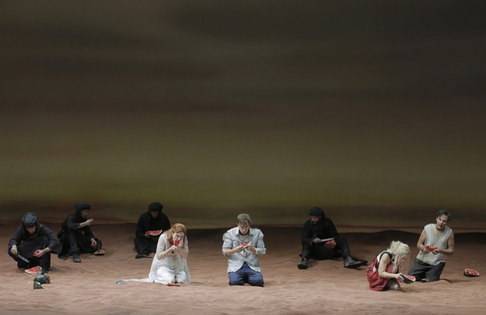
Jane Archibald as Konstanze and Daniel Behle as Belmonte
All Abduction photos copyright Pascal Victor, courtesy of the Aix Festival.
Make no mistake. The evening was not about Mozart even though the oeuvre of this Austrian composer is the raison d’être of the festival. It was about brutality.
After director Kušej’s Covent Garden Idomeneo fiasco (2013) there could only have been trepidation as to just what he would subject Entführung. In London (and in Lyon where I saw his Idomeneo production) Mr. Kušej found not the liberation granted by 18th century ideals but the revelation that citizens will never be free as long as there is religion. In Entführung the message is sort of the same, except here it emerges in powerful personal terms as the pasha Selim Bassa, played by veteran Austrian actor Tobias Moretti became the central focus of this theater production.
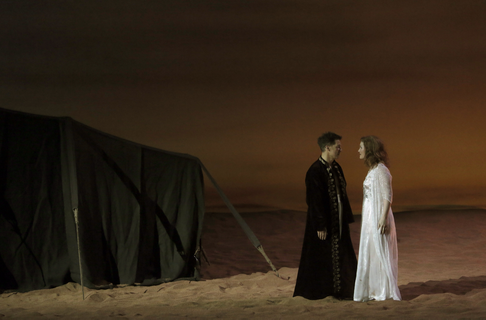 Tobias Moretti as the Pasha, Jane Archibald as Konstanze
Tobias Moretti as the Pasha, Jane Archibald as Konstanze
The Pasha is resident of a lone military tent along with a band of Uzi bearing soldiers in a vast desert where sand flowed horizonlessly into a featureless sky. It was in digital high definition color resolution, more real than real — the production was of utmost contemporary technical theatrical sophistication.
The soldiers and their lieutenant Osmin were completely covered in Islamic State black, the Pasha however was in a fashionable, sophisticated Western business suit. Except when he was in loin cloth, whipping himself for love with thorny stemmed roses in a twisted take on the Islamic self flagellation ritual.
The first part of the evening (the escape quartet as its finale) was tough going, having to reconcile irritation at the Foccroulle apology with the heavy handed, blatantly obvious, patently political imagery while dealing with Mozart’s famed musical enlightenment. The second part of the evening left the music in the dust in a series of mostly soundless flash scenes. No more opera, now pure theater. The triumphal chorus sung from the pit, Osmin threw the blood covered white gown of Konstanze — though without her severed head — at the feet of the visibly shaken Pasha. It was big and it was profound.
At the intermission audience comments overheard were mostly that there was too much dialogue. In fact the exposed head of the buried Pedrillo itself tried to move things along suggesting to Belmonte that he stop the “fucking talking and start singing” (or maybe it was the other way around). As the primary enemy of Islam seems to be the Americans the production made much use of such colloquial speech in the dialogues (three of the four lovers were actual Americans), alternating with the Pasha’s hoch theatrical Deutsch declamation and Gottlieb Stephanie’s pretty German verse as set by Mozart.
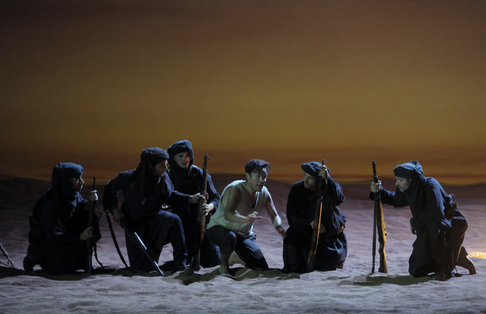 David Portillo as Pedrillo
David Portillo as Pedrillo
There was simply too much singing. French conductor Jérémie Rhorer made the mighty Freiburger Barockorchester into a delightful salon orchestra, imposing lightness and a pleasing elegance to the overture. This informal approach was imposed on the singers as well, the arias delivered quite intimately, in stark contrast to the far more powerful rhetoric of the production. The opera itself was the boring if a necessary part of the evening.
There were occasional bright spots, in particular a sweet and beautifully sung “Martern aller arten” by former San Francisco Opera Adler Fellow Jane Archibald and a strong and smooth “Konstanze, Konstanze, dich wiederzushen" by German tenor Daniel Behle. Texas tenor David Portillo and American soprano Rachel Gilmore were the willing Pedrillo and Blonde (we train them well in the U.S.), and German bass Franz-Josef Selig made Osmin a fearsome fighter.
A different set of potential audience vulnerabilities were attacked in Alcina, though about these Mr. Foccroulle remained silent. Within moments of the start of the opera German soprano Anna Prohaska as Alcina’s sister witch Morgana was strapped to a bed, legs splayed downstage, her private parts tickled by a feather duster (these were the coloratura moments of her “O s’apre al riso”), and then, in rapture, she was whipped by Bradamante, the Serbian mezzo Katarina Bradic.
There was no question that British director Katie Mitchell’s Alcina would take place in an English manor since all Ms. Mitchell’s theater pieces are domestic comedies. Here the household was that of two aging spinster witches whose magic created a luxurious sex den where they preside as gorgeous women, Alcina voluptuously — think of the coloratura passages — fucking Ruggiero in her first aria.
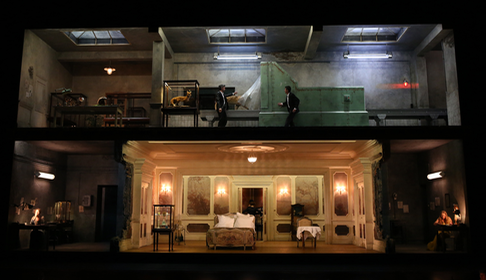 Scenery design for the Katie Mitchell production by Chloe Lamford
Scenery design for the Katie Mitchell production by Chloe Lamford
All Alcina photos copyright Patrick Berger, courtesy of the Aix Festival
Though when passing from that magical room into their taxidermy workshops both witches become old hags.
Upstairs (surely the Aix Festival recycled Katie Mitchell’s Written on Skin production) was the machinery that transformed men into beasts. Indeed we watched as Astolfo (mute presence) was conveyor-belted into the transformer to emerge as a magnificent stuffed mountain lion. Meanwhile Astolfo’s son, Oberto, a real 12 year-old boy soprano arrived searching for his father. Oberto has two sizable arias (artfully delivered by either Elias Mädler or Lionel Wunsch according to the program booklet). He was carrying a stuffed teddy bear and was carefully ushered from the room when the sex got intense.
After being passively raped by Alcina male soprano Philippe Jaroussky as Ruggiero allowed himself to be meticulously cleaned up by four household maids in efficiently prim black dresses even though one was male. Ruggiero’s fiancé Riccardo was taller and obviously stronger than he and had a real female voice though it was much lower and stronger than his voice. Melisso, the only real male voice on the stage, Polish bass Krzysztof Baczyk (we exclude Oronte because he is a lovesick tenor), meticulously combed Ruggiero’s hair to refresh his masculinity.
Mr. Jaroussky always did seem a bit bewildered, and he did sing more than any of the other characters as well, his lyric soprano voice needing more strength than it could possibly muster, often confusing itself with the same colors as the voices of real female lyric sopranos. The lovesick tenor Oronte, British tenor Anthony Gregory was a willing captive of Morgana who lovingly whipped her during her brilliant Act III aria only to know that he will lose her in his meltingly beautiful aria “un momento di contento.”
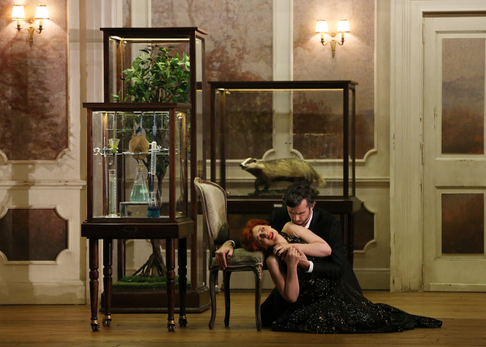 Patricia Petibon as Alcina, Anthony Gregory as Oronte
Patricia Petibon as Alcina, Anthony Gregory as Oronte
It was magical, completely magical, made magnificent by Patricia Petibon as the ravishing, red haired Alcina, whose “Ah mio cor” included a high E shriek and then ended the first part of the evening. The audience was left stunned and remained in their seats to give an extended ovation to the fallen curtain. She began the second part with her “Ombre palide” and ended the opera with the spectacular “Mi restano le lagrime,” emotionally emptied in maximum eloquence supported by the heartbroken Oronte, dragging her body across the stage in a succession of beautifully choreographed poses. It was wrenching.
When this wonderfully teasing, titillating magical world was destroyed and the fantasy of two old spinster sisters evaporated, we grieved. The sisters were then placed in the glass case sarcophagi that had held the captive males of their most secret lives. It was a moving end.
And we did not give a damn that Bradamante and Ruggiero were now free to continue their fight to save Europe from Islam.
P.S. The Freiburger Barockorchester was once again mighty, Italian conductor Andrea Marcon honestly provided all the bite and drama necessary to amplify Handel’s splendid drama as envisioned by Mme. Mitchell. It was thrilling indeed when the horns cut loose at the end. The two theorbo players, Daniele Ciminiti and Maria Ferré sat just under center stage, pouring their hearts out in the arias.
Michael Milenski
Entführung: Selim Bassa: Tobias Moretti; Konstanze: Jane Archibald; Blonde: Rachele Gilmore; Belmonte: Daniel Behle; Pedrillo: David Portillo; Osmin: Franz-Josef Selig. Chœur: MusicAeterna (Chœur de l'Opéra de Perm); Orchestre: Freiburger Barockorchester. Conductor: Jérémie Rhorer; Mise en scène: Martin Kušej; Décors: Annette Murschetz; Costumes: Heide Kastler; Lumière: Reinhard Traub; Dramaturgie: Albert Ostermaier. Théâtre de l’Archevêché, July 3, 2015.
Alcina: Patricia Petibon; Ruggiero: Philippe Jaroussky; Morgana: Anna Prohaska; Bradamante: Katarina Bradić; Oronte: Anthony Gregory; Melisso: Krzysztof Baczyk; Oberto: Elias Mädler or Lionel Wunsch (membres du Tölzer Knabenchor). Chœur: MusicAeterna (Chœur de l'Opéra de Perm); Orchestre: Freiburger Barockorchester. Conductor: Andrea Marcon; Mise en scène: Katie Mitchell; Décors: Chloe Lamford; Costumes: Laura Hopkins; Lumière: James Farncombe. Grand Théâtre de Provence, Aix-en-Provence, July 4, 2015.
image=http://www.operatoday.com/Alcina_Aix1.png
image_description=Photo by Christian Dresse courtesy of the Opéra de Marseille
product=yes
product_title=Entführung and Alcina in Aix-en-Provence
product_by=A review by Michael Milenski
product_id=Above: Patricia Petibon as Alcina. All Alcina photos copyright Patrick Berger, courtesy of the Aix Festival.
July 6, 2015
O/MODƏRNT: Monteverdi in Historical Counterpoint
Beginning in 2011 with ‘reflections on’, ‘homages to’, and ‘meditations with’ J.S. Bach, the festival has subsequently explored the work of Purcell and Rameau, among others, and in June this year turned its attention to the Scarlatti père and frère.
In 2012, it was Monteverdi with whom contemporary musicians, scholars and dancers conversed. And, it was concerts and concepts from that 2012 programme (including ‘Monteverdi to Tango’, ‘Orpheus Goes Postmodern’ and ‘On the Limits of Tonality: Monteverdi meets Schoenberg’) which Ticciati brought to the Wigmore Hall, for a weekend of performances and discussion. In this final concert, entitled ‘Voices from Afar’, Ticciati was joined by cellist Leonard Elshenbroich and the singers of VOCES8. With Monteverdi’s sestina ‘Tears of a lover at the tomb of the beloved’ (from his Sixth Book of Madrigals) establishing the context, the musicians presented four modern works — by Arvo Pärt, John Tavener and Pēteris Vasks — which made a persuasive argument for the ways in which the past continues to be an inspiration for the present.
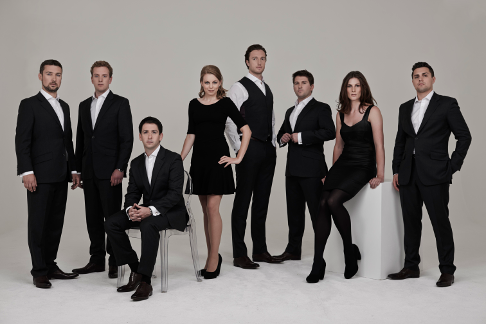 VOCES8
VOCES8
The rhythmic simplicity and unadorned vocal lines of Arvo Pärt’s Magnificat might be considered more ‘medieval’ than ‘Monteverdian’ although, in keeping with Renaissance theories relating to the dominance of word over music, the rhythm is provided solely by the text. Here the syllables of the Latin text were gently and evenly enunciated conveying tender devotion; the homophonic textures were perfectly melded and changes of dynamic unanimous.
The vocalists showed a sound appreciation of Pärt’s compositional practice and a firm command of the vocal techniques and control necessary to serve the music’s spirituality. In the opening bars, the calm interweaving of medieval polyphony is given a modern twist, as the entwining voices are of the same register. Here, around the first soprano’s C-natural drone, the second soprano voice moved freely; the intonation was sure, creating pungent, short-lived dissonances which established the work’ simple austerity. And, these two- and three-voice interactions, both in close proximity and set at more widely spaced remove — as when bass meandered while high above the soprano sustained a drone — served, paradoxically, to create a powerful sense of movement within the overall stillness.
In the passages of tintinnabuli, the long notes were impressively sustained, with no loss of tone; intervals were pure and the phrases were unhurried. The extended, fluid lines with their repeating melodic fragments were naturally elongated at the phrase-ends: there was no feeling of cadence, just infinite suspension; not exactly timelessness, rather the extension of time beyond arbitrary measure.
In contrast, in Pärt’s Dopo la vittoria the spiritual reverence and serenity was replaced by narrative movement and a light energy which was almost madrigalian. The text is an Italian translation of an account in the encyclopaedia ‘A Historical Survey of Ecclesiastical Singers and Songs’, written in Russian, of the story of St. Ambrose baptizing St Augustine; during this baptism, Ambrose begins to see the ‘Te Deum’ and is joined by Augustine, so establishing the chant as it has been known ever since. In the central, more tranquil episode there was some wonderfully focused singing from the lower voices, in the parallel writing for tenor and bass. VOCES8 gave brightness and emphasis to the statements of the words of praise — first, ‘Te Deum laudamus’, then the Italian equivalent, ‘Lodiamo Te o Signore’,, and finally text from the end of the Te Deum, ‘In Te, o Signore, ho posto la mia’ — creating, especially in the magnificently resounding, uplifting ‘Amen’, a mood of impulsive elation and sincerity.
There is no text in Pēteris Vasks’s Plainscapes, a vocalise for mixed voices, violin and cello, which depicts the unending plains and sky of Latvia during a dark, cold winter, into which sparseness bird-song emerges. VOCES8 formed a soft, wordless accompaniment for Ticciati’s opening motifs, which began with an imperceptible, stratospherically-high pitch which fell in register, gradually gaining form and weight, and which evolved in partnership with the cello into strong, searching string lines, intense and rich instrumental explorations between the vocal strophes. Ticciati and cellist Leonard Elschenbroich adopted an uncompromising approach, imploring and challenging the ears and attentiveness of their listeners — and their vocal accompanists. Elschenbroich plays a cello made in Venice in 1693 by Matteo Goffriller, and he makes his instrument sing with heart-moving expressiveness. But here, while the initial serenity was superseded by a growing restlessness, the dynamic volume remained subdued, the inner energy of the cello’s climbing phrases always contained. I was impressed too by the way that Ticciati moved to and from the foreground, always aware of his role within the whole, while ensuring that the harmonics, pizzicato and glissandi spoke clearly. Having established a mood of ethereal abstraction, VOCES8 then imitated bird-song, employing glissandos, stuttering sounds and noises, and vocal colours to evoke Nature’s song. This was a fearless performance of a striking work.
John Tavener’s Svyati sets a Church Slavonic text from the Russian Orthodox service, a text which the composer explained is sung ‘after the congregation have kissed the body in an open coffin at an Orthodox funeral’. The cello represents the Priest or Ikon of Christ, and Tavener instructs that the cellist should be spatially separated from the choir: and so Elschenbroich was a lone figure on the platform, the singers of VOCES8 standing in the gallery at the rear of the Wigmore Hall.
The distance between choir and ‘priest’ did, however, occasionally impact upon the immediacy and intensity of the dialogue between them. For while the basses’ drone was deep and true, evoking the eternal truths of plainchant and also conveying a throbbing melancholy, some of the choral statements of the prayer for mercy seemed somewhat detached and did not blossom with sufficient warmth or grandeur. But, Elschenbroich’s reverential song was utterly transfixing, encompassing an astonishing range of expression, the lines spun out in impossibly long threads. The cellist was totally immersed in the aching tensions of the music, and the closing moments were spell-binding.
The concert began with Monteverdi’s ‘Lagrima d’amante al sepolcro dell’amata’ (Tears of the lover at the tomb of the beloved). The Sixth Book of Madrigals comprises songs of mourning and loss, with the five-part sestina — a lament for ‘the little Roman girl’ (‘Signora Romanina’ thought to be the singer Caterina Martinelli, for whom the title role of Arianna was written) — forming the central item of the collection. VOCES8 attentively explored the evolving sentiments of the text, as depicted in the emotive madrigalisms and dissonances, and the changing vocal textures: at times the voices sank low and moved as one sombre unit, elsewhere the individual strands wound around one another, as if in tortured debate. Occasionally, as the vibrato in the upper voices broadened as the dynamics or tessitura rose, the precision of the tuning was affected. This was quite a ‘theatrical’ rendition, the sound resonant and vivacious, and — uncharacteristic of the evening — I was not entirely convinced that the five singers had captured the song’s spiritual solemnity.
But, the musical offerings which followed were characterised by brave and inspired musicianship. In this regard, Ticciati demonstrated his own skill, imagination, and audacity, in the solo improvisations which opened the second half of the concert. The violinist’s playing was by turns extraordinarily vivid, then daringly withdrawn; the eloquence of a lament was gradually transformed, through ornamentation, repetition of fragments, delicate changes of weight, explorations of texture, with Pärt’s Fratres an obvious inspiration. Ticciati’s absorbing performance was emblematic of the arresting nature of all the music performed during the evening, and of the musicians’ unwavering commitment and ability to communicate the music’s genuine spirituality.
Claire Seymour
Programme and performers:
Claudio Monteverdi — Sestina: ‘Lagrima d’amante al sepolcro dell’amata’, Arvo Pärt — Magnificat, Pēteris Vasks — Plainscapes, Arvo Pärt — Dopo la Vittoria, John Tavener — Svyati.
Hugo Ticciati (violin), Leonard Elschenbroich (cello) and VOCES8. Wigmore Hall, London, Sunday 5th July 2015.
image=http://www.operatoday.com/Hugo%20Ticiatti002.png image_description=Hugo Ticciati [Photo by Marco Borggreve] product=yes product_title=O/MODƏRNT: Monteverdi in Historical Counterpoint product_by=A review by Claire Seymour product_id=Above: Hugo Ticciati [Photo by Marco Borggreve]July 5, 2015
Late Schumann in context — Matthias Goerne and Menahem Pressler, London
Goerne programmes are always imaginative, bringing out new perspectives, enhancing our appreciation of the depth and intelligence that makes Lieder such a rewarding experience. Menahem Pressler is extremely experienced as a soloist and chamber musician, but hasn't really ventured into song to the extent that other pianists, like Brendel, Eschenbach or Richter, for starters. He's not the first name that springs to mind as Lieder accompanist. Therein lay the pleasure !
Goerne and Pressler walked onto the Wigmore Hall platform arm in arm, because Pressler, at 91 years of age, needs a bit of support to walk. But there was no mistaking the warmth of their relationship. Although they’d planned to end their recital with Schumann Dichterliebe op 48, they made a last-minute decision to place it first, for reasons that became clear later.
Dichterliebe was Schumann’s gift of love to Clara, celebrating their marriage after years of opposition, which included civil litigation against her father. Hardly a “normal” courtship. It’s hardly surprising that music poured out of Schumann in a torrent of excited ecstasy. This Dichterliebe was decidedly individual. The pace was brisk, the songs flowing into each other, highlighting the sudden, extreme swings of mood from one song to another almost colliding. Die Rose, die Lilie, die Taube felt almost manic. Goerne’s voice is flexible enough that the words tumbled out effortlessly even though the pace suggested tongue twister: “Die kleine, die Feine, die Reine die Eine”. On paper, Heine;’s poems are impressive, but Schumann’s settings add a filter which is highly individual, and not comfortable. They are big “R” Romantic, rather than coy, little “r” romantic. There’s a huge difference.
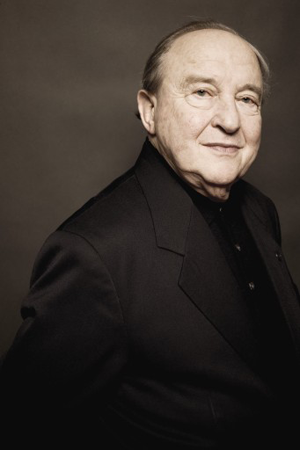 Menahem Pressler
Menahem Pressler
Goerne’s Ich grolle nicht chilled the heart. “I bear no grudge” the text insists, but Goerne’s growl in the word “grolle” grates with menace. The “s” and “z” sound in the phrase “und sahe die Schlang’, die dir am Herzen frißt.” bit with venom. It’s ironic that so many of the songs in this garland of love deal with grief and loss, the “dream” songs the most unsettling of all, with their intuitive grasp of subconscious forces. Pressler’s approach was unorthodox, but psychologically astute. Most Lieder fans have heard so many Dichterliebes in the past that this very singular interpretation was much more interesting than something safe or standard.
Picking up on the theme of dreams in Dichterliebe Pressler then played Schumann’s Variations on a theme in E flat WoO 24, the Geister Variations” (1854) Written a week before Schumannn tried to drown himself in the Rhine, the variations are based on a theme he had dreamed about, telling Clara that he’d heard it sung by angels, and telling a friend that it had been sent to him by Schubert. One thinks of the half-forgotten dream in Allnächtlich im Traume in Dichterliebe, with its phrase “....und’s Wort hab’ich vergessen”. The sombre hymn-like mood reflects that of Im Rhein, im heiligen Strome from Dichterliebe. Heine’s text links the image of the Virgin Mary with the idea of the poet’s lover. But Schumann’s setting is inexplicably dark and ponderous, describing the waves of the river as ominous forces. In the context of what was happening to Schumann when he wrote the Variations, the hypnotic pull of the waves in the song is chilling.
This theme of delusional grandeur also puts Schumann’s op 89 (1850), settings of poems by Wilfried von der Neun, “Wilfred of The Nine”, meaning the nine muses, no less. This was the glorified pseudonym, allegedly adopted in his early youth by Friedrich Wilhelm Traugott Schöpff (1826-1916) who made a living as a pastor in rural Saxony. The poems are pretty banal, far lower than the standards Schumann would have revered in his prime. However, bad poetry is no bar, per se, to music. As Eric Sams wrote “the inward and elated moods of the previous year mingle blur together in the new chromatic style in the absence of diatonic contrasts and tensions a new principle is needed. Schumann accordingly invents and applies the principle of thematic change....It is as if he had acquired a new cunning and his mind had lost an old one.”
Sams is the source to go for studying these songs, since he analyses them carefully, drawing connections in particular to Am leuchetenden Sommermorgen and Hör’ ich ein Liedchen klingen in Dichterliebe. Sams said “Schumann’s memory is playing him tricks”. By pairing these songs with the Geister Variations, Goerne and Pressler are making a powerful case for coming to terms with Schumann’s later work. Texts like Es stürmet am Abendhimmel lend themselves to dramatic treatment but it would be wrong to suggest that they should be performed as faux Wagner. Schumann knew very well who Wagner was, but he had his own ideas about musical drama. which we need to respect if we are to fully appreciate his place in music history. Goerne and Pressler know their Schumann well enough to let us hear Schumann as Schumann, without distortion or special pleading. These may not be Schumann’s finest moments, but they’re still authentic and personal. Because this performance was so good, and so sensitive to Schumann’s inner world, we could understand something, perhaps of what Schumann might have been going through in his long last illness. In Ins Freie, the poet cries out “Mir ist’s so eng allüberall!” He imagines he can escape “aus düstrer Mauern bangem Ring “ through songs. But the song ends with the same frustrated cry, which Goerne sang with heartfelt anguish, not play-acting histrionics, but sincere identification with the frustration Schumann might have felt as his mind closed in on him.
Schumann’s Poems of Nikolaus Lenau op 90 (1850) were written in August 1850, barely three months after the von der Neun set, but are altogether more accomplished, since the poetry of Lenau (1802- August 22nd 1850) was on a level to bring out the best in a composer extraordinarily responsive to good literature. The poems Schumann set were published in 1838, so Schumann would have known him as a contemporary and heard of the psychotic attack Lenau suffered in 1844, which led to his being incarcerated in an asylum for the rest of his short life. Promise, cut down too soon: rather uncomfortably close to Schumann’s own situation.
Die Sennin is beautifully lyrical,with lilting harmonies that evoke warm breezes and the freedom of nature. One can almost imagine cow bells. The girl sings so beautifully that even the Felsenseelen (the souls of mountain rocks) echo her song. One day she’ll be gone but her songs live on in the memory of the crags. In Eisamkeit, silence hangs over a forest, Herz (the poet’s) is alone. Pressler plays the circular forms in the piano so they cradle Goerne’s tenderly. “Deine Lieber Gott versteht”
Leaving Schumann’s Requiem which rounds off Op. 90 off the programme worked out well, as it concentrated attention on Dichterliebe and on its connections with the lesser-known late works, and on Schumann’s inner life. In any case, the text is not Lenau. Since the mid 19th century, we’ve learned more about mental illness and can be more understanding. I wish, however, that Goerne and Pressler had done Lied eines Schmeid (Op 90) A little horse never lets the blacksmith down. Its steady trudging rhythm may seem simple, but in its own charming way, it’s a hymn for the faithful. To a horse! In its sincerity, it would have been a happy coda to Goerne and Pressler’s sensitive approach to Schumann’s later years. The concert was being recorded. Goerne and Pressler will repeat it at the Verbier Festival on July 22nd.
Anne Ozorio
image=http://www.operatoday.com/GOERNE_Borggreve006.gif image_description=Matthias Goerne [Photo by Marco Borggreve] product=yes product_title= Robert Schumann, Matthias Goerne and Menahem Pressler, Wigmore Hall, London 2nd July 2015 product_by=A review by Anne Ozorio product_id=Above: Matthias Goerne [Photo by Marco Borggreve]